Sony PM-0590 GSM/WCDMA/LTE mobile phone User Manual Sony Ericsson Mobile Communications AB
Sony Mobile Communications Inc GSM/WCDMA/LTE mobile phone Sony Ericsson Mobile Communications AB
Sony >
Contents
- 1. User Manual
- 2. SAR Leaflet
- 3. HAC Leaflet
- 4. Leaflet SAR
User Manual

User guide
C6916
S
Contents
Getting started..............................................................................6
Overview............................................................................................6
Assembly...........................................................................................7
Starting your device for the first time.................................................8
Why do I need a Google™ account?.................................................9
Charging your device.......................................................................10
Learning the basics....................................................................11
Using the touchscreen.....................................................................11
Locking and unlocking the screen...................................................13
Home screen....................................................................................13
Application screen...........................................................................14
Navigating applications....................................................................15
Small apps.......................................................................................16
Widgets............................................................................................17
Lock screen.....................................................................................18
Shortcuts and folders......................................................................18
Background and themes..................................................................19
Status and notifications...................................................................20
Icons in the status bar.....................................................................20
Application overview........................................................................22
Downloading applications.........................................................24
Downloading applications from Google Play™...............................24
Downloading applications from other sources................................24
Internet and networks................................................................25
Browsing the web............................................................................25
Managing bookmarks......................................................................25
Internet and messaging settings......................................................26
Wi-Fi®..............................................................................................26
Sharing your mobile data connection..............................................28
Controlling data usage.....................................................................29
Selecting mobile networks...............................................................30
Virtual private networks (VPNs)........................................................30
Basic settings.............................................................................32
Accessing settings...........................................................................32
Sound, ringtone and volume............................................................32
Date and time...................................................................................33
X-Reality™ for Mobile......................................................................33
Screen settings................................................................................34
Language settings............................................................................34
2
This is an Internet version of this publication. © Print only for private use.
Airplane mode..................................................................................34
Enhancing the sound output............................................................35
Typing text..................................................................................36
On-screen keyboard........................................................................36
Phonepad.........................................................................................37
Entering text using voice input........................................................38
Editing text.......................................................................................38
Personalising the Xperia keyboard..................................................39
Calling..........................................................................................40
Making calls.....................................................................................40
Receiving calls.................................................................................41
Ongoing calls...................................................................................41
Using the call log.............................................................................42
Forwarding calls...............................................................................42
Restricting calls................................................................................43
Multiple calls....................................................................................43
Conference calls..............................................................................43
Voicemail..........................................................................................44
Visual Voicemail...............................................................................44
Emergency calls...............................................................................44
Wi-Fi Calling.....................................................................................45
Contacts......................................................................................46
Transferring contacts.......................................................................46
Searching and viewing contacts......................................................47
Adding and editing contacts............................................................48
Favourites and groups.....................................................................49
Sending contact information............................................................49
Avoiding duplicate entries in the Contacts application...................49
Backing up contacts........................................................................50
Messaging and chat...................................................................51
Reading and sending messages......................................................51
Organising your messages..............................................................52
Calling from a message...................................................................53
Messaging settings..........................................................................53
Instant messaging and video chat...................................................53
Email............................................................................................55
Setting up email...............................................................................55
Sending and receiving email messages..........................................55
Email preview pane..........................................................................57
Organising your email messages.....................................................57
Email account settings.....................................................................58
Gmail™............................................................................................58
3
This is an Internet version of this publication. © Print only for private use.
Socialife™...................................................................................60
Using the Socialife™ application.....................................................60
Music...........................................................................................61
Transferring music to your device...................................................61
Listening to music............................................................................61
WALKMAN home screen ................................................................62
Playlists............................................................................................63
Sharing music..................................................................................64
Enhancing the sound.......................................................................65
Visualiser .........................................................................................65
Recognising music with TrackID™..................................................65
Music Unlimited online service........................................................67
FM radio......................................................................................68
Listening to the radio.......................................................................68
Favourite radio channels..................................................................69
Sound settings.................................................................................69
Camera........................................................................................70
Taking photos and recording videos...............................................70
Face detection.................................................................................71
Using Smile Shutter™ to capture smiling faces..............................71
Adding the geographical position to your photos...........................72
General camera settings..................................................................72
Still camera settings.........................................................................74
Video camera settings.....................................................................77
Album..........................................................................................79
Viewing photos and videos..............................................................79
Sharing and managing photos and videos......................................80
Editing photos with the Photo editor application.............................81
Photo albums...................................................................................82
Viewing your photos on a map........................................................83
Videos..........................................................................................85
Watching videos in the Movies application.....................................85
Transferring video content to your device.......................................86
Managing video content..................................................................87
Video Unlimited service...................................................................87
Connectivity................................................................................88
Sharing content with DLNA Certified™ devices..............................88
NFC..................................................................................................90
Bluetooth® wireless technology......................................................92
Connecting your device to a computer...........................................95
Connecting your device to a TV set using a cable..........................98
Screen mirroring..............................................................................98
4
This is an Internet version of this publication. © Print only for private use.
Using a headset ..............................................................................99
Smart Connect.................................................................................99
Synchronising data on your device........................................101
About synchronising data on your device.....................................101
Synchronising with Google™ services..........................................101
Synchronising with Microsoft® Exchange ActiveSync®...............101
Synchronising with Facebook™....................................................102
Maps and locations..................................................................104
Location services and sources......................................................104
Using GPS.....................................................................................104
Google Maps™..............................................................................105
Getting directions...........................................................................105
Calendar and alarm clock.......................................................107
Calendar.........................................................................................107
Alarm clock....................................................................................107
Locking and protecting your device.......................................110
IMEI number...................................................................................110
SIM card protection.......................................................................110
Setting a screen lock.....................................................................110
Support and maintenance.......................................................113
Updating your device.....................................................................113
Finding your device........................................................................114
Memory..........................................................................................114
Backup and restore application.....................................................115
Resetting and restarting.................................................................117
Battery and power management...................................................117
Hearing Aid Compatibility..............................................................119
Support application.......................................................................120
TTY.................................................................................................120
Accessories....................................................................................120
Usage info......................................................................................120
Recycling your device....................................................................120
Important information..............................................................122
Important information leaflet..........................................................122
Limitations to services and features..............................................122
Protecting your device from water and dust.................................122
Legal information...........................................................................124
5
This is an Internet version of this publication. © Print only for private use.

Getting started
Overview
6
This is an Internet version of this publication. © Print only for private use.
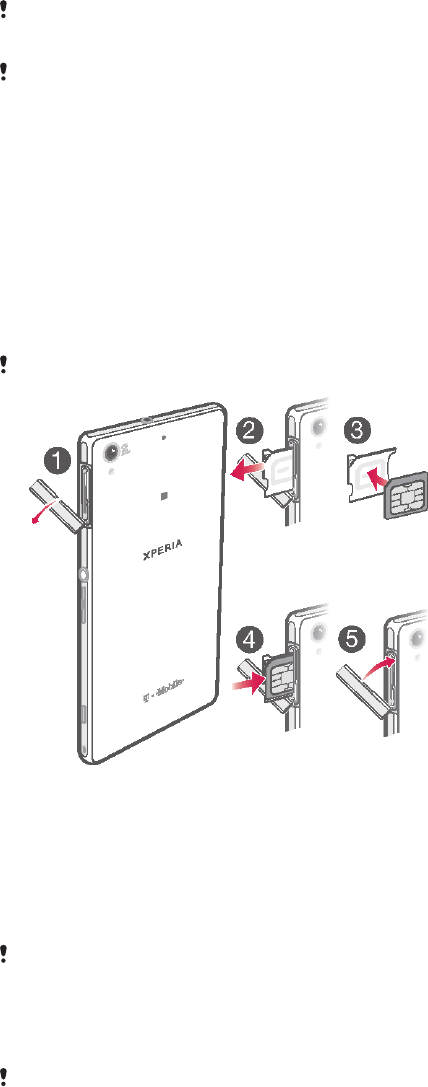
1. Front camera lens
2. Ear receiver
3. Headset jack
4. Proximity sensor/Light sensor
5 Charging light/Notification light
6. Micro SIM card slot cover
7. Power key
8. Volume/Zoom key
9. Camera key
10. Strap hole
11. Main speaker and microphone
12. Main camera lens
13. Camera light
14. Second microphone
15. NFC™ detection area
16. Charger/USB cable port cover
17. Memory card slot cover
18. Charging dock connector
Do not insert fingers or other objects into the opening for the second microphone (illustrated in
item 14 above) to avoid damaging your device.
Use the accessories provided with your device, or other compatible accessories for optimal
performance.
Assembly
If you are new to T-Mobile, please use the SIM card included in the box. If you are an
existing T-Mobile customer, please ask a retail store representative to help you
transfer your information to the new SIM card included in the box. This new card will
allow you to upgrade your device so you can use the Wi-Fi calling feature and ISIS
Mobile Wallet features.
To insert the micro SIM card
Do not insert a memory card into the micro SIM card slot.
1Insert a fingernail into the gap between the micro SIM card slot cover and the
device, then detach the cover.
2Using a fingernail, pull out the micro SIM card holder.
3Place the micro SIM card on the holder, with the gold-coloured contacts on the
micro SIM card facing up.
4Insert the micro SIM card holder back into the device.
5Re-attach the micro SIM card slot cover.
Inserting the micro SIM card into the device without the SIM card holder could damage your
micro SIM card or your device, and Sony Mobile does not warrant and will not be responsible
for any damage caused by such action.
To insert the memory card
Do not insert the memory card into the micro SIM card slot.
7
This is an Internet version of this publication. © Print only for private use.

1Insert a fingernail into the gap between the memory card cover and the device,
then detach the memory card cover.
2Place the memory card in the memory card slot, with the gold-coloured
contacts facing towards you, then push the memory card all the way into the
slot until you hear a locking sound.
3Re-attach the memory card cover.
A memory card may not be included at purchase in all markets.
To remove the micro SIM card
1Remove the cover of the micro SIM card slot.
2Pull out the micro SIM card holder.
3Remove the micro SIM card.
4Insert the micro SIM card holder back into its slot.
5Re-attach the micro SIM card slot cover.
To remove the memory card
1Turn off the device, or unmount the memory card from Settings > Storage >
Unmount SD card.
2Remove the cover of the memory card slot, then press against the edge of the
memory card and release it.
3Draw the card outwards to remove it fully.
Starting your device for the first time
The first time you start your device, a setup guide opens to help you configure basic
settings, sign in to some accounts, and personalise your device. For example, if you
have a Sony Entertainment Network account, you can sign in to it here and get set up
straight away. And you can download Internet and Wi-Fi® settings.
You can also access the setup guide later from the Settings menu.
8
This is an Internet version of this publication. © Print only for private use.
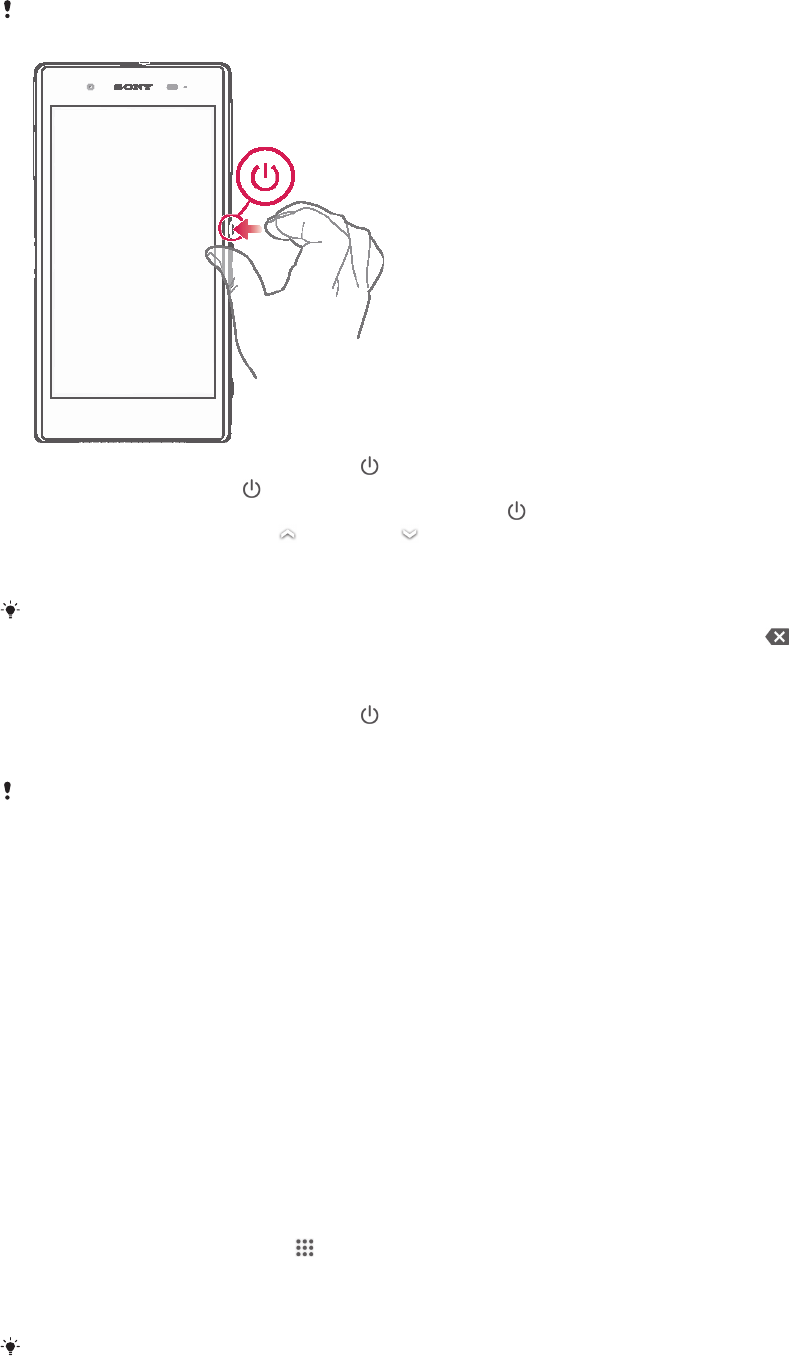
To turn on the device
Before you turn on the device for the first time, charge the battery completely by using the
inbox charger until the notification light turns green.
1Press and hold down the power key until the device vibrates.
2Release the power key when the device vibrates.
3If your screen goes dark, briefly press the power key to activate the screen.
4To unlock the screen, drag up or drag down.
5Enter your SIM card PIN when requested, then select OK.
6Wait a few seconds for the device to start.
Your SIM card PIN is initially supplied by your network operator, but you can change it later
from the Settings menu. To correct a mistake made while entering your SIM card PIN, tap .
To turn off the device
1Press and hold down the power key until the options menu opens.
2In the options menu, tap Power off.
3Tap OK.
It may take a while for the device to shut down.
Why do I need a Google™ account?
Your Xperia® device from Sony runs on the Android™ platform developed by
Google™. A range of Google™ applications and services are available on your device
when you purchase it, for example, Gmail™, Google Maps™, YouTube™ and Google
Play™, the online store for downloading Android™ applications. To get the most out
of these services, you need a Google™ account. For example, a Google™ account is
mandatory if you want to:
•Download and install applications from Google Play™.
•Synchronise email, contacts and the calendar.
•Chat with friends using the Hangouts™ application.
•Synchronise your browsing history and bookmarks.
For more information about Android™ and Google™, go to
www.sonymobile.com/support
.
To set up a Google™ account on your device
1From your Home screen, tap .
2Find and tap Settings > Add account > Google.
3Follow the registration wizard to create a Google™ account, or sign in if you
already have an account.
You can also sign in to or create a Google™ account from the setup guide the first time you
start your device. Or you can go online and create an account at
www.google.com/accounts
.
9
This is an Internet version of this publication. © Print only for private use.
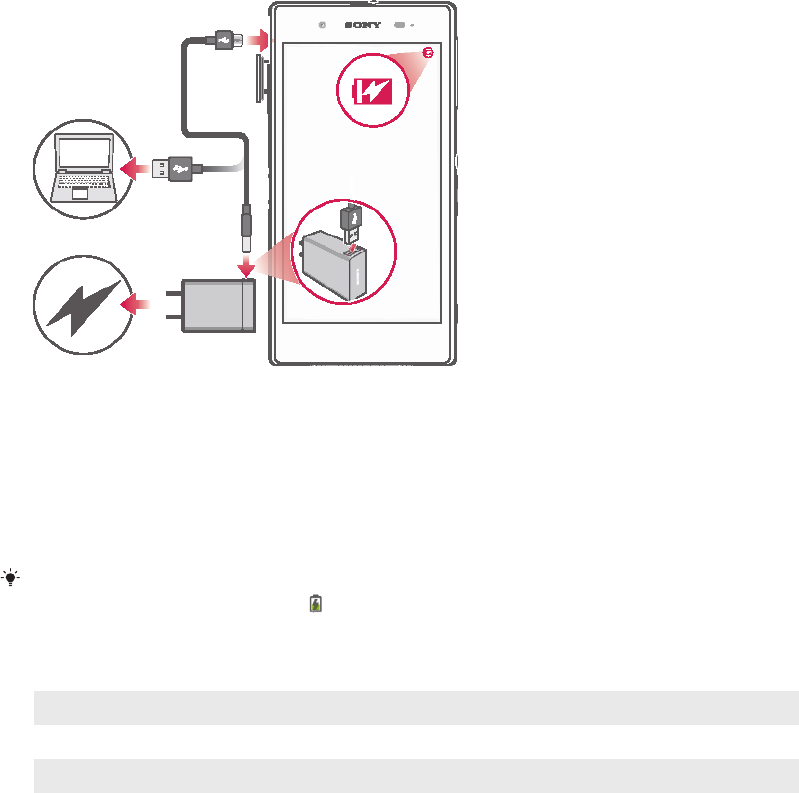
Charging your device
The battery is partly charged when you buy the device. You can still use your device
while it is charging. Read more about the battery and how to improve the
performance in
Battery and power management
on page 117.
To charge your device
1Plug the charger into a power outlet.
2Plug one end of the USB cable into the charger (or into the USB port of a
computer).
3Plug the other end of the cable into the micro USB port on your device, with
the USB symbol facing up. The notification light illuminates when charging
begins.
4When the device is fully charged, disconnect the cable from your device by
pulling it straight outwards. Make sure not to bend the connector.
If the battery is completely discharged, it may take a few minutes before the notification light
illuminates and the charging icon appears.
Battery notification light status
Green The battery charge level is greater than 90%
Flashing red The battery level is low
Orange The battery is charging and the battery charge level is less than 90%
10
This is an Internet version of this publication. © Print only for private use.

Learning the basics
Using the touchscreen
Tapping
•Open or select an item.
•Mark or unmark a checkbox or option.
•Enter text using the on-screen keyboard.
Touching and holding
•Move an item.
•Activate an item-specific menu.
•Activate selection mode, for example, to select several items from a list.
11
This is an Internet version of this publication. © Print only for private use.
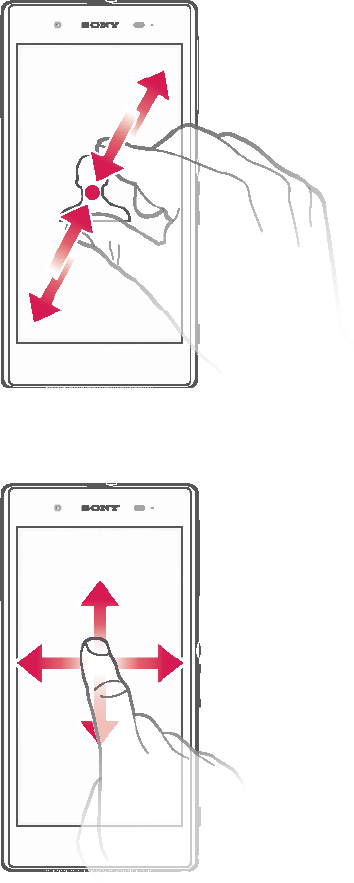
Pinching and spreading
•Zoom in or out on a web page, a photo or a map.
Swiping
•Scroll up or down a list.
•Scroll left or right, for example, between Home screen panes.
12
This is an Internet version of this publication. © Print only for private use.
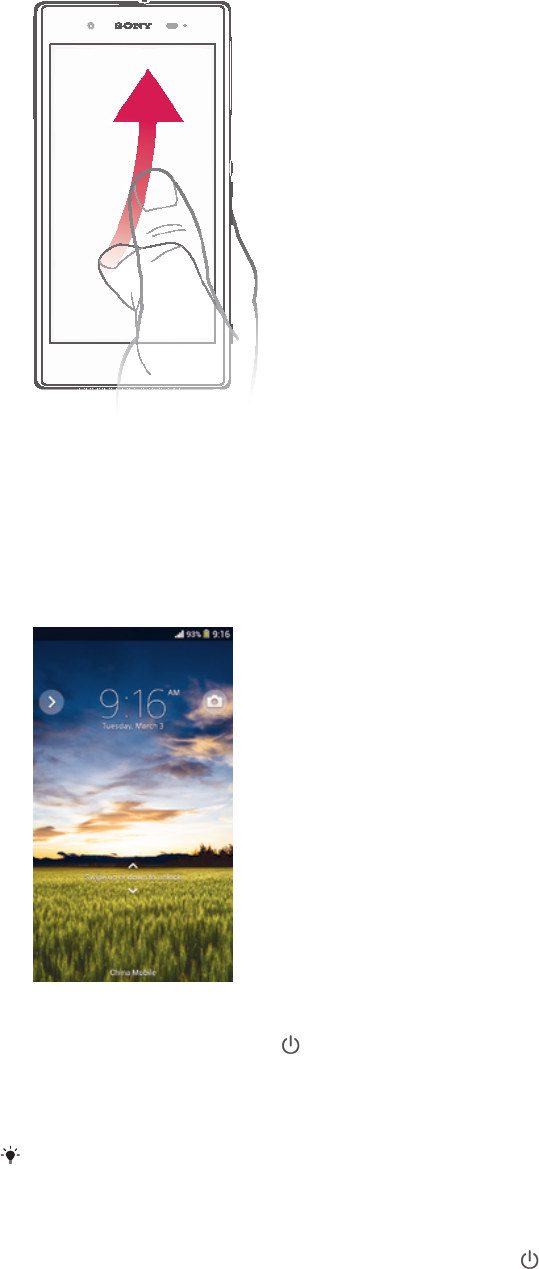
Flicking
•Scroll quickly, for example, in a list or on a web page. You can stop the scrolling
movement by tapping the screen.
Locking and unlocking the screen
When your device is on and left idle for a set period of time, the screen darkens to
save battery power, and locks automatically. This lock prevents unwanted actions on
the touch screen when you are not using it.
To activate the screen
•Briefly press the power key .
To unlock the screen
•Place a finger on the screen and swipe up or down.
There are several ways to unlock the screen. For more information, see
Setting a screen lock
on page 110.
To lock the screen manually
•When the screen is active, briefly press the power key .
Home screen
The Home screen is the starting point for using your device. It's similar to the desktop
on a computer screen. Your Home screen can have up to seven panes, which extend
13
This is an Internet version of this publication. © Print only for private use.
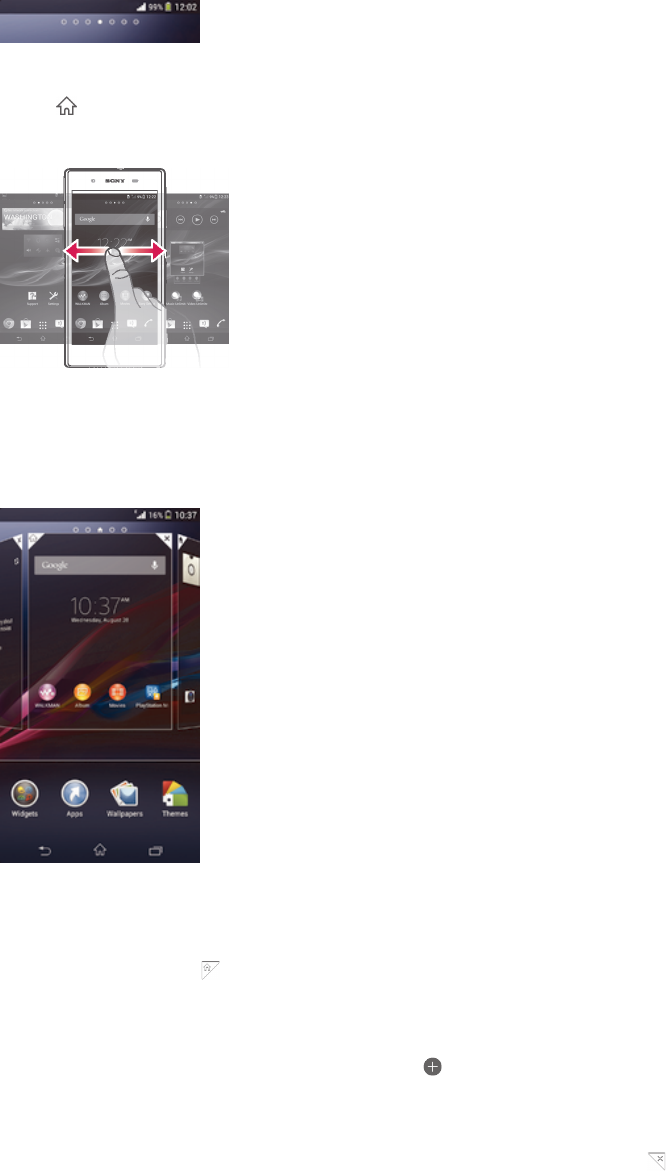
beyond the regular screen display width. The number of Home screen panes is
represented by a series of dots at the top of the Home screen. The highlighted dot
shows the pane that you are currently in.
To go to the Home screen
•Press .
To browse the Home screen
Home screen panes
You can add new panes to your Home screen (up to a maximum of seven panes) and
delete panes. You can also set the pane that you want to use as the main Home
screen pane.
To set a pane as the main Home screen pane
1Touch and hold an empty area on your Home screen until the device vibrates.
2Flick left or right to browse to the pane that you want to set as your main Home
screen pane, then tap .
To add a pane to your Home screen
1Touch and hold an empty area on your Home screen until the device vibrates.
2Flick left or right to browse the panes, then tap .
To delete a pane from your Home screen
1Touch and hold an empty area on your Home screen until the device vibrates.
2Flick left or right to browse to the pane that you want to delete, then tap .
Application screen
The Application screen, which you open from the Home screen, contains the
applications that come pre-installed on your device as well as applications that you
download.
14
This is an Internet version of this publication. © Print only for private use.

To view all applications on the Application screen
1From your Home screen, tap .
2Flick left or right on the Application screen.
To open an application from the Application screen
•Flick left or right to find the application, and then tap the application.
To open the Application screen menu
•When the Application screen is open, drag the left edge of the screen to the
right.
To move an application on the Application screen
1Open the Application screen menu and make sure that Own order is selected
under CATEGORIES.
2Touch and hold the application until it magnifies and the device vibrates, then
drag it to the new location.
To add an application shortcut to the Home screen
1From the Application screen, touch and hold an application icon until the
screen vibrates, then drag the icon to the top of the screen. The Home screen
opens.
2Drag the icon to the desired location on the Home screen, then release your
finger.
To arrange applications on the Application screen
1To open the Application screen menu, drag the left edge of the Application
screen to the right.
2Select the desired option under CATEGORIES.
To uninstall an application from the Application screen
1To open the Application screen menu, drag the left edge of the Application
screen to the right.
2Tap Uninstall. All uninstallable applications are indicated by .
3Tap the application that you want to uninstall, then tap Uninstall.
Navigating applications
You can navigate between applications using the navigation keys, the small apps bar
and the recently used applications window, which lets you switch easily between all
recently used applications. Some applications are closed when you press to exit
while others continue to run in the background or pause. If the application is paused
or runs in the background, you can continue where you left off the next time you
open the application.
15
This is an Internet version of this publication. © Print only for private use.
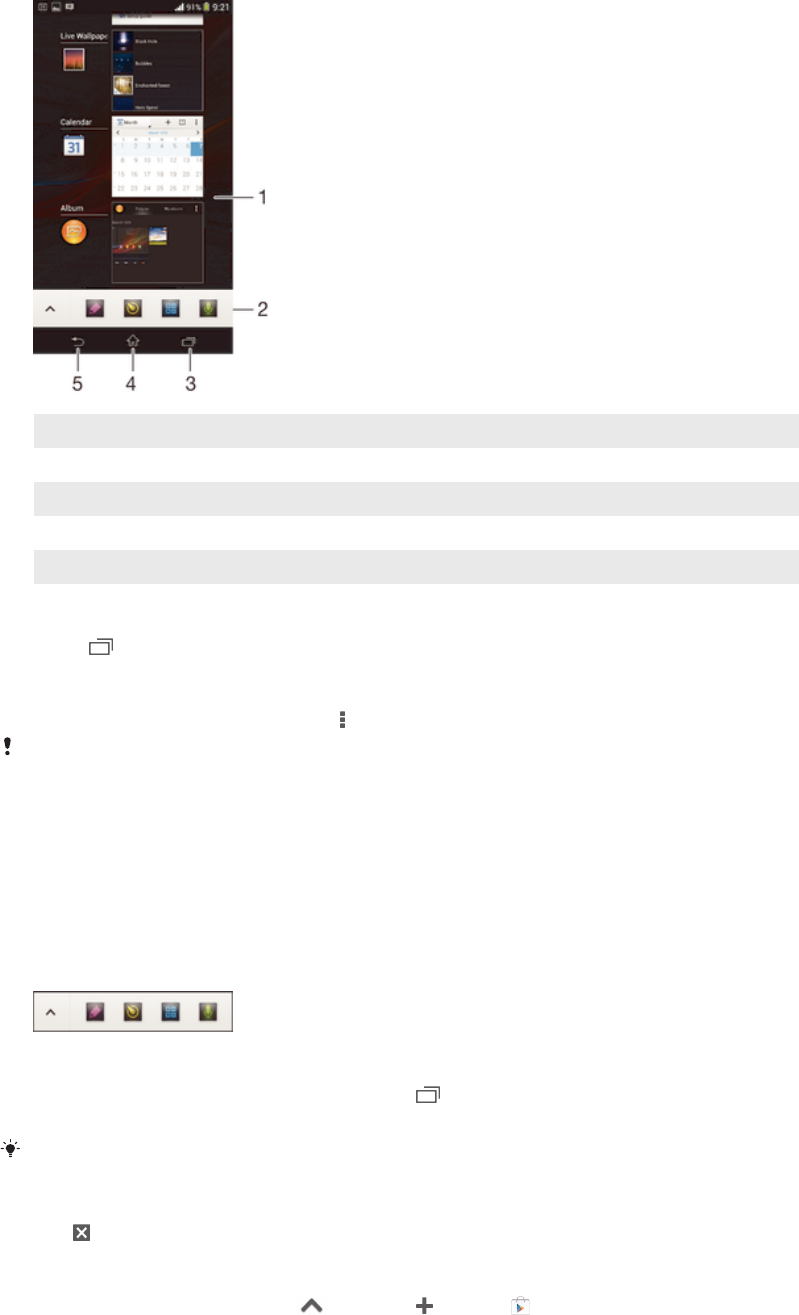
1 Recently used applications window – Open a recently used application
2 Small apps bar – Open a small app
3 Task navigation key – Open the recently used applications window and the small apps bar
4 Home navigation key – Exit an application and go back to the Home screen
5 Back navigation key – Go back to the previous screen within an application or close the application
To open the recently used applications window
•Press .
To open a menu in an application
•While using the application, press .
A menu is not available in all applications.
Small apps
You can get quick access to several small apps at any time using the small apps bar.
A small app only takes up a small area of your screen, so you can interact with a
small app and another application at the same time on the same screen. For
example, you can have a webpage open and then open the Calculator small app on
top of it and perform calculations. You can download more small apps from Google
Play™.
To open a small app
1To make the small apps bar appear, press .
2Tap the small app that you want to open.
You can open several small apps at the same time.
To close a small app
•Tap on the small app window.
To download a small app
1From the small apps bar, tap , then tap and tap .
2Search for the small app that you want to download, then follow the
instructions to download it and complete the installation.
16
This is an Internet version of this publication. © Print only for private use.
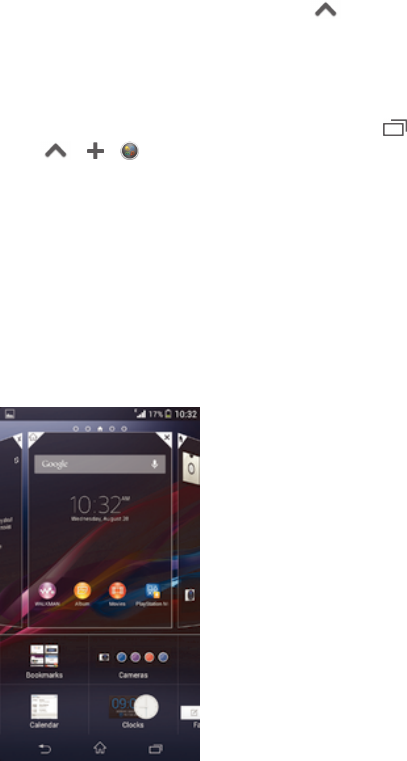
To move a small app
•When the small app is open, touch and hold the top left corner of the small
app, then move it to the desired location.
To minimise a small app
•When the small app is open, touch and hold the top left corner of the small
app, then drag it to the right edge or to the bottom edge of the screen.
To rearrange the small apps in the small apps bar
•Touch and hold a small app and drag it to the desired position.
To remove a small app from the small apps bar
•Touch and hold a small app, then drag it outside of the small apps bar.
To restore a previously removed small app
1Open the small apps bar, then tap .
2Touch and hold the small app that you want to restore, then drag it into the
small apps bar.
To add a widget as a small app
1To make the small apps bar appear, press .
2Tap > > .
3Select a widget.
4Enter a name for the widget, if desired, then tap OK.
Widgets
Widgets are small applications that you can use directly on your Home screen. They
also function as shortcuts. For example, the Weather widget allows you to see basic
weather information directly on your Home screen. But when you tap the widget, the
full Weather application opens. You can download additional widgets from Google
Play™.
To add a widget to the Home screen
1Touch and hold an empty area on your Home screen until the device vibrates,
then tap Widgets.
2Find and tap the widget that you want to add.
To resize a widget
1Touch and hold a widget until it magnifies and the device vibrates, then release
the widget. If the widget can be resized, for example, the Calendar widget,
then a highlighted frame and resizing dots appear.
2Drag the dots inward or outward to shrink or expand the widget.
3To confirm the new size of the widget, tap anywhere on the Home screen.
17
This is an Internet version of this publication. © Print only for private use.

To move a widget on the Home screen
•Touch and hold the widget until it magnifies and the device vibrates, then drag
it to the new location.
To delete a widget from the Home screen
•Touch and hold the widget until it magnifies and the device vibrates, then drag
it to .
Lock screen
The lock screen is the screen that you see when the device is locked but the screen
is active. The lock screen can have up to five panes and you can add one widget to
each pane. You can then access these widgets from the lock screen. For example,
you can add the Calendar widget and an email widget so that you can gain quicker
access to these applications.
The Clock widget is located by default in the middle pane of the lock screen.
To add a widget to the lock screen
1To activate the screen, briefly press the power key .
2Swipe inwards from the top left area of the screen until appears, then tap it.
3If required, enter your PIN code, pattern or password to unlock the screen.
4Find and tap the widget that you want to add.
5Follow the on-screen instructions, if necessary, to finish adding the widget.
To move a widget on the lock screen
1To activate the screen, briefly press the power key .
2Touch and hold the widget that you want to move, then drag it to the new
location.
To remove a widget from the lock screen
1To activate the screen, briefly press the power key .
2Touch and hold the widget that you want to remove, then drag it to .
Shortcuts and folders
Use shortcuts and folders to manage your applications and keep your Home screen
tidy.
1 Access a folder containing applications
2 Access an application using a shortcut
18
This is an Internet version of this publication. © Print only for private use.

To add a shortcut to your Home screen
1Touch and hold an empty area on your Home screen until the device vibrates
and the customisation menu appears.
2In the customisation menu, tap Apps.
3Scroll through the list of applications and select an application. The selected
application gets added to the Home screen.
In step 3, alternatively, you can tap Shortcuts and then select an application from the list
available. If you use this method to add shortcuts, some of the applications available allow
you to add specific functionality to the shortcut.
To move an item on the Home screen
•Touch and hold the item until it magnifies and the device vibrates, then drag
the item to the new location.
To delete an item from the Home screen
•Touch and hold an item until it magnifies and the device vibrates, then drag the
item to .
To create a folder on the Home screen
•Touch and hold an application icon or a shortcut until it magnifies and the
device vibrates, then drag and drop it on top of another application icon or
shortcut.
To add items to a folder on the Home screen
•Touch and hold an item until it magnifies and the device vibrates, then drag the
item to the folder.
To rename a folder on the Home screen
1Tap the folder to open it.
2Tap the folder's title bar to show the Folder name field.
3Enter the new folder name and tap Done.
Background and themes
You can adapt the Home screen to your own style using wallpapers and different
themes. You can also change the wallpaper on the lock screen.
To change your Home screen wallpaper
1Touch and hold an empty area on your Home screen until the device vibrates.
2Tap Wallpapers and select an option.
19
This is an Internet version of this publication. © Print only for private use.
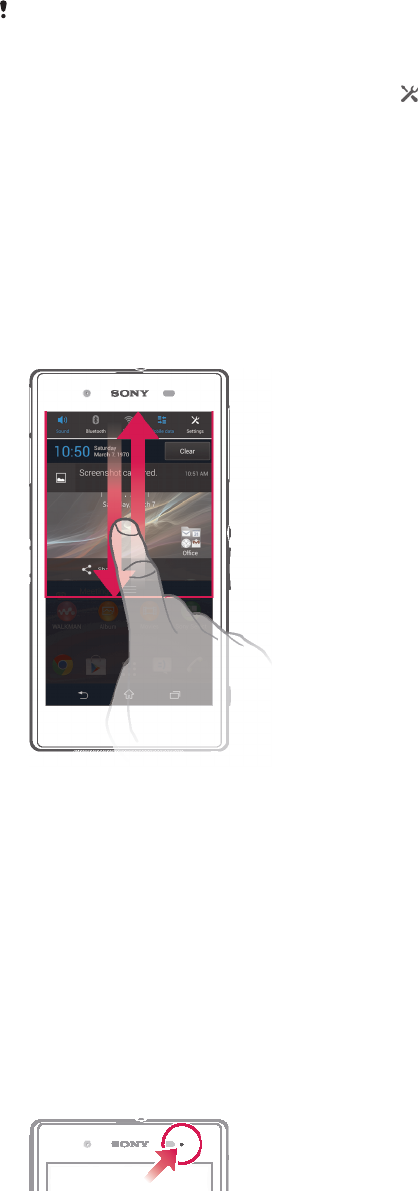
To set a Home screen theme
1Touch and hold an empty area on your Home screen until the device vibrates.
2Tap Themes, then select a theme.
When you change a theme, the background also changes in some applications.
To change the wallpaper for the lock screen
1Drag the status bar downwards, then tap .
2Tap Personalisation > Lock screen.
3Select an option, then follow the instructions to change your wallpaper.
Status and notifications
The icons in the status bar inform you of events such as new messages and calendar
notifications, activities in progress such as file downloads, and status information
such as battery level and signal strength. You can drag down the status bar to open
the Notification panel and handle your notifications.
To open or close the Notification panel
To take action on a notification
•Tap the notification.
To dismiss a notification from the Notification panel
•Place your finger on a notification and flick left or right.
To clear all notifications from the Notification panel
•Tap Clear.
Notification light
A notification light informs you about battery status and some other events. For
example, a flashing blue light means there is a new message or a missed call.
Icons in the status bar
Status icons
The following status icons may appear on your screen:
20
This is an Internet version of this publication. © Print only for private use.

Signal strength
No signal
Roaming
NFC is activated
3G capability
4G capability
4G LTE capability
3G is available
4G is available
4G LTE is available
Sending and downloading 3G data
Sending and downloading 4G data
Sending and downloading 4G LTE data
Downloading 3G data
Downloading 4G data
Downloading 4G LTE data
Sending 3G data
Sending 4G data
Sending 4G LTE data
Wi-Fi calling is available
A call over Wi-Fi is in progress
STAMINA mode is activated
Battery status
The battery is charging
GPS is activated
Airplane mode is activated
The Bluetooth® function is activated
The SIM card is not inserted
The microphone is muted
The speakerphone is on
Silent mode
Vibrate mode
An alarm is set
Synchronisation is ongoing
Problem with sign in or synchronisation
21
This is an Internet version of this publication. © Print only for private use.

A Wi-Fi® connection is enabled and wireless networks are available
Depending on your service provider, network and/or region, the functions or services
represented by some icons in this list may not be available.
Notification icons
The following notification icons may appear on your screen:
New email message
New text message or multimedia message
New voicemail
Upcoming calendar event
A song is playing
The device is connected to a computer via a USB cable
Warning message
Error message
Missed call
Call ongoing
Call on hold
Call forwarding is turned on
Software updates are available
Downloading data
Uploading data
More (undisplayed) notifications
Application overview
Manage your account, find help and learn more about T-Mobile services.
Use the Alarm and Clock application to set various kinds of alarms.
Use your web browser to navigate and view web pages, manage bookmarks,
and manage text and images.
Use the Calculator application to perform basic calculations.
Use the Calendar application to keep track of your events and manage your
appointments.
Use the camera to take photos and record video clips.
Use the Contacts application to manage phone numbers, email addresses
and other information related to your contacts.
Access your downloaded applications.
Use the Email application to send and receive emails through both private
and corporate accounts.
Use the Facebook application to engage in social networking with friends,
family members and colleagues around the world.
22
This is an Internet version of this publication. © Print only for private use.

Browse and listen to FM radio stations.
Use the Album application to view and to work with your photos and videos.
Use the Gmail™ application to read, write and organise email messages.
Search for information in your device and on the web.
View your current location, find other locations, and calculate routes using
Google Maps™.
Go to Google Play™ to download free and paid applications for your device.
Use the Messaging application to send and receive text and multimedia
messages.
Use the Movies application to play movies and other video content saved or
downloaded to your device. Or play your movies on other devices connected
to the same network.
Use the "WALKMAN" application to organise and play music, audio books
and podcasts.
Navigate your way using spoken, turn-by-turn instructions.
View news stories and weather forecasts.
Make phone calls by dialling the number manually or by using the smart dial
function.
Search for places, for example, restaurants and cafés.
Use the Video Unlimited application to rent and purchase videos.
Use the subscription-based Music Unlimited application to access millions of
songs over a mobile data connection or Wi-Fi® connection.
Optimise settings to suit your own requirements.
Use the Hangouts™ application to chat with friends online.
Identify music tracks that you hear playing in your surroundings, and get
artist, album and other info.
Use the Help application to access user support in your device. For example,
you can access a User guide, troubleshooting information, plus tips and
tricks.
Use YouTube™ to share and view videos from around the world.
Download and install new applications and updates.
Some applications are not supported by all networks and/or service providers in all areas.
23
This is an Internet version of this publication. © Print only for private use.

Downloading applications
Downloading applications from Google Play™
Google Play™ is the official online Google store for downloading applications,
games, music, movies and books. It includes both free and paid applications. Before
you start downloading from Google Play™, make sure that you have a working
Internet connection, preferably over Wi-Fi® to limit data traffic charges.
To use Google Play™, you need to have a Google™ account. Google Play™ may not be
available in all countries or regions.
To download an application from Google Play™
1From the Home screen, tap .
2Find and tap Play Store.
3Find an item you wish to download by browsing categories, or by using the
search function.
4Tap the item to view its details, and follow the instructions to complete the
installation.
Some applications may need to access data, settings and various functions on your device in
order to work properly. Only install and give permissions to applications that you trust.
You can view the permissions granted to a downloaded application by tapping the application
under Settings > Apps.
Downloading applications from other sources
When your device is set to allow downloads from sources other than Google Play™,
you can download applications directly from other websites by following the relevant
download instructions.
Installing applications of unknown or unreliable origin can damage your device. Only download
applications from reliable sources. Contact the application provider if you have any questions
or concerns.
To allow the download of applications from other sources
1From your Home screen, tap .
2Find and tap Settings > Security.
3Mark the Unknown sources checkbox.
4Tap OK.
Some applications may need to access data, settings and various functions on your device in
order to work properly. Only install and give permissions to applications you trust.
You can view the permissions granted to a downloaded application by tapping the application
under Settings > Apps.
24
This is an Internet version of this publication. © Print only for private use.
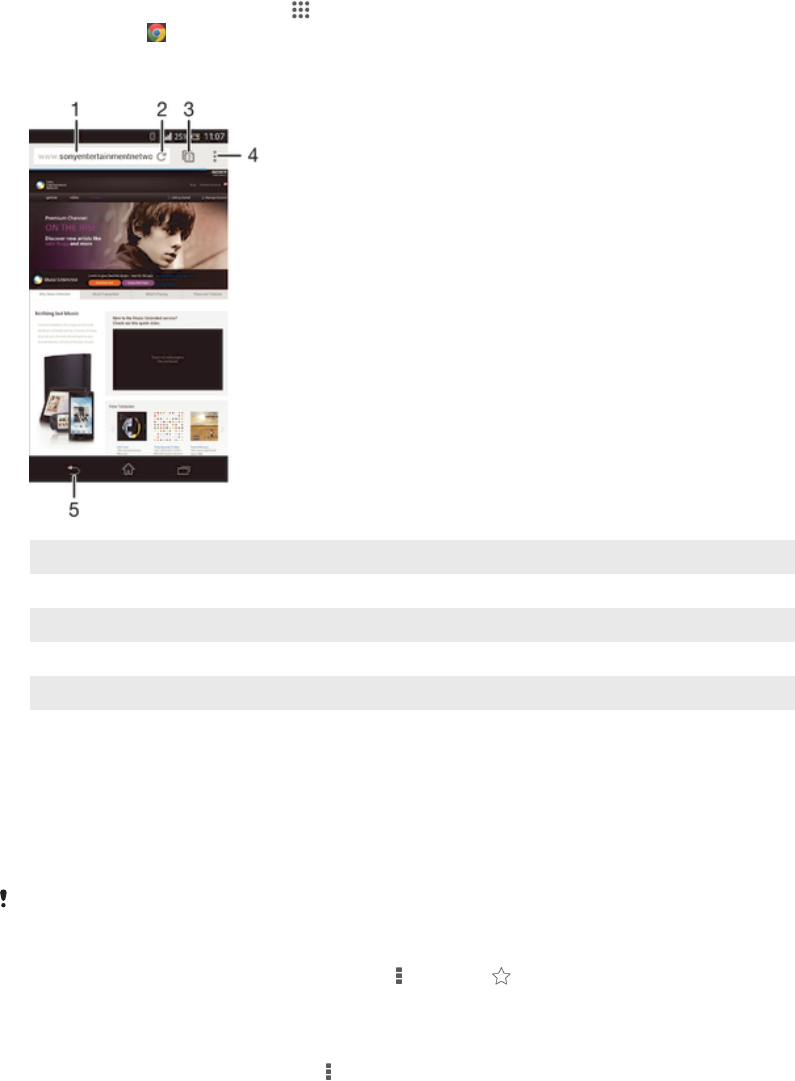
Internet and networks
Browsing the web
The Google Chrome™ web browser for Android™ devices comes pre-installed in
most markets. Go to http://support.google.com/chrome and click the "Chrome for
Mobile" link to get more detailed information about how to use this web browser.
To browse with Google Chrome™
1From your Home screen, tap .
2Find and tap .
3Enter a search term or web address in the search and address field, then tap
Go on the keyboard.
1 Search and address field
2 Refresh the page
3 Access browser tabs
4 View help and options
5 Go back a page in the browser history
Managing bookmarks
Bookmarks let you access your favourite and frequently visited web pages quickly.
You can add bookmarks directly from the browser. You can also synchronise the
browser on your device with Google Chrome™ bookmarks that you have
synchronised to your Google account using a computer.
To bookmark a web page
1While you are viewing the web page, tap , then tap .
2Edit the bookmark, then tap Save.
To open a bookmark
1When a browser tab is open, tap , then tap Bookmarks.
2Navigate the Bookmarks folder and tap the bookmark that you want to open.
25
This is an Internet version of this publication. © Print only for private use.

To edit a bookmark
1When a browser tab is open, tap , then tap Bookmarks.
2Navigate the Bookmarks folder and tap and hold the bookmark that you want
to edit.
3In the pop-up menu, tap Edit bookmark.
4Edit the bookmark, then tap Save.
Pre-installed bookmarks may not be edited.
To add a bookmarked web page to your Home screen
1When a browser tab is open, tap , then tap Bookmarks.
2Navigate the Bookmarks folder and tap and hold the bookmark that you want
to add to your Home screen.
3In the pop-up menu, tap Add to home screen.
To delete a bookmark
1When a browser tab is open, tap , then tap Bookmarks.
2Navigate the Bookmarks folder and tap and hold the bookmark that you want
to delete.
3In the pop-up menu, tap Delete bookmark.
Pre-installed bookmarks may not be deleted.
Internet and messaging settings
To access the Internet and to send multimedia messages, you must have a mobile
data connection and the correct settings, also known as APN (Access Point Name)
settings. The APN identifies the network that a mobile device can connect to.
If you cannot access the Internet, have no data connection, or cannot send or receive
multimedia messages, try deleting all Internet and messaging settings and then add them
again.
To add Internet settings manually
1From the Home screen, tap .
2Find and tap Settings > More… > Mobile networks > Access Point Names.
3Tap .
4Tap New APN.
5Tap Name and enter the name of the network profile that you want to create.
6Tap APN and enter the access point name.
7Enter all other information required by your network operator.
8Tap , then tap Save.
To view the current APN
1From your Home screen, tap .
2Find and tap Settings > More… > Mobile networks.
3Tap Access Point Names.
If you have several available connections, the active network connection is indicated by a
marked button.
To delete all Internet and messaging settings
1Drag the status bar downwards, then tap .
2Tap More… > Mobile networks > Access Point Names.
3Tap .
4Tap Reset to default. All Internet and messaging settings are deleted.
Wi-Fi®
Use Wi-Fi® connections to surf the Internet, download applications, or send and
receive emails. Once you have connected to a Wi-Fi® network, your device
26
This is an Internet version of this publication. © Print only for private use.

remembers the network and automatically connects to it the next time you come
within range.
Some Wi-Fi® networks require you to log in to a web page before you can get
access. Contact the relevant Wi-Fi® network administrator for more information.
The signal strength of Wi-Fi® networks can differ. Moving closer to the Wi-Fi®
access point increases the signal strength.
Available Wi-Fi® networks may be open or secured:
•Open networks are indicated by next to the Wi-Fi® network name.
•Secured networks are indicated by next to the Wi-Fi® network name.
FCC Caution: This device shall only be assigned to FCC approved access point when using 5
GHz WLAN for indoor and outdoor operation. This is because operation in the frequency band
5.15 GHz to 5.25 GHz is only permitted for indoor use.
Some Wi-Fi® networks do not show up in the list of available networks because they do not
broadcast their network name (SSID). If you know the network name, you can add it manually
to your list of available Wi-Fi® networks.
To turn on Wi-Fi®
1From your Home screen, tap .
2Find and tap Settings.
3Drag the slider beside Wi-Fi to the right to turn on the Wi-Fi® function.
It may take a few seconds before Wi-Fi® is enabled.
To connect to a Wi-Fi® network automatically
1Make sure that the Wi-Fi® function is turned on.
2Drag the status bar downwards, then tap .
3Tap Wi-Fi. All available Wi-Fi® networks are displayed.
4Tap a Wi-Fi® network to connect to it. For secured networks, enter the
relevant password. is displayed in the status bar once you are connected.
Tap and then tap Scan to search for new available networks.
To add a Wi-Fi® network manually
1Make sure that the Wi-Fi® function is turned on.
2Drag the status bar downwards, then tap .
3Tap Wi-Fi.
4Tap .
5Enter the Network SSID information.
6To select a security type, tap the Security field.
7If required, enter a password.
8Tap Save.
Contact your Wi-Fi® network administrator to get the Network SSID and password.
Wi-Fi® settings
When you are connected to a Wi-Fi® network or when there are Wi-Fi® networks
available in your vicinity, it is possible to view the status of these networks. You can
also enable your device to notify you whenever an open Wi-Fi® network is detected.
If you are not connected to a Wi-Fi® network, your device uses a mobile data
connection to access the Internet (if you have set up and enabled a mobile data
connection on your device). By adding a Wi-Fi® sleep policy, you can specify when
to switch from Wi-Fi® to mobile data.
27
This is an Internet version of this publication. © Print only for private use.

To enable Wi-Fi® network notifications
1Turn on Wi-Fi®, if it is not already on.
2From your Home screen, tap .
3Find and tap Settings > Wi-Fi.
4Press .
5Tap Advanced.
6Mark the Network notification checkbox.
To view detailed information about a connected Wi-Fi® network
1From the Home screen, tap .
2Find and tap Settings > Wi-Fi.
3Tap the Wi-Fi® network that you are currently connected to. Detailed network
information is displayed.
To add a Wi-Fi® sleep policy
1From the Home screen, tap .
2Find and tap Settings > Wi-Fi.
3Press .
4Tap Advanced.
5Tap Keep Wi-Fi on during sleep.
6Select an option.
Sharing your mobile data connection
You can share your device's mobile data connection with a single computer using a
USB cable. This process is called USB tethering. You can also share your device's
data connection with up to ten other devices at once by turning your device into a
portable Wi-Fi® hotspot. When your device's mobile data connection is successfully
shared, the sharing devices can use your device's data connection, for example, to
surf the Internet, download applications, or send and receive emails.
You may need to prepare your computer to establish a network connection via USB cable. Go
to www.android.com/tether to get the most current information.
To share your data connection using a USB cable
1Deactivate all USB cable connections to your device.
2Using the USB cable that came with your device, connect your device to a
computer.
3Drag the status bar downwards, then tap .
4Tap More… > Tethering & portable hotspot.
5Mark the USB tethering checkbox. is displayed in the status bar once you
are connected.
6To stop sharing your data connection, unmark the USB tethering checkbox or
disconnect the USB cable.
You cannot share your device's data connection and SD card over a USB cable at the same
time.
To use your device as a portable Wi-Fi® hotspot
1Drag the status bar downwards, then tap .
2Tap More… > Tethering & portable hotspot.
3Tap Portable Wi-Fi hotspot settings > Configure Wi-Fi hotspot.
4Enter the Network SSID information.
5To select a security type, tap the Security field. If required, enter a password.
6Tap Save.
7Mark the Portable Wi-Fi hotspot checkbox. is displayed in the status bar
once you are connected.
8To stop sharing your data connection via Wi-Fi®, unmark the Portable Wi-Fi
hotspot checkbox.
28
This is an Internet version of this publication. © Print only for private use.

To rename or secure your portable hotspot
1From the Home screen, tap .
2Find and tap Settings > More… > Tethering & portable hotspot.
3Tap Portable Wi-Fi hotspot settings > Configure Wi-Fi hotspot.
4Enter the Network SSID for the network.
5To select a security type, tap the Security field.
6If required, enter a password.
7Tap Save.
Controlling data usage
You can keep track of the amount of data transferred to and from your device over
your mobile data or Wi-Fi® connection during a given period. For example, you can
view the amount of data used by individual applications. For data transferred over
your mobile data connection, you can also set data usage warnings and limits to
avoid additional charges.
Adjusting data usage settings can help you keep greater control over data usage but cannot
guarantee the prevention of additional charges.
To turn data traffic on or off
1Drag the status bar downwards, then tap .
2Tap Data usage.
3Drag the slider beside Mobile data to turn data traffic on or off.
When data traffic is turned off, your device can still establish Wi-Fi® and Bluetooth®
connections.
To set a data usage warning
1Make sure that data traffic is turned on.
2Drag the status bar downwards, then tap .
3Find and tap Data usage.
4To set the warning level, drag the warning line to the desired value. You receive
a warning notification when the amount of data traffic approaches the level you
set.
To set a data usage limit
1Make sure that data traffic is turned on.
2Drag the status bar downwards, then tap .
3Find and tap Data usage.
4Mark the Set mobile data limit checkbox if it is not marked, then tap OK.
5To set the data usage limit, drag the corresponding line to the desired value.
Once your data usage reaches the set limit, data traffic on your device will be turned off
automatically.
To control the data usage of individual applications
1Drag the status bar downwards, then tap .
2Find and tap Data usage.
3Find and tap the desired application.
4Mark the Restrict background data checkbox.
5To access more specific settings for the application (if available), tap View app
settings and make the desired changes.
The performance of individual applications may be affected if you change the related data
usage settings.
To view data transferred via Wi-Fi®
1From your Home screen, tap .
2Find and tap Settings > Data usage.
3Tap , then mark the Show Wi-Fi usage checkbox if it is not marked.
4Tap the Wi-Fi tab.
29
This is an Internet version of this publication. © Print only for private use.

Data roaming
Some network operators allow you to send and receive mobile data when you are
roaming outside of your home network. It's recommended to check the relevant data
transmission rates in advance.
To activate or deactivate data roaming
1Drag the status bar downwards and tap .
2Tap More… > Mobile networks.
3Mark or unmark the Data roaming checkbox.
You can’t activate data roaming when mobile data has been turned off.
Selecting mobile networks
Your device automatically switches between mobile networks depending on which
mobile networks are available in different areas. You can also manually set your
device to use a particular mobile network mode, for example, WCDMA or GSM.
To select a network mode
1From your Home screen, tap .
2Find and tap Settings > More… > Mobile networks.
3Tap Network Mode.
4Select a network mode.
To select another network manually
1From the Home screen, tap .
2Find and tap Settings > More… > Mobile networks > Network operators.
3Tap Search mode > Manual.
4Select a network.
If you select a network manually, your device will not search for other networks, even if you
move out of range of the manually selected network.
To activate automatic network selection
1Drag the status bar downwards, then tap .
2Find and tap More… > Mobile networks > Network operators.
3Tap Search mode > Automatic.
Virtual private networks (VPNs)
Use your device to connect to virtual private networks (VPNs), which allow you to
access resources inside a secured local network from a public network. For example,
VPN connections are commonly used by corporations and educational institutions for
users who need to access intranets and other internal services when they are outside
of the internal network, for example, when they are travelling.
VPN connections can be set up in many ways, depending on the network. Some
networks may require you to transfer and install a security certificate on your device.
For detailed information on how to set up a connection to your virtual private
network, please contact the network administrator of your company or organisation.
To add a virtual private network
1From your Home screen, tap .
2Find and tap Settings > More… > VPN.
3Tap .
4Select the type of VPN to add.
5Enter your VPN settings.
6Tap Save.
30
This is an Internet version of this publication. © Print only for private use.

To connect to a virtual private network
1From your Home screen, tap .
2Find and tap Settings > More… > VPN.
3In the list of available networks, tap the VPN that you want to connect to.
4Enter the required information.
5Tap Connect.
To disconnect from a virtual private network
1Drag the status bar downwards.
2Tap the notification for the VPN connection to turn it off.
31
This is an Internet version of this publication. © Print only for private use.

Basic settings
Accessing settings
View and change settings for your device from the Settings menu. The Settings menu
is accessible from both the Notification panel and the Application screen.
To open the device settings menu from the Notification panel
1Drag the status bar downwards.
2Tap .
To open the device settings menu from the Application screen
1From your Home screen, tap .
2Tap Settings.
Setting your device from the Notification panel
1 Vibrate mode or Silent mode on/off
2 Bluetooth® on/off
3 Wi-Fi® on/off
4 Adjust brightness level
5 Settings menu
To select quick settings from the Notification panel
1Drag the status bar downwards, then tap .
2Find and tap Personalisation> Quick settings.
3Select the quick settings you want.
To rearrange the quick settings from the Notification panel
1Drag the status bar downwards, then tap .
2Find and tap Personalisation> Quick settings.
3Touch and hold beside a quick setting, then move it to the desired position.
Sound, ringtone and volume
You can adjust the ringtone volume for incoming calls and notifications as well as for
music and video playback. You can also set your device to silent mode so that it
doesn't ring when you're in a meeting.
To adjust the ringtone volume with the volume key
•Press the volume key up or down.
To adjust the media playing volume with the volume key
•When playing music or watching video, press the volume key up or down.
To set your device to vibrate mode
•Press the volume key down until appears in the status bar.
To set your device to silent mode
1Press the volume key down until the device vibrates and appears in the
status bar.
2Press the volume key down again. appears in the status bar.
32
This is an Internet version of this publication. © Print only for private use.

To set your device to vibrate and ring mode
1From your Home screen, tap .
2Find and tap Settings > Sound.
3Mark the Vibrate when ringing checkbox.
To set a ringtone
1From your Home screen, tap .
2Find and tap Settings > Sound > Phone ringtone.
3Select a ringtone.
4Tap Done.
To select the notification sound
1From your Home screen, tap .
2Find and tap Settings > Sound > Notification sound.
3Select the sound to be played when notifications arrive.
4Tap Done.
To enable touch tones
1From your Home screen, tap .
2Find and tap Settings > Sound.
3Mark the Dial pad touch tones and Touch sounds checkboxes.
Date and time
You can change the date and time on your device.
To set the date manually
1From the Home screen, tap .
2Find and tap Settings > Date & time.
3Unmark the Automatic date & time checkbox, if it is marked.
4Tap Set date.
5Adjust the date by scrolling up and down.
6Tap Set.
To set the time manually
1From your Home screen, tap .
2Find and tap Settings > Date & time.
3Unmark the Automatic date & time checkbox if it is marked.
4Tap Set time.
5Scroll up or down to adjust the hour and minute.
6If applicable, scroll up to change AM to PM, or vice versa.
7Tap Set.
To set the time zone
1From your Home screen, tap .
2Find and tap Settings > Date & time.
3Unmark the Automatic time zone checkbox, if it is marked.
4Tap Select time zone.
5Select an option.
X-Reality™ for Mobile
Sony's X-Reality for Mobile technology improves the viewing quality of photos and
videos after you take them, giving you clearer, sharper and more natural images. X-
Reality for Mobile is turned on by default, but you can turn it off if you want to reduce
battery consumption.
33
This is an Internet version of this publication. © Print only for private use.

To turn on X-Reality for Mobile
1Drag the status bar downwards, then tap .
2Find and tap Display.
3Mark the X-Reality for Mobile checkbox if it is not marked.
Screen settings
To adjust the screen brightness
1Drag the status bar downwards, then tap > Display > Brightness.
2Drag the slider to adjust the brightness.
3Tap OK.
Lower the brightness level to increase battery performance.
To set the screen to vibrate on touch
1Drag the status bar downwards, then tap > Sound.
2Mark the Vibrate on touch checkbox. The screen now vibrates when you tap
soft keys and certain applications.
To adjust the idle time before the screen turns off
1From your Home screen, tap .
2Find and tap Settings > Display > Sleep.
3Select an option.
To turn off the screen quickly, briefly press the power key .
Language settings
You can select a default language for your device and change it again at a later time.
You can also change the writing language for text input. See
Personalising the Xperia
keyboard
on page 39.
To change the language
1From the Home screen, tap .
2Find and tap Settings > Language & input > Language.
3Select an option.
4Tap OK.
If you select the wrong language and cannot read the menu texts, find and tap . Then select
the text beside and select the first entry in the menu that opens. You can then select the
language you want.
Airplane mode
In Airplane mode, the network and radio transceivers are turned off to prevent
disturbance to sensitive equipment. However, you can still play games, listen to
music, watch videos and other content, as long as all this content is saved on your
memory card or internal storage. You can also be notified by alarms, if alarms are
activated.
Turning on Airplane mode reduces battery consumption.
To turn on Airplane mode
1From your Home screen, tap .
2Find and tap Settings > More….
3Mark the Airplane mode checkbox.
You can also press and hold down the power key and then select Airplane mode in the
menu that opens.
34
This is an Internet version of this publication. © Print only for private use.

Enhancing the sound output
You can enhance the sound of your device by manually enabling individual sound
settings such as Clear Phase™ and xLOUD™, or you can let ClearAudio+ technology
adjust the sound automatically. You can also enable the Dynamic normaliser so that
differences in volume between different media files are minimised.
To enhance the sound output automatically
1Drag the status bar downwards, then tap .
2Find and tap Sound > Sound effects.
3Mark the ClearAudio+ checkbox.
To adjust the sound settings manually
1Drag the status bar downwards, then tap .
2Find and tap Sound > Sound effects.
3Unmark the ClearAudio+ checkbox if it is marked.
4Tap Sound enhancements > Settings.
5Mark or unmark the relevant checkboxes.
The manual adjustment of sound output settings has no effect on voice communication
applications. For example, there is no change in the voice call sound quality.
To minimise volume differences using the Dynamic normaliser
1Drag the status bar downwards, then tap .
2Find and tap Sound > Sound effects.
3Mark the Dynamic normaliser checkbox.
35
This is an Internet version of this publication. © Print only for private use.
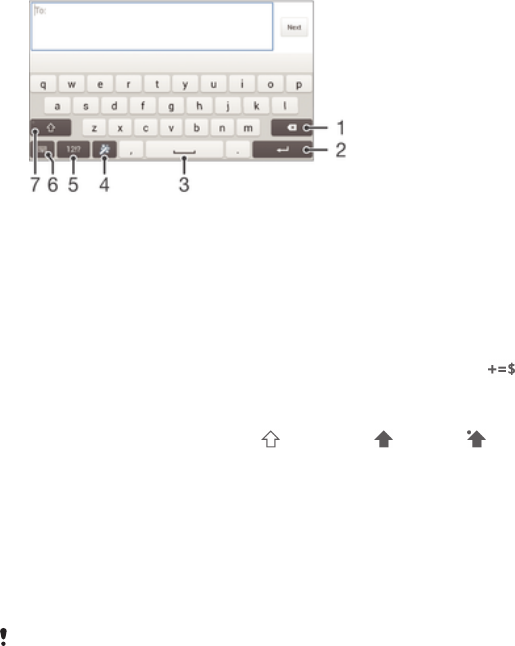
Typing text
On-screen keyboard
You can enter text with the on-screen QWERTY keyboard by tapping each letter
individually, or you can use the Gesture input feature and slide your finger from letter
to letter to form words. You can type in up to three Latin languages without switching
keyboards. The Xperia® international keyboard detects the language and predicts the
words as you type. Some applications open the on-screen keyboard automatically,
for example, email and text messaging applications.
1 Delete a character before the cursor.
2 Enter a carriage return or confirm text input.
3 Enter a space.
4 Personalise your keyboard. This key disappears after the keyboard is personalised.
5Display numbers and symbols. For even more symbols, tap .
6 Close the on-screen keyboard view. Note that this icon does not appear in portrait mode.
7Switch between lower-case , upper-case and caps . For some languages, this key is used to
access extra characters in the language.
To display the on-screen keyboard to enter text
•Tap a text entry field.
To use the on-screen keyboard in landscape orientation
•When the on-screen keyboard is displayed, turn the device sideways.
You may need to adjust the settings in some applications to enable landscape orientation.
To enter text character by character
1To enter a character visible on the keyboard, tap the character.
2To enter a character variant, touch and hold a regular keyboard character to
get a list of available options, then select from the list. For example, to enter
"é", touch and hold "e" until other options appear, then, while keeping your
finger pressed on the keyboard, drag to and select "é".
To enter a period
•After you enter a word, double-tap the space bar.
36
This is an Internet version of this publication. © Print only for private use.
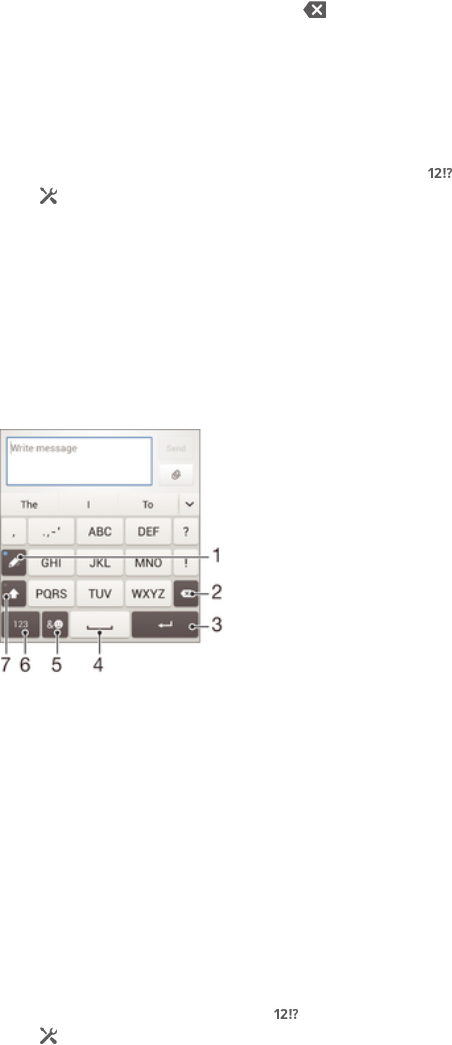
To enter text using the Gesture input function
1When the on-screen keyboard is displayed, slide your finger from letter to letter
to trace the word that you want to write.
2Lift up your finger when you’ve finished entering a word. A word is suggested
based on the letters that you have traced. If necessary, select the correct word
in the candidate bar.
3To view more options, scroll right or left in the word candidate bar. If you
cannot find the desired word, tap once to delete the entire word, then try
again to trace the word, or tap each letter to enter the word.
4If the Automatic space setting is activated, trace the next word that you want
to enter. If not, tap the space bar and then trace the next word that you want to
enter.
To change the Gesture input settings
1When the on-screen keyboard is displayed, tap .
2Tap , then tap Keyboard settings > Text input settings.
3To activate or deactivate the Gesture input function, mark or unmark the
Gesture input checkbox.
Phonepad
The Phonepad is similar to a standard 12-key telephone keypad. It gives you
predictive text and multi-tap input options. You can activate the Phonepad text input
method via the keyboard settings. The Phonepad is only available in portrait
orientation.
1 Choose a text input option. You can tap each character once and use word suggestions, or keep
tapping the key until the desired character is selected.
2 Delete a character before the cursor.
3 Enter a carriage return or confirm text input.
4 Enter a space.
5 Display symbols and smileys.
6 Display numbers.
7 Change the character case and turn on the caps lock.
To open the Phonepad for the first time
1Tap a text entry field, then tap .
2Tap , then tap Keyboard settings.
3Tap Keyboard appearance > Keyboard layout.
4Select the Phonepad.
37
This is an Internet version of this publication. © Print only for private use.

To enter text using the Phonepad
•When appears in the Phonepad, tap each character key only once, even if
the letter you want is not the first letter on the key. Tap the word that appears
or tap to view more word suggestions and select a word from the list.
•When appears in the Phonepad, tap the on-screen key for the character you
want to enter. Keep pressing this key until the desired character is selected.
Then do the same for the next character you want to enter, and so on.
To enter numbers using the Phonepad
•When the Phonepad is displayed, tap . A Phonepad with numbers appears.
To insert symbols and smileys using the Phonepad
1When the Phonepad is displayed, tap . A grid with symbols and smileys
appears.
2Scroll up or down to view more options. Tap a symbol or smiley to select it.
Entering text using voice input
When you enter text, you can use the voice input function instead of typing the
words. Just speak the words that you want to enter. Voice input is an experimental
technology from Google™, and is available for a number of languages and regions.
To enable voice input
1When you enter text using the on-screen keyboard or the Phonepad, tap or
.
2Tap , then tap Keyboard settings .
3Mark the Google voice typing key checkbox.
4Press to save your settings. A microphone icon appears on your on-
screen keyboard or Phonepad.
To enter text using voice input
1Open the on-screen keyboard or the Phonepad.
2Tap . When appears, speak to enter text. When you're finished, tap
again. The suggested text appears.
3Edit the text manually if necessary.
Editing text
You can select, cut, copy and paste text as you write in both portrait and landscape
orientation by double tapping the entered text. In portrait orientation, the necessary
editing tools are available via an application bar. In landscape orientation, an Edit
button provides the same tools.
Application bar
1 Close the application bar
2 Select all text
3 Cut text
4 Copy text
5 Paste text
only appears when you have text saved on the clipboard.
38
This is an Internet version of this publication. © Print only for private use.

To select text
1Enter some text, then double-tap the text. The word you tap gets highlighted
by tabs on both sides.
2Drag the tabs left or right to select more text.
To edit text in portrait orientation
1Enter some text, then double-tap the entered text to make the application bar
appear.
2Select the text you want to edit, then use the application bar to make your
desired changes.
To edit text in landscape orientation
1Enter some text, then double-tap the entered text.
2Select the text you want to work with, then tap Edit... and select an option.
Personalising the Xperia keyboard
When entering text using the on-screen keyboard or the Phonepad, you can access a
keyboard settings and other text input settings that help you set options for writing
languages, text prediction, automatic spacing and quick full stops. For example, you
can decide how word options are presented and how words get corrected as you
type. And you can get your message data scanned so that word predictions fit your
writing style. You can also set the text input application to remember new words that
you write.
To access the on-screen keyboard and Phonepad settings
1When you enter text using the on-screen keyboard or Phonepad, tap or .
2Tap , then tap Keyboard settings, and change the settings as you desired.
3To add a writing language for text input, tap Writing languages and mark the
relevant checkboxes.
4Tap OK to confirm.
To change the text input settings
1When you enter text using the on-screen keyboard or the Phonepad, tap or
.
2Tap , then tap Keyboard settings > Text input settings and select the
relevant settings.
To display the Smiley key
1When you enter text using the on-screen keyboard, tap .
2Tap , then tap Keyboard settings > Keyboard appearance > Additional
keys.
3Mark the Smiley key checkbox.
To scan data for your writing style
1When you enter text using the on-screen keyboard or Phonepad, tap or .
2Tap , then tap Keyboard settings > Use my writing style and select a source
that you want to scan.
To select a keyboard layout variant
Layout variants are only available for the on-screen keyboard when you select two or three
writing languages and may not be available in all writing languages.
1When you enter text using the on-screen keyboard, tap .
2Tap , then tap Keyboard settings.
3Tap Writing languages, then tap .
4Select a keyboard layout variant.
5Tap OK to confirm.
39
This is an Internet version of this publication. © Print only for private use.

Calling
Making calls
You can make a call by manually dialling a phone number, by tapping a number
saved in your contact list, or by tapping the phone number in your call log view. You
can also use the smart dial feature to quickly find numbers from your contact list and
call logs.
1 Open your contacts list
2 View your call log entries
3 View your favourite contacts
4 View all contact groups saved to your device
5 Delete number
6 Dialpad
7 Hide or clear the call log
8 Call button
9 Hide or show the dialer
To make a call by dialling
1From your Home screen, tap .
2Find and tap Phone.
3Enter the number of the recipient and tap .
To make a call using smart dial
1From your Home screen, tap .
2Find and tap Phone.
3Use the dialpad to enter letters or numbers that correspond to the contact you
want to call. As you enter each letter or number, a list of possible matches
appears.
4Tap the contact you want to call.
To make an international call
1From your Home screen, tap .
2Find and tap Phone.
3Touch and hold 0 until a “+” sign appears.
4Enter the country code, area code (without the first 0) and phone number, then
tap .
40
This is an Internet version of this publication. © Print only for private use.

Showing or hiding your phone number
You can select to show or hide your phone number on call recipients' devices when
you call them.
To show or hide your phone number
1From your Home screen, tap .
2Find and tap Settings > Call settings > Additional settings > Caller ID.
Receiving calls
To answer a call
To decline a call
To mute the ringtone for an incoming call
•When you receive the call, press the volume key.
Rejecting a call with a message
You can reject a call with a predefined message. When you reject a call with such a
message, the message is automatically sent to the caller and saved on your device.
Six messages are predefined on your device. You can select from these predefined
messages, which can also be edited if necessary.
To reject a call with a predefined message
•Drag Reject with message upward, then select a message.
To reject a second call with a predefined message
•When you hear repeated beeps during a call, drag Reject with message
upward, then select a message.
To edit the message used to reject a call
1From your Home screen, tap .
2Find and tap Settings > Call settings > Reject call with message.
3Tap the message you want to edit, then make the necessary changes.
4When you're done, tap OK.
Ongoing calls
41
This is an Internet version of this publication. © Print only for private use.

1 Open your contacts list
2 Turn on the loudspeaker during a call
3 Mute the microphone during a call
4 Enter numbers during a call
5 End a call
To change the ear speaker volume during a call
•Press the volume key up or down.
To activate the screen during a call
•Briefly press .
Using the call log
In the call log, you can view missed calls , received calls and dialled calls .
To view your missed calls
1When you have missed a call, appears in the status bar. Drag the status bar
downwards.
2Tap Missed call.
To call a number from your call log
1From your Home screen, tap .
2Find and tap Phone.The call log view appears on the upper part of the screen.
3To call a number directly, tap the number. To edit a number before calling,
touch and hold the number, then tap Edit number before call.
You can also call a number by tapping > Call back.
To add a number from the call log to your contacts
1From your Home screen, tap .
2Find and tap Phone.The call log view appears on the upper part of the screen.
3Touch and hold the number, then tap Add to Contacts.
4Tap the desired contact, or tap Create new contact.
5Edit the contact details and tap Done.
To hide the call log
1From your Home screen, tap .
2Find and tap > .
3Tap Hide call log.
Forwarding calls
You can forward calls, for example, to another phone number, or to an answering
service.
To forward calls
1From your Home screen, tap .
2Find and tap Settings > Call settings > Call forwarding.
3Select an option.
4Enter the number you want to forward the calls to, then tap Enable.
To turn off call forwarding
1From your Home screen, tap .
2Find and tap Settings > Call settings > Call forwarding.
3Select an option, then tap Disable.
42
This is an Internet version of this publication. © Print only for private use.

Restricting calls
You can block all or certain categories of incoming and outgoing calls. If you have
received a PIN2 code from your service provider, you can also use a list of Fixed
Dialling Numbers (FDNs) to restrict outgoing calls.
To enable or disable fixed dialling
1From your Home screen, tap .
2Find and tap Settings > Call settings > Fixed dialling numbers.
3Tap Activate fixed dialling or Deactivate fixed dialling.
4Enter your PIN2 and tap OK.
To access the list of accepted call recipients
1From your Home screen, tap .
2Find and tap Settings > Call settings > Fixed dialling numbers > Fixed
dialling numbers.
Multiple calls
If you have activated call waiting, you can handle multiple calls at the same time.
When it is activated, you will be notified by a beep if you receive another call.
To activate or deactivate call waiting
1From the Home screen, tap .
2Find and tap Settings > Call settings > Additional settings.
3To activate or deactivate call waiting, tap Call waiting.
To answer a second call and put the ongoing call on hold
•When you hear repeated beeps during a call, drag to the right.
To reject a second call
•When you hear repeated beeps during a call, drag to the left.
To make a second call
1During an ongoing call, tap Dialpad.
2Enter the number of the recipient and tap . The first call is put on hold.
To switch between multiple calls
•To switch to another call and put the current call on hold, tap Switch to this
call.
Conference calls
With a conference or multiparty call, you can have a joint conversation with two or
more persons.
For details about the number of participants that you can add to a conference call, contact
your network operator.
To make a conference call
1During an ongoing call, tap .
2Dial the number of the second participant and tap Call. After the second
participant answers, the first participant is put on hold.
3Tap to add the second participant to the conference call.
4Repeat steps 1 to 3 to add more call participants.
43
This is an Internet version of this publication. © Print only for private use.

To have a private conversation with a conference call participant
1During an ongoing conference call, tap {0} participants.
2Tap the telephone number of the participant with whom you want to talk
privately.
3To end the private conversation and return to the conference call, tap .
To release a participant from a conference call
1During an ongoing conference call, tap the button showing the number of
participants. For example, tap 3 participants if there are three participants.
2Tap next to the participant you want to release.
To end a conference call
•During the conference call, tap End conference call.
Voicemail
If your subscription includes a voicemail service, callers can leave voice messages for
you when you can't answer calls.
To call your voicemail service
1From your Home screen, tap .
2Find and tap Phone.
3Touch and hold 1.
Visual Voicemail
With Visual Voicemail you can listen to voicemail messages in any order, reply via
call-back or text message, and easily manage your voicemail inbox. You can also
create different greetings, receive all your voicemail messages transcribed into text,
and more.
Before using Visual Voicemail, you must set up a PIN first. Your voicemail messages are
downloaded locally to your device.
To listen to a voicemail message
1From your Home screen, tap .
2Find and tap Visual Voicemail.
3In your voicemail inbox, tap the message that you want to listen to.
4Tap the play button.
To reply to a voicemail message
1From your Home screen, tap .
2Find and tap Visual Voicemail.
3In your voicemail inbox, tap the message that you want to reply to.
4Tap Call to reply via call-back, or tap Send message to reply via text message.
To refresh your voicemail inbox
1From your Home screen, tap .
2Find and tap Visual Voicemail.
3Tap Menu > Refresh.
Emergency calls
Your device supports international emergency numbers, for example, 112 or 911.
You can normally use these numbers to make emergency calls in any country, with or
without a SIM card inserted if you are within range of a network.
44
This is an Internet version of this publication. © Print only for private use.

To make an emergency call
1From your Home screen, tap .
2Find and Tap Phone.
3Enter the emergency number and tap . To delete a number, tap .
You can make emergency calls when no SIM card is inserted or when outgoing calls are
barred.
To make an emergency call while the SIM card is locked
1From the lock screen, tap Emergency call.
2Enter the emergency number and tap .
Wi-Fi Calling
With Wi-Fi Calling, you can make and receive calls and messages over Wi-Fi when
your phone is connected to a Wi-Fi network and registered with the T-Mobile
network. By default, your phone is enabled for Wi-Fi Calling as soon as you enable
Wi-Fi. When your phone is connected to a Wi-Fi network, it will automatically attempt
to register with the T-Mobile network. Please note: To use Wi-Fi Calling you must
have a valid E911 emergency address registered in your T-Mobile account. Visit My
T-Mobile to add your address.
Upon successful registration a blue Wi-Fi Calling icon will appear in the status bar.
You are now ready to use Wi-Fi Calling. When a call is in progress, the blue Wi-Fi
Calling icon will change to green .
To disable Wi-Fi calling
1From your Home screen, tap .
2Find and tap Settings.
3Tap More….
4Tap beside Wi-Fi calling so that changes to .
To enable Wi-Fi calling
1From your Home screen, tap .
2Find and tap Settings.
3Tap More….
4Tap beside Wi-Fi calling so that changes to .
To change the connection preference for Wi-Fi calling
1From your Home screen, tap .
2Find and tap Settings.
3Tap More… > Wi-Fi calling.
4Select the desired connection preference.
45
This is an Internet version of this publication. © Print only for private use.

Contacts
Transferring contacts
There are several ways to transfer contacts to your new device. Find out more about
choosing a transfer method at
www.sonymobile.com/support
.
Transferring contacts using a computer
Contacts Setup is an application within PC Companion and within Sony™ Bridge for
Mac that helps you to collect the contacts from your old device and transfer them to
your new device. Contacts Setup supports several device brands, including iPhone,
Samsung, HTC and Nokia.
You need:
•An Internet-connected computer.
•A USB cable for your old device.
•A USB cable for your new Android™ device.
•Your old device.
•Your new Android™ device.
To transfer contacts to your new device using a computer
1Make sure that
PC Companion
is installed on your PC or that
Sony™ Bridge for Mac
is installed on your Apple® Mac® computer.
2Open the PC Companion application or the Sony™ Bridge for Mac application,
then click
Contacts Setup
and follow the instructions to transfer your contacts.
Transferring contacts using an online account
If you sync the contacts in your old device or your computer with an online account,
for example, Google Sync™, Facebook™ or Microsoft® Exchange ActiveSync®, you
can transfer your contacts to your new device using that account.
To synchronise contacts to your new device using a synchronisation account
1From your Home screen, tap , then tap .
2Tap , then tap Settings > Accounts & sync.
3Select the account that you want to sync your contacts with, then tap > Sync
now.
You need to be signed in to the relevant sync account before you can sync your contacts with
it.
Other methods for transferring contacts
There are several other ways to transfer contacts from your old device to your new
device. For example, you can copy contacts to a memory card, save contacts to a
SIM card, or use Bluetooth® technology. For more specific information about
transferring the contacts from your old device, refer to the relevant User guide..
To import contacts from a memory card
1From your Home screen, tap , then tap .
2Press , then tap Import contacts > SD card.
3Select where to store your contacts.
4Select the file that you want to import.
46
This is an Internet version of this publication. © Print only for private use.
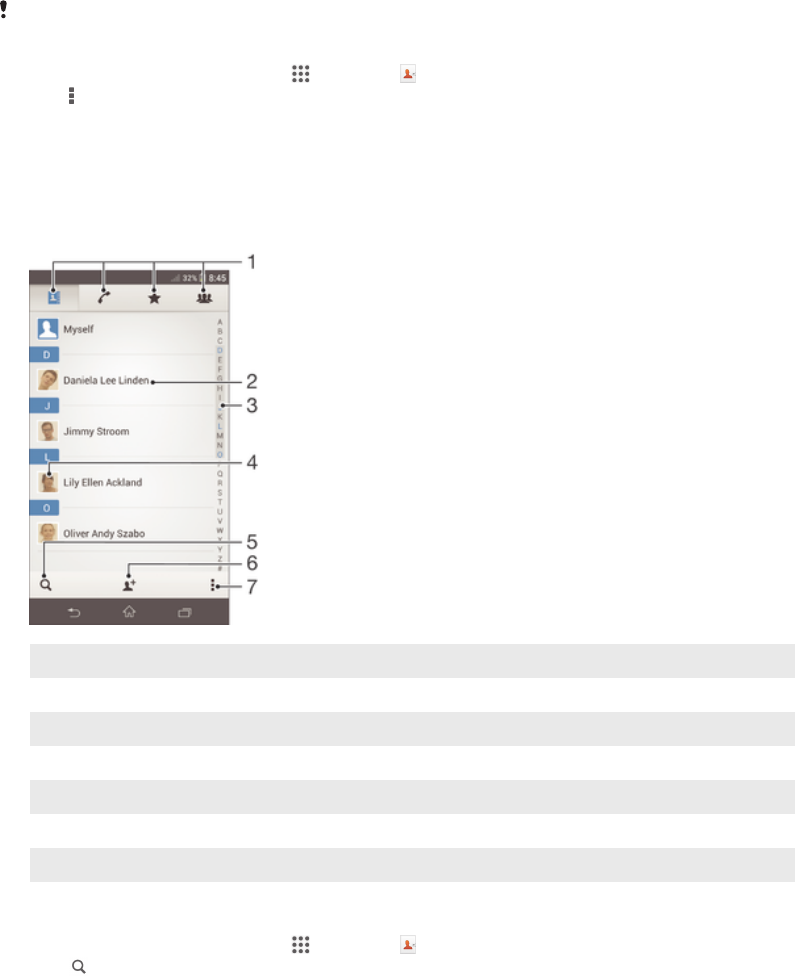
To import contacts using Bluetooth® technology
1Make sure you have the Bluetooth® function turned on and that your device is
set to visible.
2When you are notified of an incoming file to your device, drag the status bar
downwards and tap the notification to accept the file transfer.
3Tap Accept to start the file transfer.
4Drag the status bar downwards. When the transfer is complete, tap the
notification.
5Tap the received file and select where to store your contacts.
To import contacts from a SIM card
You may lose information or get multiple contact entries if you transfer contacts using a SIM
card.
1From your Home screen, tap , then tap .
2Tap , then tap Import contacts > SIM card.
3Select where to store your contacts.
4To import an individual contact, find and tap the contact. To import all
contacts, tap Import all.
Searching and viewing contacts
1 Contacts, Calling, Favourites and Groups tabs
2 View contact details
3 Jump to contacts starting with the selected letter
4 Access communication options for the contact
5 Search for contacts
6 Add a contact
7 View more options
To search for a contact
1From your Home screen, tap , then tap .
2Tap and enter the first few letters of the contact name in the Search
contacts field. All contacts beginning with those letters appear.
47
This is an Internet version of this publication. © Print only for private use.

To select which contacts to display in the Contacts application
1From your Home screen, tap , then tap .
2Press , then tap Filter.
3In the list that appears, mark and unmark the desired options. If you have
synchronised your contacts with a synchronisation account, that account
appears in the list. To further expand the list of options, tap the account.
4When you are finished, tap OK.
Adding and editing contacts
To add a contact
1From your Home screen, tap , then tap .
2Tap .
3If you have synchronised your contacts with one or more accounts and you are
adding a contact for the first time, you must select the account to which you
want to add this contact. Alternatively, tap Phone contact if you only want to
use and save this contact on your device.
4Enter or select the desired information for the contact.
5When you are finished, tap Done.
After you select a synchronisation account in step 3, that account will show as the default
account offered the next time you add a contact, but you can change the account by editing
the contact after it is saved.
If you add a plus sign and the country code before a contact's phone number, you do not
have to edit the number again when you make calls from other countries.
To edit a contact
1From your Home screen, tap , then tap .
2Tap the contact that you want to edit, then tap .
3Edit the desired information.
4When you are finished, tap Done.
Some synchronisation services do not allow you to edit contact details.
To associate a picture with a contact
1From your Home screen, tap , then tap .
2Tap the contact you want to edit, then tap .
3Tap and select the desired method for adding the contact picture.
4When you have added the picture, tap Done.
You can also add a picture to a contact directly from the Album application.
To personalise the ringtone for a contact
1From your Home screen, tap , then tap .
2Tap the contact that you want to edit, then tap .
3Tap > Set ringtone.
4Select an option, then tap Done.
5Tap Done.
To delete contacts
1From your Home screen, tap , then tap .
2Touch and hold the contact that you want to delete.
3To delete all contacts, tap the downwards arrow to open the drop down menu,
then select Mark all.
4Tap , then tap Delete.
48
This is an Internet version of this publication. © Print only for private use.

To edit contact information about yourself
1From your Home screen, tap , then tap .
2Tap Myself, then tap .
3Enter the new information or make the changes you want.
4When you are done, tap Done.
To create a new contact from a text message
1From your Home screen, tap , then find and tap .
2Tap > Save.
3Select an existing contact, or tap Create new contact.
4Edit the contact information and tap Done.
Favourites and groups
You can mark contacts as favourites so that you can get quick access to them from
the Contacts application. You can also assign contacts to groups, to get quicker
access to them from within the Contacts application.
To mark or unmark a contact as a favourite
1From the Home screen, tap , then tap .
2Tap the contact you want to add to or remove from your favourites.
3Tap .
To view your favourite contacts
1From your Home screen, tap , then tap .
2Tap .
To assign a contact to a group
1In the Contacts application, tap the contact that you want to assign to a group.
2Tap , then tap the bar directly under Groups.
3Mark the checkboxes for the groups to which you want to add the contact.
4Tap Done.
Sending contact information
To send your business card
1From your Home screen, tap , then tap .
2Tap Myself.
3Press , then tap Send contact > OK.
4Select an available transfer method and follow the on-screen instructions.
To send a contact
1From your Home screen, tap , then tap .
2Tap the contact whose details you want to send.
3Press , then tap Send contact > OK.
4Select an available transfer method and follow the on-screen instructions.
To send several contacts at once
1From your Home screen, tap , then tap .
2Press , then tap Mark several.
3Mark the contacts you want to send, or select all if you want to send all
contacts.
4Tap , then select an available transfer method and follow the on-screen
instructions.
Avoiding duplicate entries in the Contacts application
If you synchronise your contacts with a new account or import contact information in
other ways, you could end up with duplicate entries in the Contacts application. If this
49
This is an Internet version of this publication. © Print only for private use.

happens, you can join such duplicates to create a single entry. And if you join entries
by mistake, you can separate them again later.
To link contacts
1From your Home screen, tap , then tap .
2Tap the contact that you want to link with another contact.
3Press , then tap Link contact.
4Tap the contact whose information you want to join with the first contact, then
tap OK to confirm. The information from the first contact is merged with the
second contact, and the linked contacts are displayed as one contact in the
Contacts list.
To separate linked contacts
1From your Home screen, tap , then tap .
2Tap the linked contact that you want to edit, then tap .
3Tap > Separate > OK.
Backing up contacts
You can use a memory card or a SIM card to back up contacts.
To export all contacts to a memory card
1From your Home screen, tap , then tap .
2Press , then tap Export contacts > SD card.
3Tap OK.
To export contacts to a SIM card
1From your Home screen, tap , then tap .
2Press , then tap Export contacts > SIM card.
3Mark the contacts you want to export, or tap Mark all if you want to export all
your contacts.
4Tap Export.
5Select Add contacts if you want to add the contacts to existing contacts on
your SIM card, or select Replace all contacts if you want to replace the
existing contacts on your SIM card.
When you export contacts to a SIM card, not all information may get exported. This is due to
memory limitations on SIM cards.
50
This is an Internet version of this publication. © Print only for private use.
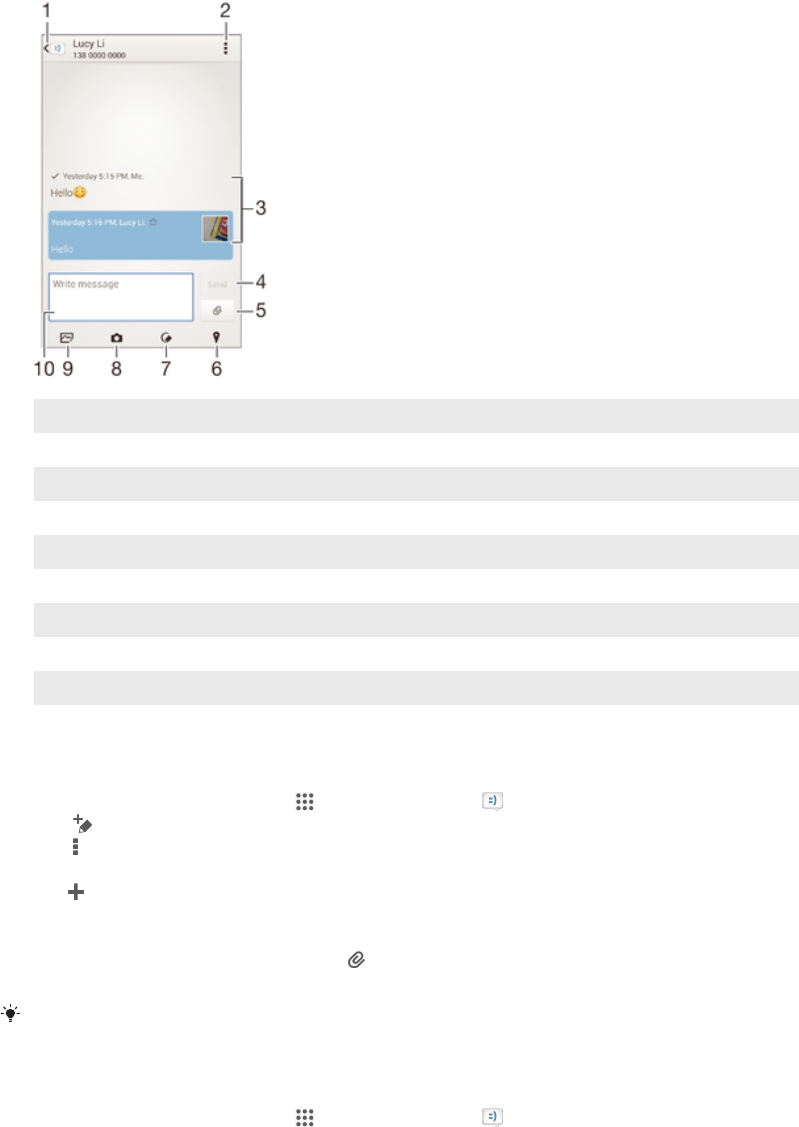
Messaging and chat
Reading and sending messages
The Messaging application shows your messages as conversations, which means
that all messages to and from a particular person are grouped together. To send
multimedia messages, you need the correct MMS settings on your device. See
Internet and messaging settings
on page 26.
1 Go back to the list of conversations
2 View options
3 Sent and received messages
4 Send button
5 Attach a file
6 Attach a location
7 Attach a handwritten note or image
8 Take a photo and attach it
9 Attach a photo saved on your device
10 Text field
To create and send a message
1From your Home screen, tap , then find and tap .
2Tap .
3Tap , then tap Add recipient and select a contact from the Contacts list. If the
recipient is not listed as a contact, enter the recipient's number manually and
tap .
4When you are finished adding recipients, tap Done.
5Tap Write message and enter your message text.
6If you want to add a media file, tap and select an option.
7To send the message, tap Send.
If you exit a message before sending, it gets saved as a draft. The conversation gets tagged
with the word Draft:.
To read a received message
1From your Home screen, tap , then find and tap .
2Tap the desired conversation.
3If the message is not yet downloaded, tap and hold the message, then tap
Download message.
51
This is an Internet version of this publication. © Print only for private use.

To reply to a message
1From your Home screen, tap , then find and tap .
2Tap the conversation containing the message.
3Enter your reply and tap Send.
To forward a message
1From your Home screen, tap , then find and tap .
2Tap the conversation containing the message that you want to forward.
3Touch and hold the message that you want to forward, then tap Forward
message.
4Tap , then tap Add recipient and select a contact from the Contacts list. If the
recipient is not listed as a contact, enter the contact's number manually and
tap .
5When you are finished adding recipients, tap Done.
6Edit the message, if necessary, then tap Send.
In step 4, you can also tap To and enter the recipient's phone number manually.
To save a file contained in a message you receive
1From your Home screen, tap , then find and tap .
2Tap the conversation you want to open.
3If the message has not been downloaded yet, tap and hold the message, then
tap Download message.
4Touch and hold the file you want to save, then select the desired option.
Organising your messages
To delete a message
1From your Home screen, tap , then find and tap .
2Tap the conversation containing the message you want to delete.
3Touch and hold the message you want to delete, then tap Delete message >
Delete.
To delete conversations
1From your Home screen, tap , then find and tap .
2Tap , then tap Delete conversations.
3Mark the checkboxes for the conversations that you want to delete, then tap
> Delete.
To star a message
1From your Home screen, tap , then find and tap .
2Tap the conversation you want to open.
3In the message you want to star, tap .
4To unstar a message, tap .
To view starred messages
1From your Home screen, tap , then find and tap .
2Tap , then tap Starred messages.
3All starred messages appear in a list.
To search for messages
1From your Home screen, tap , then find and tap .
2Tap , then tap Search.
3Enter your search keywords. The search results appear in a list.
52
This is an Internet version of this publication. © Print only for private use.

Calling from a message
To call a message sender
1From your Home screen, tap , then find and tap .
2Tap a conversation.
3Tap the recipient name or number at the top of the screen, then select the
recipient name or number from the list that appears.
4If the recipient is saved in your contacts, tap the phone number that you want
to call. If you have not saved the recipient in your contacts, tap .
To save a sender's number as a contact
1From your Home screen, tap , then find and tap .
2Tap > Save.
3Select an existing contact, or tap Create new contact.
4Edit the contact information and tap Done.
Messaging settings
To change your message notification settings
1From your Home screen, tap , then find and tap .
2Tap , then tap Settings.
3To set a notification sound, tap Notification tone and select an option.
4For other notification settings, check or uncheck the relevant checkboxes.
To change the delivery report settings for outgoing messages
1From your Home screen, tap , then find and tap .
2Tap , then tap Settings.
3Tap Delivery report to activate or deactivate delivery reports.
Instant messaging and video chat
You can use the Hangouts™ instant messaging and video chat application on your
device to chat with friends who also use the application on computers, Android™
devices and other devices. You can turn any conversation into a video call with
several friends, and you can send messages to friends even when they are offline.
You can also view and share photos easily.
The video call function only works on devices with a front camera.
1 Start a new chat or video call
2 Options
3 List of contacts
53
This is an Internet version of this publication. © Print only for private use.

To start a chat
1From your Home screen, tap .
2Find and tap Hangouts.
3Tap , then enter a contact name, email address, phone number or circle
name and select the relevant entry from the suggested list.
4To start an instant messaging session, tap .
5To start a video call, tap .
To reply to a chat message or join a video call
1When someone contacts you on Hangouts, or appears in the status bar.
2Drag the status bar downwards, then tap the message or video call and begin
to chat.
To learn more about Hangouts™
•When the Hangouts™ application is open, tap , then tap Help.
54
This is an Internet version of this publication. © Print only for private use.
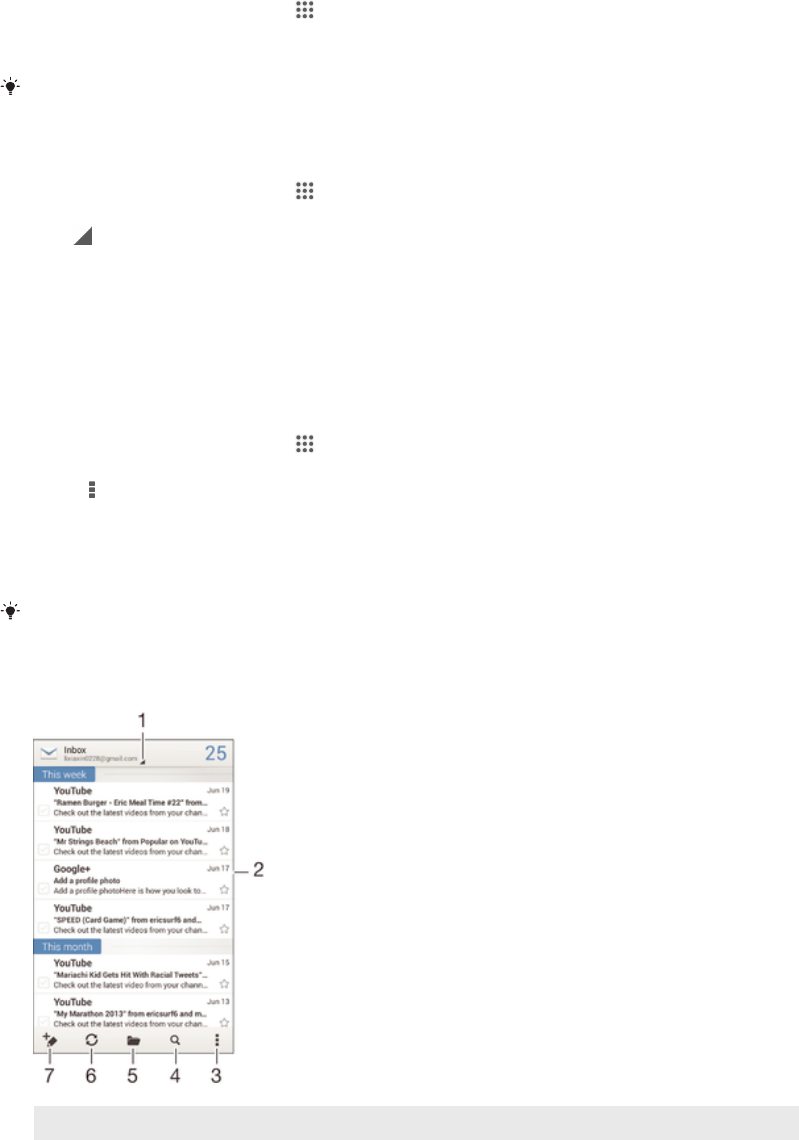
Email
Setting up email
Use the email application in your device to send and receive email messages through
your email accounts. You can have one or several email accounts at the same time,
including corporate Microsoft Exchange ActiveSync accounts.
To set up an email account
1From your Home screen, tap .
2Find and tap Email.
3Follow the instructions that appear on the screen to complete the setup.
For some email services, you may need to contact your email service provider for information
on detailed settings for the email account.
To add an extra email account
1From your Home screen, tap .
2Find and tap Email.
3Tap at the top of the screen, then tap Add account.
4Enter the email address and password, then tap Next. If the settings for the
email account cannot be downloaded automatically, complete the setup
manually.
5When prompted, enter a name for your email account so that it is easily
identifiable. The same name shows in the emails you send from this account.
6When you are finished, tap Next.
To set an email account as your default account
1From your Home screen, tap .
2Find and tap Email.
3Press , then tap Settings.
4Select the account you want to use as the default account for composing and
sending email messages.
5Mark the Default account checkbox. The inbox of the default account appears
every time you open the email application.
If you only have one email account, this account is automatically the default account.
Sending and receiving email messages
1 View a list of all email accounts and recent folders
2 List of email messages
55
This is an Internet version of this publication. © Print only for private use.

3 Options
4 Search for email messages
5 View folders
6 Download new email messages
7 Write a new email message
To download new email messages
1From your Home screen, tap .
2Find and tap Email.
3If you are using several email accounts, tap at the top of the screen and
select the account that you want to check.
4To download new messages, tap .
To read your email messages
1From your Home screen, tap .
2Find and tap Email.
3If you are using several email accounts, tap at the top of the screen and
select the account that you want to check. If you want to check all your email
accounts at once, tap Combined view.
4In the email inbox, scroll up or down and tap the email message that you want
to read.
To create and send an email message
1From your Home screen, tap , then find and tap Email.
2If you are using several email accounts, tap at the top of the screen and
select the account that you want to use.
3Tap , then tap To and start typing the recipient's name or email address, or
tap and select one or more recipients from your Contacts list.
4Enter the email subject and message text, then tap .
To reply to an email message
1From your Home screen, tap .
2Find and tap Email.
3In your email inbox, find and tap the message that you want to reply to, then
tap Reply or Reply all.
4Enter your reply, then tap .
To forward an email message
1From your Home screen, tap .
2Find and tap Email.
3In your email inbox, find and tap the message that you want to forward, then
tap Forward.
4Tap To and enter the recipient's email address manually, or tap and select a
recipient from your Contacts list.
5Enter your message text, then tap .
To view an email message attachment
1From your Home screen, tap .
2Find and tap Email.
3Find and tap the email message containing the attachment that you want to
view. Email messages with attachments are indicated by .
4After the email message opens, tap View.
56
This is an Internet version of this publication. © Print only for private use.
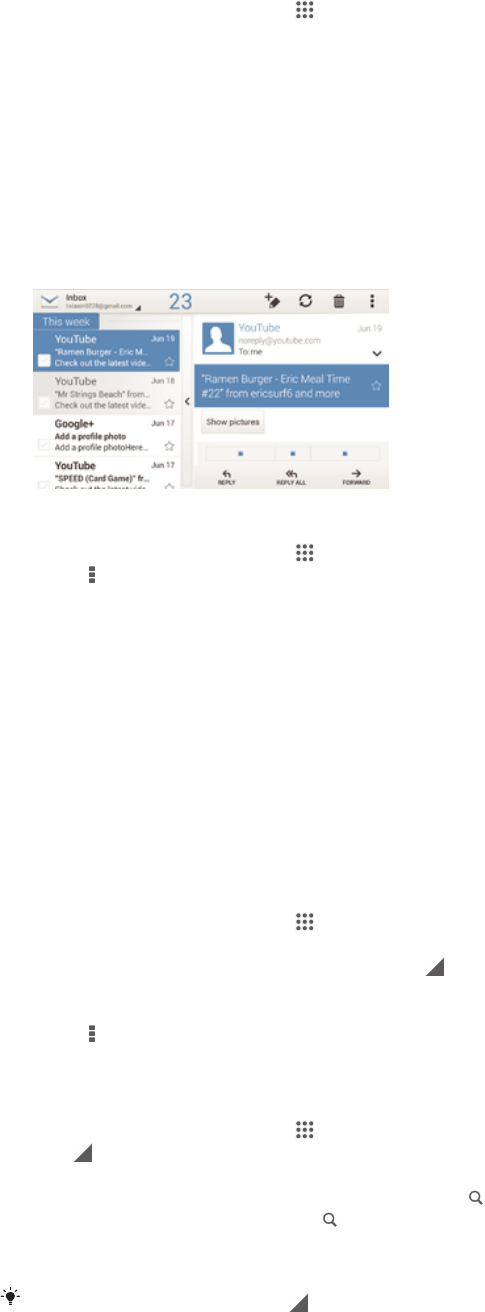
To save a sender's email address to your contacts
1From your Home screen, tap .
2Find and tap Email.
3Find and tap a message in your email inbox.
4Tap the name of the sender, then tap OK.
5Select an existing contact, or tap Create new contact.
6Edit the contact information, if desired, then tap Done.
Email preview pane
A preview pane is available for viewing and reading your email messages in
landscape orientation. Once activated, you can use it to view both the email message
list and one selected email message at the same time.
To activate the preview pane
1From your Home screen, tap , then find and tap Email.
2Press , then tap Settings.
3Tap General > Preview pane > Landscape.
To read email messages using the preview pane
1Make sure the preview pane has been activated for landscape orientation.
2Open your email inbox, then hold your device in landscape orientation.
3Scroll up or down and tap the email message that you want to read.
4To view the email message in fullscreen format, tap the split bar (located
between the email list and the email body). To return to the regular inbox view,
tap the split bar again.
Organising your email messages
To sort your emails
1From your Home screen, tap .
2Find and tap Email.
3If you are using several email accounts, tap at the top of the screen and
select the account that you want to check. If you want to check all your email
accounts at once, tap Combined view.
4Press , then tap Sort.
5Select a sorting option.
To search for emails
1From your Home screen, tap , then find and tap Email.
2Tap at the top of the screen and select the account that you want to search.
If you want to search all your email accounts at once, tap Combined view
3Hold your device in portrait orientation, then tap .
4Enter your search text, then tap on the keyboard.
5The search result appears in a list sorted by date. Tap the email message that
you want to open.
To change search options, tap and select a different option.
57
This is an Internet version of this publication. © Print only for private use.

To view all folders for one email account
1From your Home screen, tap . Then find and tap Email.
2Tap at the top of the screen and select the account you want to check, then
tap again and select Show all folders to view all the folders in this account.
To delete an email message
1From your Home screen, tap .
2Find and tap Email.
3In your email inbox, find and tap the message that you want to delete, then tap
.
4Tap Delete.
In your email inbox, you can also flick a message to the left or right to delete it.
Email account settings
To remove an email account from your device
1From your Home screen, tap .
2Find and tap Email.
3Press , then tap Settings.
4Select the account you want to remove.
5Tap Delete account > OK.
To change the inbox check frequency
1From your Home screen, tap .
2Find and tap Email.
3Press , then tap Settings.
4Select the account for which you want to change the inbox check frequency.
5Tap Inbox check frequency > Inbox check frequency and select an option.
To set an Out of Office auto-reply in an Exchange Active Sync account
1From your Home screen, tap , then find and tap Email.
2Press , then tap Settings.
3Select the EAS (Exchange Active Sync) account for which you want to set an
Out of Office auto-reply.
4Tap Out of office.
5Tap beside Out of office so that changes to .
6If needed, mark the Set time range checkbox and set the time range for the
auto reply.
7Enter your Out of Office message in the body text field.
8Tap OK to confirm.
Gmail™
If you have a Google™ account, you can use the Gmail™ application to read and
write email messages.
58
This is an Internet version of this publication. © Print only for private use.
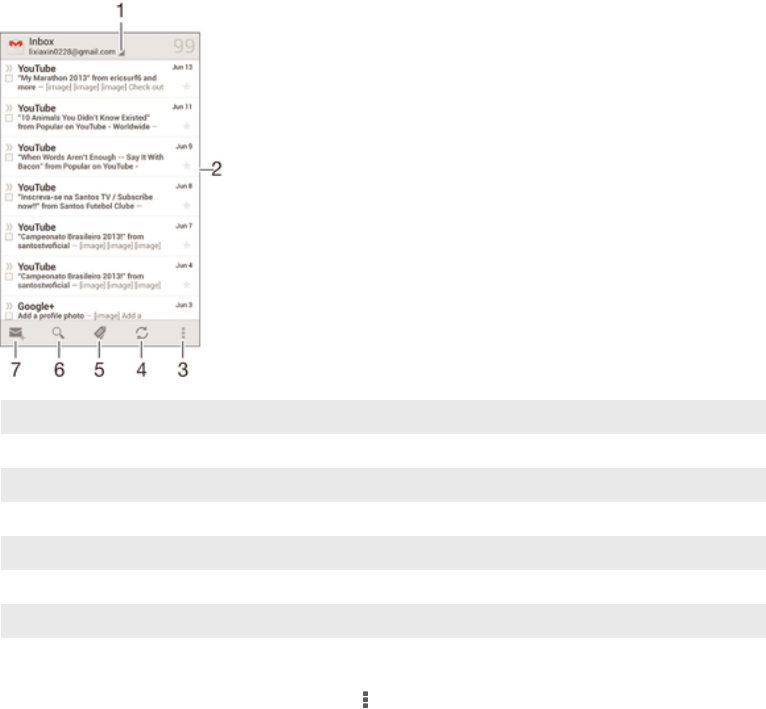
1 View a list of all Gmail accounts and recent folders
2 List of email messages
3 Options
4 Download new email messages
5 View all folders
6 Search for email messages
7 Write a new email message
To learn more about Gmail™
•When the Gmail application is open, tap , then tap Help.
59
This is an Internet version of this publication. © Print only for private use.

Socialife™
Using the Socialife™ application
Use the Socialife™ application from Sony to get your favourite news, videos and
social networking feeds in one place. The Socialife™ home screen gives a clear
overview of friends’ Facebook and Twitter™ activity, plus news feeds that you have
subscribed to. It colour-codes and sizes articles for easy reading, adding photos and
cropping images of your friends’ faces to illustrate each story.
The Socialife™ application is not available in all markets.
To open the Socialife™ application
1From your Home screen, tap .
2Find and tap .
60
This is an Internet version of this publication. © Print only for private use.
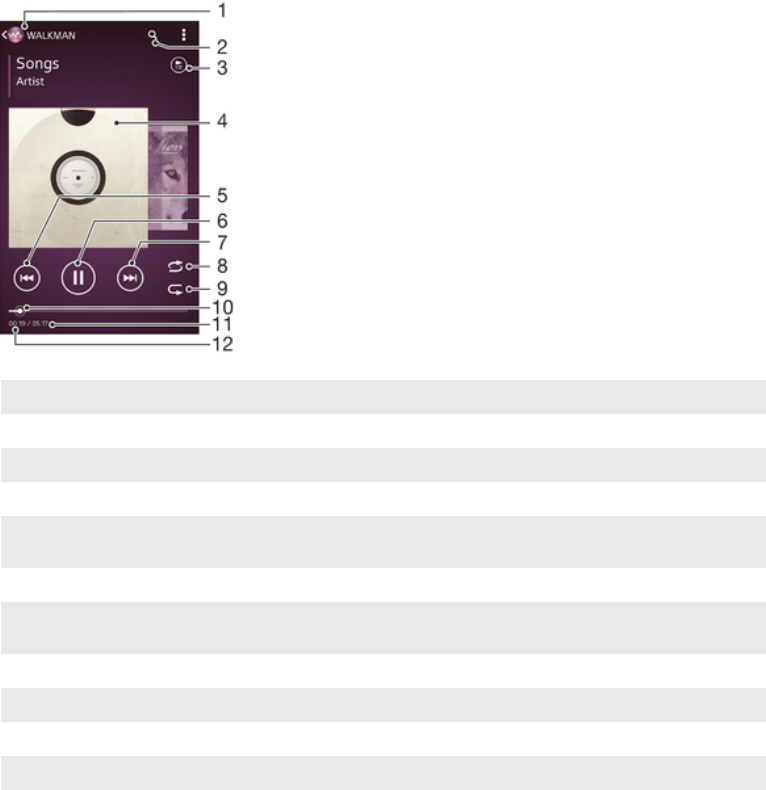
Music
Transferring music to your device
There are different ways to get music from a computer to your device:
•Connect the device and computer using a USB cable and drag and drop music files
directly into the file manager application on the computer. See
Connecting your
device to a computer
on page 95.
•If the computer is a PC, you can use the Media Go™ application from Sony and
organise your music files, create playlists, subscribe to podcasts, and more. To learn
more and download the Media Go™ application, go to http://mediago.sony.com/enu/
features.
•If the computer is an Apple® Mac®, you can use the Sony™ Bridge for Mac
application to transfer your media files from iTunes to your device. To learn more and
download Sony™ Bridge for Mac, go to
www.sonymobile.com/global-en/tools/bridge-for-mac/
.
Listening to music
Use the "WALKMAN" application to listen to your favourite music and audio books.
1 Browse your music
2 Search songs on Music Unlimited and all songs saved to your device
3 View the current play queue
4 Album art (if available)
5 Tap to go to the previous song in the play queue
Touch and hold to rewind within the current song
6 Play or pause a song
7 Tap to go to the next song in the play queue
Touch and hold to fast forward within the current song
8 Shuffle songs in the current play queue
9 Repeat all songs in the current play queue
10 Progress indicator – Drag the indicator or tap along the line to fast forward or rewind
11 Total time length of current song
12 Elapsed time of current song
61
This is an Internet version of this publication. © Print only for private use.

To play a song
1From your Home screen, tap , then find and tap .
2If the WALKMAN home screen is not displayed, tap .
3Select a music category, for example, under Artists, Albums or Songs, then
browse to the song that you want to open.
4Tap a song to play it.
You might not be able to play copyright-protected items. Please verify that you have
necessary rights in material that you intend to share.
To find song-related information online
•While a song is playing in the "WALKMAN" application, tap the album art to
display the infinite button , then tap .
The infinite button gives you access to several sources of information including videos on
YouTube™, lyrics, and artist info on Wikipedia.
To adjust the audio volume
•Press the volume key.
To minimise the "WALKMAN" application
•When a song is playing, tap to go to the Home screen. The "WALKMAN"
application stays playing in the background.
To open the "WALKMAN" application when it is playing in the background
1While a song is playing in the background, tap the to open the recently used
applications window.
2Tap the "WALKMAN" application.
WALKMAN home screen
The WALKMAN home screen gives you an overview of all the songs on your device
as well as of the songs available on Music Unlimited. From here you can manage
your albums and playlists, create shortcuts, and organise your music by mood and
tempo using SensMe™ channels.
1 Open the Music Unlimited service
2 Browse your music by artist
3 Browse your music by song
4 Browse your music by album
5 Browse all playlists
6 Collect links to music and related content that you and friends have shared using online services
7 Manage and edit your music using Music Unlimited channels
62
This is an Internet version of this publication. © Print only for private use.

8 Open the "WALKMAN" music player
Sony Entertainment Network with Video Unlimited and Music Unlimited is not available in every
market. Separate subscription required. Additional terms and conditions apply.
To display the WALKMAN home screen
1From the Home screen, tap > .
2If the WALKMAN home screen is not displayed, tap .
To add a shortcut to a song
1From the WALKMAN home screen, browse to the song for which you want to
create a shortcut.
2Touch and hold the song title.
3Tap Add as shortcut. The shortcut now appears in the WALKMAN home
screen.
You cannot add shortcuts to songs from Music Unlimited.
To rearrange shortcuts
•From the WALKMAN home screen, touch and hold a shortcut until it magnifies
and your device vibrates, then drag the item to a new location.
To delete a shortcut
•From the WALKMAN home screen, touch and hold a shortcut until it magnifies
and your device vibrates, then drag the item to .
You can only delete shortcuts that you create yourself.
You can also drag default shortcuts to but they only get hidden, not deleted.
To update your music with the latest information
1From the WALKMAN home screen, tap .
2Tap Download music info > Start. Your device searches online and downloads
the latest available album art and song information for your music.
The SensMe™ channels application is activated when you download music information.
To enable the SensMe™ channels application
•From the WALKMAN home screen, tap , then tap Download music info >
Start.
This application requires a mobile or Wi-Fi® network connection.
To delete a song
1Open the WALKMAN home screen, then browse to the song that you want to
delete.
2Touch and hold the song title, then tap Delete.
You can also delete albums this way.
Playlists
On the WALKMAN home screen, you can create your own playlists from the music
that is saved on your device.
63
This is an Internet version of this publication. © Print only for private use.

To create your own playlists
1Open the WALKMAN home screen.
2To add an artist, album or a song to a playlist, touch and hold the name of the
artist or the title of the album or song.
3In the menu that opens, tap Add to > Create new playlist.
4Enter a name for the playlist and tap OK.
You can also tap the album art and then tap to create a new playlist.
To add songs to a playlist
1Open the WALKMAN home screen.
2Browse to the song or album that you want to add to a playlist, then touch and
hold the song or the album title.
3Tap Add to.
4Tap the name of the playlist to which you want to add the album or song. The
album or song is added to the playlist.
To play your own playlists
1Open the WALKMAN home screen, then tap Playlists.
2Under Playlists, tap a playlist.
3Tap a song to play it.
To remove a song from a playlist
1In a playlist, touch and hold the title of the song you want to delete.
2Tap Delete from playlist from the list that appears.
To delete a playlist
1Open the WALKMAN home screen, then tap Playlists.
2Touch and hold the playlist that you want to delete.
3Tap Delete.
4Tap Delete again to confirm.
You cannot delete default playlists.
Sharing music
To send a song
1Open the WALKMAN home screen.
2Browse to the song or album that you want to send, then touch and hold the
song title.
3Tap Share.
4Select an application from the list, then follow the on-screen instructions.
You can also send albums and playlists in the same way.
Sharing music on Facebook™
The Friends’ music function collects links to music and music-related content that
you and your friends have shared using Facebook™.
To "Like" a song on Facebook™
1While the song is playing in the "WALKMAN" application, tap the album art.
2Tap to show that you "Like" the song on Facebook™. If desired, add a
comment in the comments field.
3Tap Share to send the song to Facebook™. If the song is received
successfully, you will get a confirmation message from Facebook™.
64
This is an Internet version of this publication. © Print only for private use.

To manage music from your friends
1Open the WALKMAN home screen, then tap Friends' music > Recent.
2Tap an item to open it, then work on it as desired.
3Tap to show that you "Like" the song on Facebook™. If desired, add a
comment in the comments field.
To view your shared music
1Open the WALKMAN home screen, then tap Friends' music > My shares.
2Scroll to an item that you want to open, then tap it. All comments about the
item, if any, are displayed.
Enhancing the sound
To improve the sound quality using the Equaliser
1When a song is playing in the "WALKMAN" application, tap .
2Tap Settings > Sound effects > Sound enhancements.
3Select a setting, then tap OK to confirm.
To turn on the surround sound
1When the "WALKMAN" application is open, tap .
2Tap Settings > Sound effects > Sound enhancements > Settings > Surround
sound (VPT).
3Select a setting, then tap OK to confirm.
Visualiser
The Visualiser adds visual effects to your songs as you play them. The effects for
each song are based on the characteristics of the music. They change, for example,
in response to changes in the music’s loudness, rhythm and frequency level. You can
also change the background theme.
To turn on the Visualiser
1In the "WALKMAN" application, tap .
2Tap Visualiser.
Tap the screen to switch to full screen view.
To change the background theme
1In the "WALKMAN" application, tap .
2Tap Visualiser.
3Tap > Theme and select a theme.
Recognising music with TrackID™
Use the TrackID™ music recognition service to identify a music track you hear
playing in your surroundings. Just record a short sample of the song and you’ll get
artist, title and album info within seconds. You can purchase tracks identified by
TrackID™ and you can view TrackID™ charts to see what TrackID™ users around
the globe are searching for. For best results, use TrackID™ technology in a quiet
area.
65
This is an Internet version of this publication. © Print only for private use.
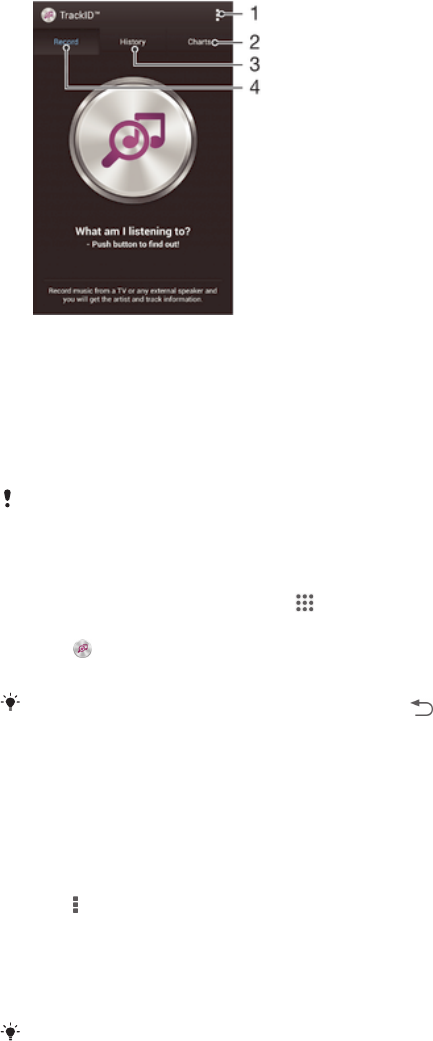
1 View TrackID options
2 View current music charts
3 View the search result history
4 Record and identify music
The TrackID™ application and the TrackID™ service are not supported in all countries/regions,
or by all networks and/or service providers in all areas.
To identify music using TrackID™ technology
1From your Home screen, tap
2Find and tap TrackID™, then hold your device towards the music source.
3Tap . If the track is recognised by the TrackID™ service, the results appear
on the screen.
To return to the TrackID™ start screen, press .
To view TrackID™ charts
•Open the TrackID™ application, then tap Charts. A chart from your own region
is shown.
To view TrackID™ charts from another region
1Open the TrackID™ application, then tap Charts.
2Tap > Regions and then select a country or region.
To buy a track recognised by the TrackID™ application
1After a track has been recognised by the TrackID™ application, tap Download.
2Follow the instructions in your device to complete your purchase.
You can also select a track to buy by opening the History or Charts tabs from the TrackID™
start screen.
To share a track
1After a track has been recognised by the TrackID™ application, tap Share,
then select a sharing method.
2Follow the instructions on your device to complete the procedure.
To view artist information for a track
•After a track has been recognised by the TrackID™ application, tap Artist info.
To delete a track from the track history
1Open the TrackID™ application, then tap History.
2Tap a track title, then tap Delete.
3Tap Yes to confirm.
66
This is an Internet version of this publication. © Print only for private use.

Music Unlimited online service
Music Unlimited is a subscription-based service that offers access to millions of
songs over a mobile network or Wi-Fi® connection. You can manage and edit your
personal music library in the cloud from a variety of devices, or sync your playlists
and music using a PC that runs the Windows® operating system. Go to
www.sonyentertainmentnetwork.com
for more information.
Sony Entertainment Network with Video Unlimited and Music Unlimited is not available in every
market. Separate subscription required. Additional terms and conditions apply.
To get started with Music Unlimited
1Open the WALKMAN home screen.
2Tap Music Unlimited, then follow the on-screen instructions to get started with
the Music Unlimited service.
67
This is an Internet version of this publication. © Print only for private use.

FM radio
Listening to the radio
The FM radio in your device works like any FM radio. For example, you can browse
and listen to FM radio stations and save them as favourites. You must connect a
wired headset or headphones to your device before you can use the radio. This is
because the headset or headphones act as an antenna. After one of these devices is
connected, you can then switch the radio sound to the speaker, if desired.
1 Favourites list
2 Radio on/off button
3 View menu options
4 Tuned frequency
5 Save or remove a channel as a favourite
6 Tuning dial
7 Move down the frequency band to search for a channel
8 Move up the frequency band to search for a channel
9 A saved favourite channel
To listen to the FM radio
1Connect a headset or a set of headphones to your device.
2From your Home screen, tap .
3Find and tap FM radio . The available channels appear as you scroll through
the frequency band.
When you start the FM radio, available channels appear automatically. If a channel has RDS
information, it appears a few seconds after you start listening to the channel.
To move between radio channels
•Flick your finger up or down along the frequency band.
To start a new search for radio channels
1When the radio is open, press .
2Tap Search for channels. The radio scans the whole frequency band, and all
available channels are displayed.
68
This is an Internet version of this publication. © Print only for private use.

To switch the radio sound to the speaker
1When the radio is open, press .
2Tap Play in speaker.
To switch the sound back to the wired headset or headphones, press and tap Play in
headphones.
To identify a song on the FM radio using TrackID™
1While the song is playing on your device's FM radio, press , then select
TrackID™.
2A progress indicator appears while the TrackID™ application samples the
song. If successful, you are presented with a track result, or a list of possible
tracks.
3Press to return the FM Radio.
The TrackID™ application and the TrackID™ service are not supported in all countries/regions,
or by all networks and/or service providers in all areas.
Favourite radio channels
To save a channel as a favourite
1When the radio is open, navigate to the channel that you want to save as a
favourite.
2Tap .
3Enter a name and select a colour for the channel, then press Save.
To listen to a favourite radio channel
1Tap .
2Select an option.
To remove a channel as a favourite
1When the radio is open, navigate to the channel that you want to remove.
2Tap , then tap Delete.
Sound settings
To switch between mono and stereo sound mode
1When the radio is open, press .
2Tap Enable stereo sound.
3To listen to the radio in mono sound mode again, press and tap Force mono
sound.
To select the radio region
1When the radio is open, press .
2Tap Set radio region.
3Select an option.
To adjust the Visualiser
1When the radio is open, tap .
2Tap Visualiser.
3Select an option.
69
This is an Internet version of this publication. © Print only for private use.
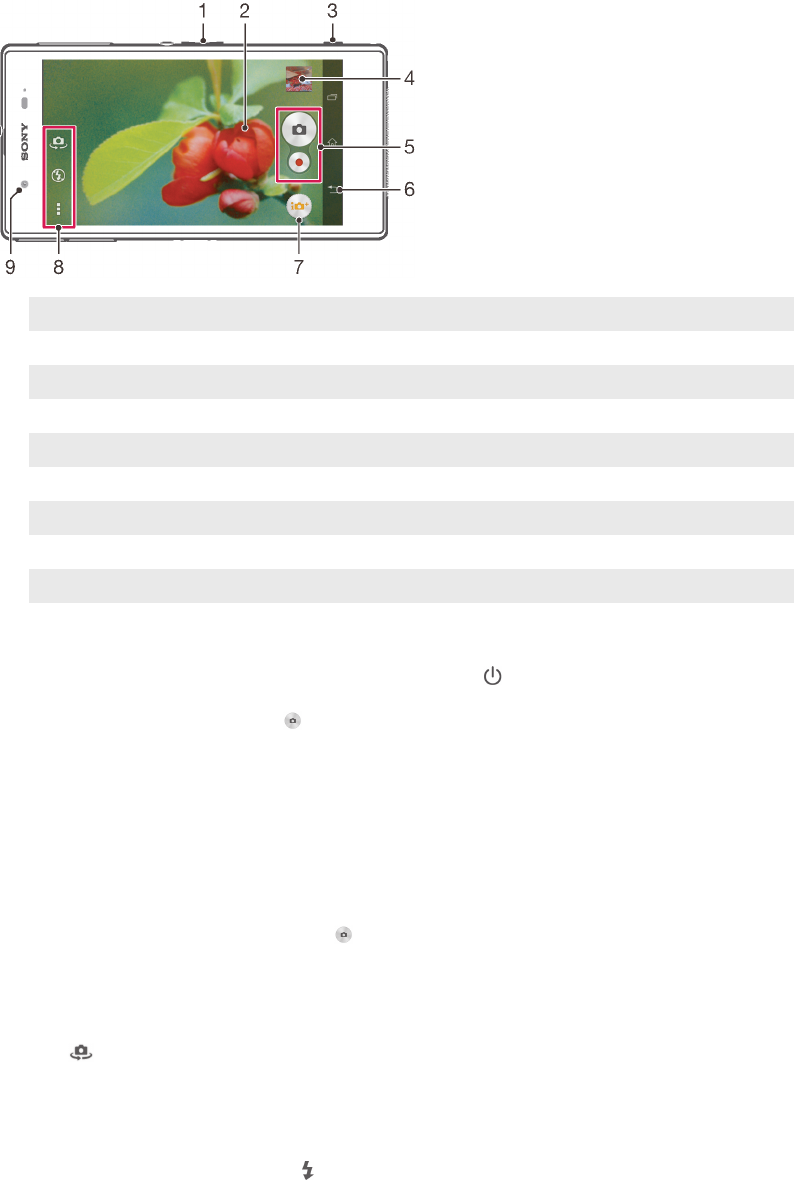
Camera
Taking photos and recording videos
1 Zoom in or out
2 Main camera screen
3 Camera key – Activate the camera/Take photos/Record videos
4 View photos and videos
5 Take photos or record video clips
6 Go back a step or exit the camera
7 Capturing mode settings icon
8 Camera settings icon and shortcut icons
9 Front camera
To take a photo from the lock screen
1To activate the screen, briefly press the power key .
2To activate the camera, swipe to the left in the upper part of the screen.
3After the camera opens, tap .
To take a photo using the camera key
1Activate the camera.
2Press the camera key fully down.
To take a photo by tapping the on-screen camera button
1Activate the camera.
2Point the camera towards the subject.
3Tap the on-screen camera button . The photo is taken as soon as you
release your finger.
To take a self-portrait using the front camera
1Activate the camera.
2Tap .
3To take the photo, press the camera key. The photo is taken as soon as you
release your finger.
To use the still camera flash
1When the camera is open, tap .
2Select your desired flash setting.
3Take the photo.
70
This is an Internet version of this publication. © Print only for private use.

To record a video using the camera key
1Activate the camera.
2Tap , and select .
3If the video camera is not selected, tap .
4To start recording a video, press the camera key.
5To stop recording, press the camera key again.
To record a video by tapping the screen
1Activate the camera.
2Point the camera towards the subject.
3Tap to start recording.
4Tap to stop recording.
This function is only available in Superior auto capturing mode.
To view your photos and videos
1Activate the camera, then tap a thumbnail to open a photo or video.
2Flick left or right to view your photos and videos.
To delete a photo or recorded video
1Browse to the photo or video that you want to delete.
2Tap the screen to make appear.
3Tap .
4Tap Delete to confirm.
Face detection
You can use face detection to bring an off-centre face into focus. The camera
automatically detects up to five faces, indicated by white frames. A yellow frame
shows which face has been selected for focus. Focus is set to the face closest to the
camera. You can also tap one of the frames to select which face should be in focus.
To turn on face detection
1Activate the camera.
2Tap , then select .
3Tap , then tap .
4Tap Focus mode > Face detection.
To take a photo using face detection
1When the camera is open and Face detection turned on, point the camera at
your subject. Up to five faces can be detected, and each detected face is
framed.
2Press the camera key halfway down. A yellow frame shows which face is in
focus.
3To take the photo, press the camera key fully down.
Using Smile Shutter™ to capture smiling faces
Use Smile Shutter™ technology to photograph a face just as it smiles. The camera
detects up to five faces and selects one face for smile detection and auto focus.
When the selected face smiles, the camera automatically takes a photo.
To turn on Smile Shutter™
1Activate the camera.
2Tap , then tap
3Tap Smile Shutter and select a smile level.
71
This is an Internet version of this publication. © Print only for private use.

To take a photo using Smile Shutter™
1When the camera is open and Smile Shutter™ is turned on, point the camera
at your subject. The camera selects which face to focus on.
2The face selected appears inside a coloured frame and the photo is taken
automatically.
3If no smile is detected, press the camera key to take the photo manually.
Adding the geographical position to your photos
Turn on geotagging to add the approximate geographical location (a geotag) to
photos when you take them. The geographical location is determined either by
wireless networks (mobile or Wi-Fi® networks) or GPS technology.
When appears on the camera screen, geotagging is turned on but the
geographical position has not been found. When appears, geotagging is turned on
and the geographical location is available, so your photo can get geotagged. When
neither of these two symbols appears, geotagging is turned off.
To turn on geotagging
1From your Home screen, tap .
2Tap Settings > Location services.
3Drag the slider beside Access to my location to the right.
4Activate the camera.
5Tap , then tap .
6Drag the slider beside Geotagging to the right.
7Tap OK.
General camera settings
Capturing mode settings overview
Superior auto
Optimise your settings to suit any scene.
Manual
Adjust camera settings manually.
Timeshift burst
Shift back and forth in time to enjoy and share your favourite moments.
Picture effect
Apply effects to photos.
AR effect
Take photos with virtual scenes and characters.
Find more information about what you see in the viewfinder.
Social live
Broadcast live video to Facebook™.
Sweep Panorama
Use this setting to take wide-angle, panoramic photos. Just press the camera key and move the
camera steadily from one side to the other.
Background defocus
Take photos with beautiful background blur like a DSLR camera.
Info-eye™
The Info-eye™ application helps you search for information about things around you
using your camera viewfinder. For example, you can snap a photo of a landmark and
receive information about it right on your screen. Or you can take a photo of a book
or scan a QR code and get background information instantly.
Info-eye™ can only recognise the selected landmarks or objects.
72
This is an Internet version of this publication. © Print only for private use.
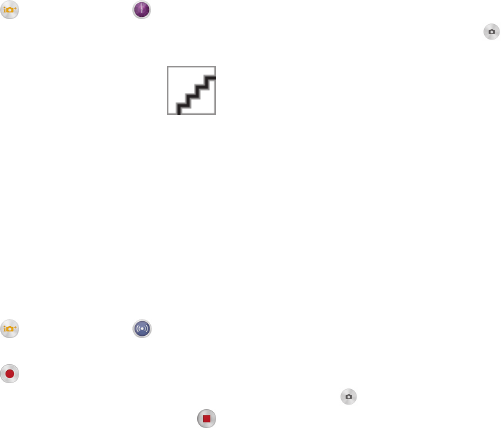
AR effect
You can apply AR (augmented reality) effects to your photos and make them more
fun. This setting lets you integrate 3D scenes into your photos as you take them. Just
select the scene you want and adjust its position in the viewfinder.
Timeshift burst
The camera takes a burst of 61 photos in a window of two seconds – one second
before and after you press the camera key. So you can go back and find the perfect
image.
To take a photo using Timeshift burst
1Activate the camera.
2Tap , then select .
3To take the photo, press the camera key fully down or tap .
4The photos appear in thumbnail view. To open a thumbnail, tap it.
5To save the photo, tap .
Social live
Social live is a camera shooting mode that lets you stream video live to your
Facebook™ page. You just need to have an active internet connection and be logged
into Facebook™. Videos can be up to 10 minutes long.
To broadcast live video using Social live
1Activate the camera.
2Tap , then select .
3Log in to your Facebook™ account.
4Tap to start broadcasting.
5To take a photo during the broadcast, tap .
6To stop broadcasting, tap .
Quick launch
Use Quick launch settings to launch the camera when the screen is locked.
Launch only
When this setting is activated, you can launch the camera when the screen is locked by pressing and
holding down the camera key.
Launch and capture
When this setting is activated, you can launch the camera and capture a photo automatically when the
screen is locked by pressing and holding down the camera key.
Launch and record video
When this setting is activated, you can launch the camera and start capturing video when the screen is
locked by pressing and holding down the camera key.
Off
Geotagging
Tag photos with details of where you took them.
Touch capture
Identify a particular focus area by touching the camera screen with your finger. The
photo is taken as soon as you release your finger. This setting is only available when
focus mode is set to touch focus.
Shutter sound
Choose to turn on or turn off the shutter sound when you record a video.
73
This is an Internet version of this publication. © Print only for private use.

Data storage
You can choose to save your data either to a removable SD card or to your device's
internal storage.
Internal storage
Photos or videos are saved on the device memory.
SD card
Photos or videos are saved on the SD card.
White balance
This function adjusts the colour balance according to the lighting conditions. The
white balance setting icon is available on the camera screen.
Auto
Adjusts the colour balance automatically to suit the lighting conditions.
Incandescent
Adjusts the colour balance for warm lighting conditions, such as under light bulbs.
Fluorescent
Adjusts the colour balance for fluorescent lighting.
Daylight
Adjusts the colour balance for sunny outdoor conditions.
Cloudy
Adjusts the colour balance for a cloudy sky.
This setting is only available in Manual capturing mode.
Still camera settings
To adjust the still camera settings
1Activate the camera.
2To display all settings, tap .
3Select the setting that you want to adjust, then edit as desired.
Still camera settings overview
Resolution
Choose between several resolutions and aspect ratios before taking a photo. A photo
with a higher resolution requires more memory.
20MP
5248×3936(4:3)
20 megapixel resolution with 4:3 aspect ratio. Suitable for photos you want to view on non-widescreen
displays or print in high resolution.
8MP
3264×2448(4:3)
8 megapixel resolution with 4:3 aspect ratio. Suitable for photos you want to view on non-widescreen
displays or print in high resolution.
8MP
3840×2160(16:9)
8 megapixel resolution with 16:9 aspect ratio. Suitable for photos you want to view on widescreen
displays.
3MP
2048×1536(4:3)
3 megapixel resolution with 4:3 aspect ratio. Suitable for photos you want to view on non-widescreen
displays or print in high resolution.
2MP
1920×1080(16:9)
74
This is an Internet version of this publication. © Print only for private use.

2 megapixel resolution with 16:9 aspect ratio. Suitable for photos you want to view on widescreen
displays.
This setting is only available in Manual capturing mode.
Self-timer
With the self-timer you can take a photo without holding the device. Use this function
to take self-portraits, or group photos where everyone can be in the photo. You can
also use the self-timer to avoid shaking the camera when taking photos.
On (10 s.)
Set a 10-second delay from when you tap the camera screen until the photo is taken.
On (2 s.)
Set a 2-second delay from when you tap the camera screen until the photo is taken.
Off
The photo is taken as soon as you tap the camera screen.
Smile Shutter™
Use the Smile Shutter™ function to determine what kind of smile the camera reacts
to before taking a photo.
Focus mode
The focus function controls which part of a photo should be sharp. When continuous
autofocus is on, the camera keeps adjusting focus so that the area within the yellow
focus frame stays sharp.
Single auto focus
The camera automatically focuses on the selected subject. Continuous autofocus is on. Touch and hold
the camera screen until the yellow focus frame turns blue, indicating that the focus is set. The photo is
taken when you release your finger.
Multi auto focus
The focus is automatically set on several areas of the image. Touch and hold the camera screen until the
yellow focus frame turns blue, indicating that the focus is set. The photo is taken when you release your
finger. Continuous autofocus is off.
Face detection
The camera automatically detects up to five human faces, indicated by frames on the screen. The
camera automatically focuses on the nearest face. You can also select which face to focus on by tapping
it on the screen. When you tap the camera screen, a blue frame shows which face is selected and in
focus. Face detection cannot be used for all scene types. Continuous autofocus is on.
Touch focus
Touch a specific area on the camera screen to set the area of focus. Continuous autofocus is off. Touch
and hold the camera screen until the yellow focus frame turns blue, indicating that the focus is set. The
photo is taken when you release your finger.
Object tracking
When you select an object by touching it in the viewfinder, the camera tracks it for you.
This setting is only available in Manual capturing mode.
ISO
You can reduce image blurring caused by dark conditions or moving subjects by
increasing the ISO sensitivity.
Auto
Sets the ISO sensitivity automatically.
50
Sets the ISO sensitivity to 50.
100
Sets the ISO sensitivity to 100.
200
75
This is an Internet version of this publication. © Print only for private use.

Sets the ISO sensitivity to 200.
400
Sets the ISO sensitivity to 400.
800
Sets the ISO sensitivity to 800.
1600
Sets the ISO sensitivity to 1600.
3200
Sets the ISO sensitivity to 3200.
This setting is only available in Manual capturing mode.
Metering
This function automatically determines a well-balanced exposure by measuring the
amount of light striking the image you want to capture.
Centre
Adjusts the exposure to the centre of the image.
Average
Calculates the exposure based on the amount of light striking the whole image.
Spot
Adjusts the exposure in a very small part of the image that you want to capture.
This setting is only available in Manual capturing mode.
Image stabiliser
When taking a photo, it can be difficult to hold the device steady. The stabiliser helps
you by compensating for small movements of the hand.
This setting is only available in Manual capturing mode.
Preview
You can choose to preview photos or videos just after you shoot them.
Unlimited
The preview of the photo or video appears after you shoot it.
5 seconds
The preview of the photo or video apears for 5 seconds after you shoot it.
3 seconds
The preview of the photo or video appears for 3 seconds after you shoot it.
Edit
The photo or video opens for editing after you shoot it.
Off
The photo or video is saved after you shoot it, and no preview appears.
Face registration
You can register faces with the Camera application so that the viewfinder
automatically focuses on these faces when they appear in the viewfinder.
Flash
Use the flash to take photos when lighting conditions are poor or when there is a
backlight. The following options are available when you tap the flash icon in the
camera screen:
Auto
76
This is an Internet version of this publication. © Print only for private use.

The camera automatically determines if the lighting conditions require the use of a flash.
Fill flash
Use this setting when the background is brighter than the subject. This removes unwanted dark
shadows.
Red-eye reduction
Reduces the red colour of eyes when taking a photo.
Off
The flash is turned off. Sometimes photo quality can be better without the flash, even if lighting
conditions are poor. Taking a good photo without using the flash requires a steady hand. Use the
self-timer to avoid blurred photos.
Torch
A torch or camera light is turned on when you take photos.
Video camera settings
To adjust the video camera settings
1Activate the camera.
2Tap one of the settings icons on the screen.
3To display all settings, tap .
4Select the setting that you want to adjust, then make your changes.
Video camera settings overview
Video resolution
Adjust the video resolution for different formats.
Full HD
1920×1080(16:9)
Full HD (Full High Definition) format with 16:9 aspect ratio. 1980×1080 pixels.
HD
1280×720(16:9)
HD (High Definition) format with 16:9 aspect ratio. 1280×720 pixels.
MMS
Record videos suitable for sending in multimedia messages. The recording time of this video format is
limited to fit in a multimedia message.
This setting is only available in Manual capturing mode.
Self-timer
With the self-timer you can record a video without holding the device. Use it to record
group videos where everyone can be in the video. You can also use the self-timer to
avoid shaking the camera when recording videos.
On (10 s.)
Set a 10-second delay from when you tap the camera screen until the video begins to record.
On (2 s.)
Set a 2-second delay from when you tap the camera screen until the video begins to record.
Off
The video begins to record as soon as you tap the camera screen.
Smile Shutter™(video)
Use the Smile Shutter™ function to determine what kind of smile the camera reacts
to before recording a video.
77
This is an Internet version of this publication. © Print only for private use.

Focus mode
The focus setting controls which part of a video should be sharp. When continuous
autofocus is on, the camera keeps adjusting focus so that the area within the white
focus frame stays sharp.
Single auto focus
The camera automatically focuses on the selected subject. Continuous autofocus is on.
Face detection
The camera automatically detects up to five human faces, indicated by frames on the screen. The
camera automatically focuses on the nearest face. You can also select which face to focus on by tapping
it on the screen. When you tap the camera screen, a yellow frame shows which face is selected and in
focus. Face detection cannot be used for all scene types. Continuous autofocus is on.
Object tracking
When you select an object by touching it in the viewfinder, the camera tracks it for you.
This setting is only available in Manual capturing mode.
HDR video
Use the video HDR (High-Dynamic Range) setting to record a video against strong
back light or in conditions where the contrast is sharp. Video HDR compensates for
the loss of detail and produces a picture that is representative of both dark and bright
areas.
This setting is only available in Manual capturing mode.
Metering
This function automatically determines a well-balanced exposure by measuring the
amount of light striking the image you want to capture.
Centre
Adjusts the exposure to the centre of the image.
Average
Calculates the exposure based on the amount of light striking the whole image.
Spot
Adjusts the exposure in a very small part of the image that you want to capture.
This setting is only available in Manual capturing mode.
SteadyShot™
When recording a video, it can be difficult to hold the device steady. The stabiliser
helps you by compensating for small movements of the hand.
Microphone
Select whether to pick up the surrounding sound when recording videos.
Flash
Use the flash light to record videos when lighting conditions are poor or when there is
a backlight. The video flash icon is only available on the video camera screen.
Note that the video quality can sometimes be better without a light even if lighting
conditions are poor.
On
Off
78
This is an Internet version of this publication. © Print only for private use.

Album
Viewing photos and videos
Use the Pictures tab in the Album application to view photos and play videos that
you’ve taken with your camera, or to view similar content that you've saved to your
device. All photos and videos are displayed in a chronologically ordered grid.
1 View photos and videos in the Pictures tab
2 View photos and videos in the My albums tab
3 View menu options
4 The date of items in the group
5 Tap a photo or video to view it
6 Scroll up or down to view content
To view photos and videos
1From your Home screen, tap .
2Find and tap Album.
3Tap a photo or video to view it.
4Flick left to view the next photo or video. Flick right to view the previous photo
or video.
If the screen orientation does not change automatically when you turn your device sideways,
mark the Auto-rotate screen checkbox under Settings > Display.
To change the size of the thumbnails
•When viewing thumbnails of photos and videos in Album, spread two fingers
apart to zoom in, or pinch two fingers together to zoom out.
To zoom a photo
•When you are viewing a photo, spread two fingers apart to zoom in, or pinch two
fingers together to zoom out.
To watch a slideshow of your photos
1When you are viewing a photo, tap the screen to display the toolbars, then tap
> Slideshow to start playing all the photos in an album.
2Tap a photo to end the slideshow.
79
This is an Internet version of this publication. © Print only for private use.

To watch a slideshow of your photos with music
1When you are viewing a photo, tap the screen to display the toolbars, then tap
> SensMe™ slideshow.
2Select the music and theme that you want to use for the slideshow, then tap
. The Album application analyses your photos and uses SensMe™ music
data to play a slideshow.
3To pause playing, tap the screen to display the controls, then tap .
To play a video
1Open the Pictures tab or the My albums tab in Album.
2Using grid view or list view, locate the video that you want to open.
3Tap the video to play it.
4If the playback controls are not displayed, tap the screen to display them. To
hide the controls, tap the screen again.
To pause a video
1When a video is playing, tap the screen to display the controls.
2Tap .
To fast forward and rewind a video
1When a video is playing, tap the screen to display the controls.
2Drag the progress bar marker left to rewind, or right to fast forward.
To adjust the volume of a video
•Press the volume key.
Sharing and managing photos and videos
You can share photos and videos that you’ve stored on your device. You can also
manage them in different ways. For example, you can work with photos in batches,
delete photos and link them to contacts.
You might not be able to copy, send or transfer copyright-protected items. Also, some items
may not send if the file size is too large.
To share a photo or video
1In Album, find and tap the photo or video that you want to share.
2Tap the screen to display the toolbars, then tap .
3Tap the application that you want to use to share the photo, then follow the
steps to send it.
To use a photo as a contact picture
1When you are viewing a photo, tap the screen to display the toolbars, then tap
> Use as > Contact picture.
2If asked, select Contacts > Just once, then select a contact.
To use a photo as wallpaper
1When you are viewing a photo, tap the screen to display the toolbars, then tap
> Use as > Wallpaper.
2Follow the instructions on the screen.
To rotate a photo
1When you are viewing a photo, tap the screen to display the toolbars, then tap
.
2Select Rotate. The photo is saved in the new orientation.
To delete a photo or video
1When you are viewing a photo, tap the screen to display the toolbars, then tap
.
2Tap Delete.
80
This is an Internet version of this publication. © Print only for private use.

To work with batches of photos or videos in Album
1When viewing thumbnails of photos and videos in Album, tap , then tap Select
items.
2Tap the items that you want to work with. Selected items are indicated by a
blue frame.
3Use the tools in the toolbars to work with your selected items.
To activate selection mode, you can also touch and hold an item until its frame turns blue.
Then you can tap other items to select them.
Analysing photos with faces in Album
You can analyse any photos on your device that feature people's faces. Once
activated, the photo analysis feature stays on, and new photos get analysed as they
are added. After running an analysis, you can then group all photos of the same
person in one folder.
To turn on the photo analysis feature
1From your Home screen, tap .
2Find and tap Album > My albums > Faces.
3All photos on your device get analysed and grouped in the Unnamed faces
folder accordingly.
To name a face
1In the Faces tile, tap the Unnamed faces folder, then browse to the Other
faces folder and choose the face that you want to name.
2Tap Add name.
3Type a name, then tap Done > Add as new person.
To edit a face name
1When you are viewing a face in full screen view, tap the screen to display the
toolbars, then tap > Edit name tags.
2Tap OK.
3Tap the name of the face that you want to edit.
4Edit the name, then tap Done >Add as new person.
Editing photos with the Photo editor application
You can edit and apply effects to original photos that you’ve taken with your camera.
For example, you can change the light effects. After you save the edited photo, the
original unchanged version of the photo remains on your device.
To edit a photo
•When you are viewing a photo, tap the screen to display the toolbars, then tap
.
To crop a photo
1When you are viewing a photo, tap the screen to display the toolbars, then tap
.
2If prompted, select Photo editor > Just once.
3Tap > Crop.
4Tap to select an option.
5To adjust the crop frame, touch and hold the edge of the crop frame. When the
squares at the edges disappear, drag inward or outward to resize the frame.
6To resize all sides of the crop frame at the same time, touch and hold one of
the four corners to make the squares at the edges disappear, then drag the
corner accordingly.
7To move the crop frame to another area of the photo, touch and hold inside the
frame, then drag it to the desired position.
8Tap Apply Crop.
9To save a copy of the photo as you cropped it, tap Save.
81
This is an Internet version of this publication. © Print only for private use.

To apply special effects to a photo
1When you are viewing a photo, tap the screen to display the toolbars, then tap
.
2If prompted, select Photo editor > Just once.
3Tap , then select an option.
4To save a copy of the edited photo, tap Save.
To improve a photo using advanced settings
1When you are viewing a photo, tap the screen to display the toolbars, then tap
.
2If prompted, select Photo editor > Just once.
3Tap , then select an option.
4To save a copy of the edited photo, tap Save.
To adjust the light settings for a photo
1When you are viewing a photo, tap the screen to display the toolbars, then tap
.
2If prompted, select Photo editor > Just once.
3Tap , then select an option.
4To save a copy of the edited photo, tap Save.
To set the saturation level of colours in a photo
1When you are viewing a photo, tap the screen to display the toolbars, then tap
.
2If prompted, select Photo editor > Just once.
3Tap , then select an option.
4To save a copy of the edited photo, tap Save.
Photo albums
The My albums tab in the Album application gathers together all your photo albums,
including albums of photos and videos taken with the camera as well as content that
you share online via services such as PlayMemories, Picasa and Facebook. Once you
are logged in to such services, you can manage content, comment on photos and
videos, and view comments from friends. From the Album application, you can also
add geotags to photos, perform basic editing tasks, and use methods such as
Bluetooth® wireless technology, email, and messaging to share content.
1 View photos and videos using the PlayMemories online service
2 View photos and videos on Facebook™
3 View photos and videos in Picasa™
4 View photos using the Flickr™ online service
5 View all photos and videos taken with your device’s camera
82
This is an Internet version of this publication. © Print only for private use.

6 View all photos and videos saved to your device's internal storage
7 View your photos in globe mode
8 View your photos on a map
9 View all photos and videos saved to the removable memory card
10 View all photos with faces
The PlayMemories online service is not available in all countries or regions.
To view photos from online services in Album
1From your Home screen, tap .
2Find and tap Album > My albums.
3Tap the desired online service.
4Tap Connect. All available online albums that you have uploaded to the service
are displayed.
5Tap any album to view its content, then tap a photo in the album.
6Flick left to view the next photo or video. Flick right to view the previous photo
or video.
To view and add comments to online album content
1When viewing a photo from an online album, tap the screen to display the
toolbars, then tap to view the comments.
2Enter your comments in the input field, then tap Post.
To "Like" a photo or video on Facebook™
•While viewing a photo or video from one of your Facebook™ albums, tap the
screen to display the toolbars, then tap to show that you "Like" the item on
Facebook™.
Viewing your photos on a map
Adding location information to photos is referred to as geotagging. You can view and
tag your photos on a map and show friends and family where you were when you
took a particular photo. See
Adding the geographical position to your photos
on
page 72 for more information.
If you have turned on location detection and activated geotagging in the camera, you can tag
your photos directly for map viewing at a later stage.
83
This is an Internet version of this publication. © Print only for private use.

1 Search a location on the map.
2 View menu options.
3 A group of photos and/or videos geotagged with the same location.
4 Double tap to zoom in. Pinch to zoom out. Drag to view different parts of the map.
5 Thumbnails of the selected group of photos and/or videos. Tap an item to view it in full screen.
If several photos were taken at the same location, only one of them appears on the map. The
total number of photos appears in the top right corner, for example, . To view all photos in
the group, tap the cover photo and then tap one of the thumbnails at the bottom of the
screen.
To add a geotag to a photo
1When you are viewing a photo, tap the screen to display the toolbars, then tap
Tap to set location to open the map screen.
2Find and tap the desired location to put the photo on the map.
3To adjust the location of the photo, tap the location on the map to where you
want to move the photo.
4When you are finished, tap OK to save the geotag and return to the photo
viewer.
To view geotagged photos on a map
1From your Home screen, tap .
2Find and tap Album > My albums > Maps.
3Tap a photo to view it in full screen.
To view geotagged photos on a globe
1From your Home screen, tap .
2Find and tap Album > My albums > Globe.
3Tap a photo to view it in full screen.
To change the geotag of a photo
1When viewing a photo on the map in Album, touch and hold the photo until its
frame turns blue, then tap the desired location on the map.
2Tap OK.
To change the map view
•When viewing the map in Album, tap , then select Classic view or Satellite view.
84
This is an Internet version of this publication. © Print only for private use.

Videos
Watching videos in the Movies application
Use the Movies application to play movies and other video content that you’ve saved
or downloaded to your device. The Movies application also helps you get poster art,
plot summaries, genre info and director details for each movie. You can also play
your movies on other devices that are connected to the same network.
Videos taken with your device's camera are displayed in the Album application, not in the
Movies application.
Some video files may not be playable in the Movies application.
1 Open the Video Unlimited application
2 View menu options
3 Tap to play your most recently watched video
4 Browse all videos downloaded or saved to your device
5 Tap to play saved or downloaded video files
6 Tap to view all videos in Video Unlimited
7 Tap to view details of a video in Video Unlimited
Sony Entertainment Network with Video Unlimited and Music Unlimited is not available in every
market. Separate subscription required. Additional terms and conditions apply.
To play a video in Movies
1From your Home screen, tap , then find and tap Movies.
2Find and tap the video that you want to play. If the video is not displayed on
the screen, tap All in the My Collection tab, then find and tap the video that
you want to play.
3To display or hide the controls, tap the screen.
4To pause playing, tap . To resume playing, tap .
5To rewind, drag the progress bar marker to the left. To fast forward, drag the
progress bar marker to the right.
85
This is an Internet version of this publication. © Print only for private use.

To play a video in full screen mode
1When a video is playing, tap the screen to display the controls.
2Tap .
You can only switch to full screen mode if the video is not playing in full screen mode already.
To play the video in its original size, tap .
To play a video on an external device
1When the video is playing, tap the screen to display all the controls.
2Tap > Throw.
3Select an external device on which to play the video. If there is no external
device available, follow the on-screen instructions to add one.
To change settings in Movies
1From your Home screen, tap , then find and tap Movies.
2Tap , then change the settings as desired.
To change the sound settings while a video is playing
1While a video is playing, tap the screen to display the controls.
2Tap , then tap Sound settings.
3Mark the checkboxes for the sound settings that you want to activate.
4When you're finished, tap OK.
To share a video
1When a video is playing, tap , then tap Share.
2In the menu that opens, tap the application that you want to use to share the
selected video, then follow the relevant steps to send it.
Transferring video content to your device
Before you start using the Movies application, it’s a good idea to transfer movies, TV
shows and other video content to your device from other devices, such as a
computer. There are several ways to transfer your content:
•Connect your device to a computer using a USB cable and drag and drop the video
files directly using the file manager application on the computer. See
Connecting your
device to a computer
on page 95.
•If you have a PC, use the Media Go™ application from Sony™ to organise content
and transfer video files to your device via the PC. To learn more and download the
Media Go™ application, go to http://mediago.sony.com/enu/features.
•If your computer is an Apple® Mac®, you can use Sony™ Bridge for Mac to transfer
video files from iTunes to your device. To learn more and download Sony™ Bridge
for Mac, go to
www.sonymobile.com/global-en/tools/bridge-for-mac/
.
86
This is an Internet version of this publication. © Print only for private use.

Managing video content
To get movie information manually
1Make sure that your device has an active data connection.
2From your Home screen, tap , then find and tap Movies.
3Tap All in the My Collection tab to browse to the thumbnail of a file that you
want to get information about.
4Touch and hold the thumbnail for the video, then tap Search for info.
5If prompted, allow your device to download video details using your mobile
data connection.
6In the search field, enter keywords for the video, then tap the confirm key on
the keyboard. All matches are displayed in a list.
7Select a search result, then tap Done. The download of the information begins.
You can get information about newly added videos automatically every time the Movies
application opens if you mark the Get video details checkbox under Settings. Data
transmission charges may apply.
If the downloaded information is not correct, search again using different keywords.
To clear information about a video
1From your Home screen, tap , then find and tap Movies.
2Tap All in the My Collection tab to browse to the video that you want to edit.
3Touch and hold the video thumbnail, then tap Clear info.
To delete a video
1From your Home screen, tap , then find and tap Movies.
2Tap All in the My Collection tab to browse to the video that you want to delete.
3Touch and hold the video thumbnail, then tap Delete from the list that appears.
4Tap Delete again to confirm.
Video Unlimited service
Use the Video Unlimited service to rent and buy movies or TV shows that you can
view not only on your Android™ device, but also on a PC, PlayStation® Portable
(PSP®), PlayStation® 3 or PlayStation® Vita. Select your pick from the latest
Hollywood releases, action movies, comedies, classics, and a range of other
categories.
You need to create a Video Unlimited account if you want to buy or rent movies
through the Video Unlimited service. If you already have a PlayStation® network
account or a Sony Entertainment Network account, then you can use that account
instead.
Sony Entertainment Network with Video Unlimited and Music Unlimited is not available in every
market. Separate subscription required. Additional terms and conditions apply.
To get started with Video Unlimited
1From your Home screen, tap .
2Find and tap .
3If you are starting Video Unlimited for the first time, tap Continue in the
Welcome screen and enter your birth date if required, then tap Continue again
to go to the main screen of Video Unlimited.
4Tap > Sign In, then follow the on-screen instructions to sign in to your
account, or create a new account, to buy or rent movies.
87
This is an Internet version of this publication. © Print only for private use.

Connectivity
Sharing content with DLNA Certified™ devices
You can view or play media content saved to your device on other devices such as,
for example, a TV, or a computer. Such devices must be DLNA Certified™ by the
Digital Living Network Alliance and all devices must be connected to the same Wi-
Fi® network in order for content to be shared. You can also view or play content from
other DLNA Certified™ devices on your device.
After you set up the sharing of content between devices, you can, for example, listen
to music files stored on your home computer from your device, or view photos taken
with your device's camera on a large-screen TV.
Playing files from DLNA Certified™ devices on your device
When you play files from another DLNA Certified™ device on your device, this other
device acts as a server. In other words, it shares content over a network. The server
device must have its content sharing function enabled and give access permission to
your device. It also must be connected to the same Wi-Fi® network as your device.
To play a shared track on your device
1Make sure the devices that you want to share files with are connected to the
same Wi-Fi® network as your device.
2From your Home screen, tap , then find and tap WALKMAN.
3Select a device from the list of connected devices.
4Browse the folders of the connected device and select the track that you want
to play. The track starts playing automatically.
To play a shared video on your device
1Make sure the devices that you want to share files with are connected to the
same Wi-Fi® network as your device.
2From your Home screen, tap , then find and tap Movies.
3Select a device from the list of connected devices.
4Browse the folders of the connected device and select the video that you want
to play.
To view a shared photo on your device
1Make sure the devices that you want to share files with are connected to the
same Wi-Fi® network as your device.
2From your Home screen, tap .
3Find and tap Album > My albums. All your available online albums and
connected devices are displayed.
4Select a device from the list of connected devices.
5Browse the folders of the connected device and select a photo to view it.
Preparing to play content from your device on DLNA Certified™
devices
Before you can view or play media files from your device on other DLNA Certified™
devices, you must set up file sharing on your device. The devices that you share
content with are called client devices. For example, a TV, computer or tablet can act
as client devices. Your device works as a media server when it makes content
available to client devices. When you set up file sharing on your device, you must
also give access permission to client devices. After you do so, such devices appear
as registered devices. Devices that are waiting for access permission are listed as
pending devices.
88
This is an Internet version of this publication. © Print only for private use.

To set up file sharing with other DLNA Certified™ devices
1Connect your device to a Wi-Fi® network.
2From your Home screen, tap , then find and tap .
3Tap , then tap Media server.
4To turn on the Share content function, drag the slider. appears in the status
bar. Your device can now work as a media server.
5Connect your computer or other devices to the same Wi-Fi® network as your
device.
6A notification appears in the status bar of your device. Open the notification
and set the relevant access permissions for other devices.
The instructions described above may differ depending on the client devices used. Refer to
your client device User guide for more information. If the device cannot connect, check that
your Wi-Fi®network is working.
You can also access the Media server menu under Settings > Xperia™ Connectivity > Media
server settings. If you close the Media server view, the file sharing function stays running in
the background.
To stop sharing files with other DLNA Certified™ devices
1From your Home screen, tap , then find and tap .
2Tap , then tap Media server.
3Drag the slider to turn off the Share content function.
To set access permissions for a pending device
1From your Home screen, tap , then find and tap .
2Tap , then tap Media server.
3Select a device from the Pending devices list.
4Select an access permission level.
To change the name of a registered device
1From your Home screen, tap , then find and tap .
2Tap , then tap Media server.
3Select a device from the Registered devices list, then select Change name.
4Enter a new name for the device.
To change the access level of a registered device
1From your Home screen, tap , then find and tap .
2Tap , then tap Media server.
3Select a device from the Registered devices list.
4Tap Change access level and select an option.
To get help about sharing content with other DLNA Certified™ devices
1From your Home screen, tap , then find and tap .
2Tap , then tap Media server.
3Tap .
Playing files on a Digital Media Renderer device
Using DLNA™ technology, you can push media content saved on your device to
another device connected to the same Wi-Fi® network. The other device must be
able to function as a Digital Media Renderer (DMR) device, which means that it can
render, or play, content received from your device. A DMR device can be, for
example, a TV with DLNA function, or a PC running Windows® 7 or higher.
The settings for enabling the Digital Media Renderer may vary depending on the device used.
Refer to the user guide for the respective device for more detailed information.
Content with Digital Rights Management (DRM) cannot be played on a Digital Media Renderer
device using DLNA™ technology.
89
This is an Internet version of this publication. © Print only for private use.

To view photos or videos from your device on a DMR device
1Make sure that you have correctly set up the DMR device and that it is
connected to the same Wi-Fi® network as your device.
2From your Home screen, tap .
3Find and tap Album.
4Browse to and open the file that you want to view.
5Tap the screen to display the toolbars, then tap and select a DMR device to
share your content with. The selected files start playing in chronological order
on the device that you select.
6To disconnect from the DMR device, tap and select your device. The file
stops playing on the DMR device but continues playing on your device.
You can also share a video from the Movies application on your device by tapping the video
and then tapping .
To play a music track from your device on a DMR device
1Make sure that you have correctly set up the DMR device and that it is
connected to the same Wi-Fi® network as your device.
2From your Home screen, tap , then find and tap WALKMAN.
3Select a music category and browse to the track that you want to share, then
tap the track.
4Tap and select a DMR device to share your content with. The track plays
automatically on the device that you select.
5To disconnect from the DMR device, tap and select your device. The track
stops playing on the DMR device but continues playing on your device.
NFC
Use Near Field Communications (NFC) to share data with other devices, such as a
video, photo, web page address, music file or contact. You can also use NFC to scan
tags that give you more information about a product or service as well as tags that
activate certain functions on your device.
NFC is a wireless technology with a maximum range of one centimetre, so the
devices sharing data must be held close to each other. Before you can use NFC, you
must first turn on the NFC function, and the screen of your device must be active.
NFC may not be available in all countries and/or regions.
To turn on the NFC function
1From your Home screen, tap .
2Find and tap Settings > More….
3Mark the NFC checkbox.
90
This is an Internet version of this publication. © Print only for private use.
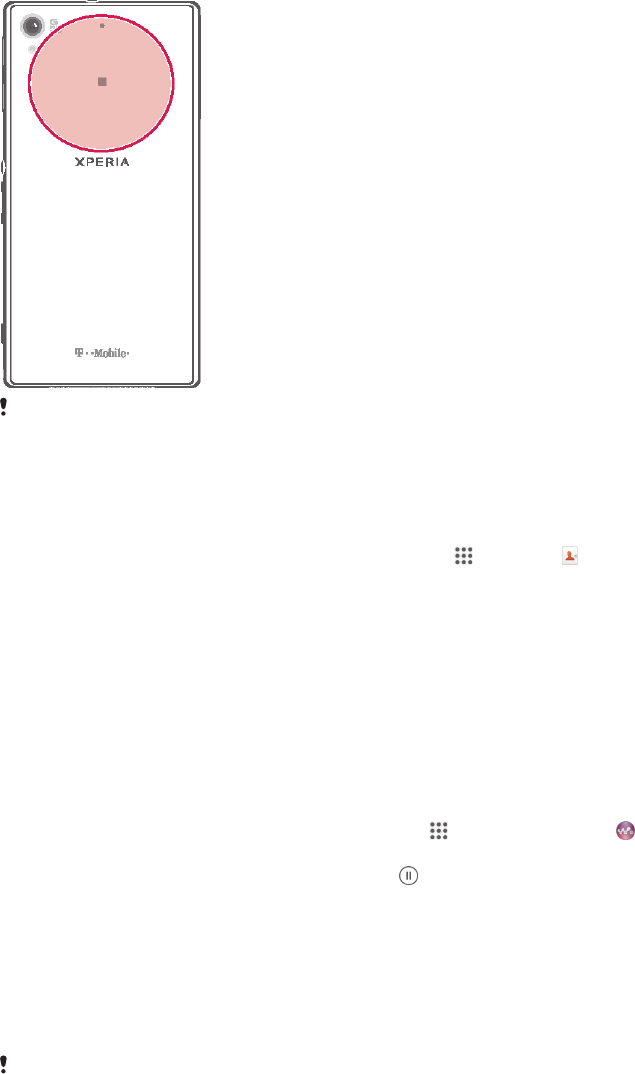
NFC detection area
The location of the NFC detection area is not the same on all devices. When sharing data with
another device using NFC, refer to the User guide of the other device for more information.
To share a contact with another device using NFC
1Make sure that both devices have the NFC function turned on, and that both
screens are active.
2To view contacts, go to your Home screen, tap , then tap .
3Tap the contact that you want to share.
4Hold your device and the receiving device back to back so that the NFC
detection areas of each device touch each other. When the devices connect,
they vibrate and play a short sound. A thumbnail of the contact appears.
5Tap the thumbnail to start the transfer.
6When the transfer is done, the contact information is displayed on the screen
of the receiving device and is also saved on the receiving device.
To share a music file with another device using NFC
1Make sure that both your device and the receiving device have the NFC
function turned on, and that both screens are active.
2To open the "WALKMAN™" application, tap , then find and tap .
3Select a music category and browse to the track you want to share.
4Tap the track to play it. You can then tap to pause the track. The transfer
works whether the track is playing or paused.
5Hold your device and the receiving device back to back so that the NFC
detection areas of each device touch each other. When the devices connect,
they vibrate and play a short sound. A thumbnail of the track appears.
6Tap the thumbnail to start the transfer.
7When the transfer is done, the music file plays immediately on the receiving
device. At the same time, the file is saved on the receiving device.
You might not be able to copy, send or transfer copyright-protected items.
91
This is an Internet version of this publication. © Print only for private use.

To share a photo or video with another device using NFC
1Make sure that both devices have the NFC function turned on, and that both
screens are active.
2To view photos and videos in your device, go to your Home screen, tap ,
then find and tap Album.
3Tap the photo or video that you want to share.
4Hold your device and the receiving device back to back so that the NFC
detection areas touch each other. When the devices connect, they vibrate and
play a short sound. A thumbnail of the photo or video appears.
5Tap the thumbnail to start the transfer.
6When the transfer is done, the photo or video is displayed on the screen of the
receiving device. At the same time, the item is saved on the receiving device.
You can also use NFC to share a video from the Movies application.
To share a web address with another device using NFC
1Make sure that both devices have the NFC function turned on, and that both
screens are active.
2From your Home screen, tap .
3To open the web browser, find and tap .
4Load the web page that you want to share.
5Hold your device and the receiving device back to back so that the NFC
detection areas touch each other. When the devices connect, they vibrate and
play a short sound. A thumbnail of the web page appears.
6Tap the thumbnail to start the transfer.
7When the transfer is done, the web page is displayed on the screen of the
receiving device.
Scanning NFC tags
Your device can scan various kinds of NFC tags. For example, it can scan embedded
tags on a poster, on a billboard advertisement, or beside a product in a retail store.
You can receive additional information, such as a web address.
To scan an NFC tag
1Make sure that your device has the NFC function turned on and that the screen
is active.
2Place your device over the tag so that the NFC detection area touches it. Your
device scans the tag and displays the content collected. Tap the content of the
tag to open it.
3To open the tag, tap it.
Connecting to an NFC compatible device
You can connect your device to other NFC compatible devices produced by Sony,
such as a speaker or a headphone. When establishing this kind of connection, refer
to the User guide of the compatible device for more information.
You may need to have Wi-Fi® or Bluetooth® activated on both devices for the connection to
work.
Bluetooth® wireless technology
Use the Bluetooth® function to send files to other Bluetooth® compatible devices, or
to connect to handsfree accessories. Turn on the Bluetooth® function in your device
and create wireless connections to other Bluetooth® compatible devices such as
computers, handsfree accessories, and phones. Bluetooth® connections work better
within 10 metres (33 feet), with no solid objects in between. In some cases you have
to manually pair your device with other Bluetooth® devices.
Interoperability and compatibility among Bluetooth® devices can vary.
92
This is an Internet version of this publication. © Print only for private use.

To turn on the Bluetooth® function and make your device visible
1Drag the status bar downwards, then tap .
2Tap the on-off switch beside Bluetooth to turn on the Bluetooth® function.
3Tap Bluetooth. Your device and a list of available Bluetooth® devices appear.
4Tap your device name to make your device visible to other Bluetooth® devices.
To adjust your device's visibility time to other Bluetooth® devices
1Drag the status bar downwards, then tap .
2Find and tap Bluetooth.
3Press and select Visibility timeout.
4Select an option.
Naming your device
You can give your device a name. This name is shown to other devices after you
have turned on the Bluetooth® function and your device is set to visible.
To give your device a name
1Make sure that the Bluetooth® function is turned on.
2Drag the status bar downwards, then tap .
3Find and tap Bluetooth.
4Tap and select Rename phone.
5Enter a name for your device.
6Tap Rename.
Pairing with another Bluetooth® device
When you pair your device with another device, you can, for example, connect your
device to a Bluetooth® headset or a Bluetooth® car kit and use these other devices to
share music.
Once you pair your device with another Bluetooth® device, your device remembers
this pairing. When pairing your device with a Bluetooth® device, you may need to
enter a passcode. Your device will automatically try the generic passcode 0000. If
this does not work, refer to the user guide for your Bluetooth® device to get the
device passcode. You do not need to re-enter the passcode the next time you
connect to a previously paired Bluetooth® device.
Some Bluetooth® devices, for example, most Bluetooth® headsets, require you to both pair
and connect with the other device.
You can pair your device with several Bluetooth® devices, but you can only connect to one
Bluetooth® profile at the same time.
To pair your device with another Bluetooth® device
1Make sure that the device you want to pair your device with has the Bluetooth®
function activated and is visible to other Bluetooth® devices.
2Drag the status bar downwards, then tap .
3Find and tap Bluetooth. All available Bluetooth® devices appear in a list.
4Tap the Bluetooth® device that you want to pair with your device.
5Enter a passcode, if required, or confirm the same passcode on both devices.
Your device and the Bluetooth® device are now paired.
93
This is an Internet version of this publication. © Print only for private use.

To connect your device to another Bluetooth® device
1If you are connecting to a Bluetooth® device that requires you to first pair your
device before connecting, follow the relevant steps to pair your device with
that device.
2Drag the status bar downwards, then tap .
3Find and tap Bluetooth.
4Tap the Bluetooth® device to which you want to connect your device.
To unpair a Bluetooth® device
1Drag the status bar downwards, then tap .
2Find and tap Bluetooth.
3Under Paired devices, tap beside the name of the device that you want to
unpair.
4Tap Unpair.
Sending and receiving items using Bluetooth® technology
Share items with other Bluetooth® compatible devices such as phones or computers.
You can send and receive several kinds of items using the Bluetooth® function, such
as:
•Photos and videos
•Music and other audio files
•Contacts
•Web pages
To send items using Bluetooth®
1Receiving device: Make sure the Bluetooth® function is turned on and that the
device is visible to other Bluetooth® devices.
2Sending device: Open the application which contains the item that you want to
send, and scroll to the item.
3Depending on the application and on the item that you want to send, you may
need to, for example, touch and hold the item, open the item, and press .
Other ways to send an item may exist.
4Select Bluetooth.
5Turn on Bluetooth® if you are asked to do so.
6Tap the name of the receiving device.
7Receiving device: If asked, accept the connection.
8Sending device: If asked, confirm the transfer to the receiving device.
9Receiving device: Accept the incoming item.
To receive items using Bluetooth®
1Make sure that the Bluetooth® function is on and is visible to other Bluetooth®
devices.
2The sending device now starts sending data to your device.
3If prompted, enter the same passcode on both devices, or confirm the
suggested passcode.
4When you are notified of an incoming file to your device, drag the status bar
downwards and tap the notification to accept the file transfer.
5Tap Accept to start the file transfer.
6To view the progress of the transfer, drag the status bar downwards.
7To open a received item, drag the status bar downwards and tap the relevant
notification.
To view files you have received using Bluetooth®
1Drag the status bar downwards, then tap .
2Find and tap Bluetooth.
3Press and select Show received files.
94
This is an Internet version of this publication. © Print only for private use.

Connecting your device to a computer
Connect your device to a computer and start transferring pictures, music and other
types of files. The easiest ways to connect are using a USB cable or Bluetooth®
wireless technology.
When you connect your device to the computer using a USB cable, you are
prompted to install software on the computer, for example, the PC Companion
application on a PC or the Sony™ Bridge for Mac application on an Apple® Mac®
computer. PC Companion and Sony™ Bridge for Mac help you access additional
computer applications to transfer and organise media files, update your device,
synchronise device content, and more.
You might not be able to transfer some copyright-protected material between your device and
a computer.
Transferring and handling content using a USB cable
Use a USB cable connection between a computer and your device for easy transfer
and management of your files. Once the two devices are connected, you can drag
and drop content between your device and the computer, or between your device's
internal storage and SD card, using the computer's file explorer.
If you're transferring music, video, pictures or other media files to your device, it's
best to use the Media Go™ application on your computer. Media Go™ converts
media files so that you can use them on your device.
To transfer content between your device and computer using a USB cable
1Using a USB cable, connect your device to a computer. Internal storage & SD
card connected appears in the status bar on the screen of your device.
2Computer: Open Microsoft® Windows® Explorer from the desktop and wait
until your device's internal storage and your SD card appear as external disks
in Microsoft® Windows® Explorer.
3Computer: Drag and drop the desired files between your device and the
computer.
To transfer content between internal storage and an SD card via USB
1Using a USB cable, connect your device to a computer. Internal storage & SD
card connected appears in the status bar on the screen of your device.
2Computer: Open Microsoft® Windows® Explorer from the desktop and wait
until your device's internal storage and your SD card appear as external disks
in Microsoft® Windows® Explorer.
3Computer: Drag and drop the desired files between the device's internal
storage and the SD card.
To transfer files directly from internal storage to an SD card in the device
1From your Home screen, tap .
2Find and tap Settings > Storage > Transfer data to SD card.
3Mark the file types you want to transfer to the SD card.
4Tap Transfer.
The direct transfer method means that a USB cable connection to a computer is not
necessary.
Transferring files using Media transfer mode via Wi-Fi®
You can transfer files between your device and other MTP compatible devices, such
as a computer, using a Wi-Fi® connection. Before connecting, you first need to pair
the two devices. If you're transferring music, video, pictures or other media files
between your device and a computer, it's best to use the Media Go™ application on
95
This is an Internet version of this publication. © Print only for private use.

the computer. Media Go™ converts media files so that you can use them on your
device.
In order to use this feature, you need a Wi-Fi® enabled device that supports Media transfer,
for example, a computer running Microsoft® Windows Vista® or Windows® 7.
To pair your device wirelessly with a computer using Media transfer mode
1Make sure Media transfer mode is enabled on your device. It is normally
enabled by default.
2Connect your device to the computer using a USB cable.
3Computer: Once the name of your device appears on the screen, click
Network configuration
and follow the instructions to pair the computer.
4When you are finished pairing, disconnect the USB cable from both devices.
The above instructions only work if Windows® 7 is installed on your computer and the
computer is connected to a Wi-Fi® Access Point via a network cable.
To connect paired devices wirelessly in Media transfer mode
1Make sure Media transfer mode is enabled on your device. It is normally
enabled by default.
2Drag the status bar downwards, then tap .
3Tap Xperia™ Connectivity > USB Connectivity.
4Tap the paired device that you want to connect to under Trusted devices.
5Tap Connect.
Make sure the Wi-Fi® function is turned on.
To disconnect a wirelessly paired device in Media transfer mode
1Drag the status bar downwards, then tap .
2Tap Settings > Xperia™ Connectivity > USB Connectivity.
3Tap the paired device that you want to disconnect from under Trusted
devices.
4Tap Disconnect.
To remove a pairing with another device
1Drag the status bar downwards, then tap .
2Tap Settings > Xperia™ Connectivity > USB Connectivity.
3Tap the paired device that you want to remove.
4Tap Forget.
PC Companion
PC Companion is a computer application that gives you access to additional features
and services which help you transfer music, video and pictures to and from your
device. You can also use PC Companion to update your device and get the latest
software version available. The installation files for PC Companion are saved on your
device and the installation is launched from the device when you connect it to a
computer via USB cable.
You need an internet connected computer running one of the following operating
systems to use the PC Companion application:
•Microsoft® Windows® 7
•Microsoft® Windows® 8
•Microsoft® Windows Vista®
•Microsoft® Windows® XP (Service Pack 3 or higher)
96
This is an Internet version of this publication. © Print only for private use.
To install PC Companion on a PC
1Make sure the Install software checkbox under Settings > Xperia™
Connectivity > USB Connectivity is marked.
2Connect your device to a PC using a USB cable.
3Device: Tap Install.
4Computer: The PC Companion installer starts automatically after a few
seconds. Follow the on-screen instructions to install PC Companion.
To start PC Companion
1Make sure that PC Companion is installed on your PC.
2Open the PC Companion application on the PC, then click Start to open one of
the features that you want to use.
Media Go™
The Media Go™ computer application helps you transfer and manage media content
in your device and computer. You can install and access Media Go™ from within the
PC Companion application.
You need one of these operating systems to use the Media Go™ application:
•Microsoft® Windows® 7
•Microsoft® Windows Vista®
•Microsoft® Windows® XP, Service Pack 3 or higher
To transfer content using the Media Go™ application
1Connect your device to a computer using a supported USB cable.
2Device: In the status bar, Internal storage connected appears.
3Computer: Open the PC Companion application on the PC first. In
PC Companion, click
Media Go
to start the Media Go™ application. In some
cases, you may have to wait for Media Go™ to install.
4Using Media Go™, drag and drop files between your computer and device.
Sony™ Bridge for Mac
The Sony™ Bridge for Mac application helps you transfer music, video, picture or
other kinds of media files between your device and an Apple® Mac® computer. You
can also use the Sony™ Bridge for Mac application to manage files through a file
browser, update your device software, and back up and restore content on your
device.
To use the Sony™ Bridge for Mac application, you must have an Internet-connected
Apple® Mac® computer that runs MacOS version 10.6 or later.
To install Sony™ Bridge for Mac on an Apple® Mac® computer
1Make sure the Install software checkbox under Settings > Xperia™
Connectivity > USB Connectivity is marked.
2Connect your device to an Apple® Mac® computer using a USB cable.
3Device: Tap Install.
4Computer: The Sony™ Bridge for Mac installer starts automatically after a few
seconds. Follow the on-screen instructions to complete the installation.
To open the Sony™ Bridge for Mac application
1Make sure that the Sony™ Bridge for Mac application is installed on the
Apple® Mac® computer.
2Computer: Double-click the Sony™ Bridge for Mac application icon in the
Applications folder.
97
This is an Internet version of this publication. © Print only for private use.

To transfer content using Sony™ Bridge for Mac
1Using a USB cable, connect your device to an Apple® Mac® computer.
2Computer: Open the Sony™ Bridge for Mac application. After a few moments,
The Sony™ Bridge for Mac application detects your device.
3Computer: Drag and drop the desired files between your device and the
Apple® Mac® computer.
Connecting your device to a TV set using a cable
Connect your device to a TV set and start viewing content saved in your device on a
larger screen. When you connect your device to the TV set, the TV launcher
application opens. This application helps you to play media files from your device on
TVs and other devices.
You may have to purchase an MHL cable separately.
To view content from your device on a TV which supports MHL input
1Connect your device to the TV using an MHL cable. appears in your
device's status bar after a connection is established.
2The TV launcher application starts automatically. Follow the instructions to
view your media files on the TV.
To view content from your device on a TV which supports HDMI™ input
1Connect your device to an MHL adaptor, and connect the adaptor to a USB
power supply.
2Connect the adaptor to a TV using a HDMI™ cable. appears in your
device's status bar after a connection is established.
3The TV launcher application starts automatically. Follow the instructions to
view your media files on the TV.
To view help about using the TV remote control
1While your device is connected to the TV set, drag the status bar downwards
to open the Notification panel.
2Tap MHL connected.
You can also press the yellow button on the TV remote control to open the Notification panel.
To disconnect your device from the TV set
•Disconnect the MHL™ cable or the MHL adaptor from your device.
Screen mirroring
Use Screen mirroring to show the screen of your device on a TV or other large display
without using a cable connection. Wi-Fi Direct™ technology creates a wireless
connection between the two devices, so you can sit back and enjoy your favourite
photos from the comfort of your couch. You can also use this feature to listen to
music from your device via the TV's speakers.
Your TV must support screen mirroring based on Wi-Fi CERTIFIED Miracast™ for the
functionality described above to work. If your TV does not support screen mirroring, you need
to purchase a wireless display adapter separately.
When using screen mirroring, the image quality may sometimes be negatively impacted if there
is interference from other Wi-Fi® networks.
98
This is an Internet version of this publication. © Print only for private use.
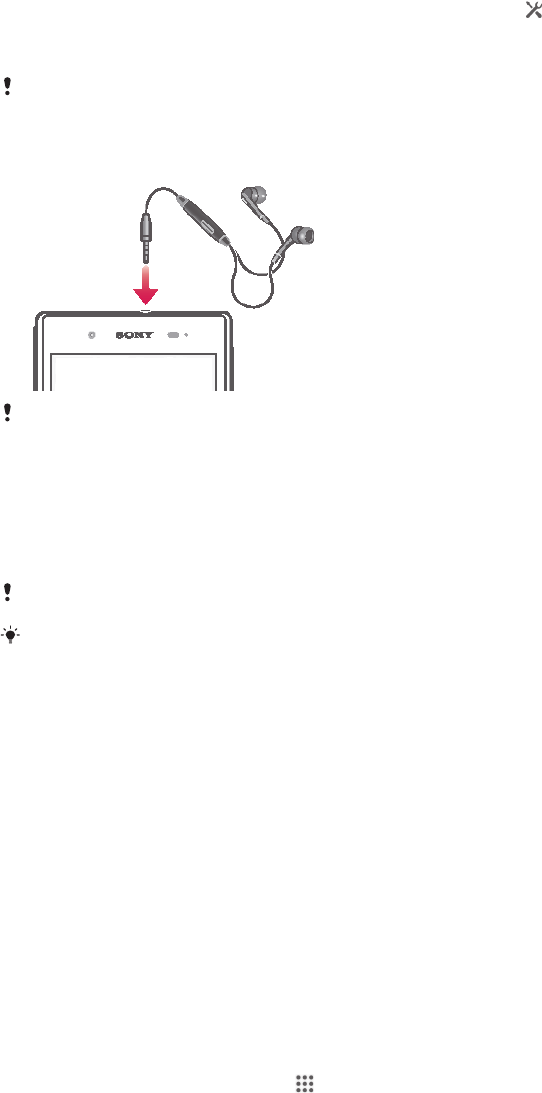
To mirror the screen of your device on a TV screen
1TV: Follow the instructions in the User guide for your TV to turn on the screen
mirroring function.
2Your device: Drag the status bar downwards, then tap .
3Find and tap Xperia™ Connectivity > Screen mirroring.
4Tap Turn on Screen mirroring and select a device.
When using screen mirroring, do not cover the Wi-Fi antenna area of your device.
Using a headset
Use the accessories provided with your device, or other compatible accessories, for optimal
performance.
To use a headset
1Connect the headset to your device.
2To answer a call, press the call handling key.
3To end the call, press the call handling key.
If a headset is not included with the device, you may purchase one separately.
If you are listening to music, the music stops when you answer a call and resumes after you
end the call.
Smart Connect
Use the Smart Connect application to set what happens in your device when you
connect or disconnect an accessory. You can also use Smart Connect to set a
specific action or a group of actions to launch on your device at certain times of the
day.
For example, when you connect your headset, you can create an event so that the
following actions are launched on your device:
•Between 7am and 9am, when you commute to work, the "WALKMAN" application
starts, and the web browser opens the morning paper. The ring volume is set to
vibrate.
•On the way back from work, the FM radio starts, and a notes app opens showing
your shopping list.
To start the Smart Connect application
1From your Home screen, tap .
2Find and tap Smart Connect.
99
This is an Internet version of this publication. © Print only for private use.

To create a Smart Connect event
1Start the Smart Connection application. If you are opening Smart Connect for
the first time, tap OK to close the introduction screen.
2On the Events tab, tap .
3Give the event a name, then tap Create.
4Under When, add either an accessory or a time interval, or both.
5Under Do this, add what you want to happen in your device.
6Under At the end, add what you want to happen when you disconnect the
accessory or when the time interval comes to an end. If both these conditions
are set, the actions start either when you disconnect the accessory, or when
the time interval comes to an end.
7To save the event, press .
To add a Bluetooth® accessory, you have to first pair it with your device.
To edit a Smart Connect event
1Start the Smart Connection application.
2On the Events tab, tap an event.
3If the event is switched off, drag the slider to the right.
4Adjust the settings as desired.
5To save the event, tap .
To delete an incorrect entry, touch and hold the entry, then tap > Delete event and tap
Delete to confirm.
Managing devices
Use the Smart Connect application to manage a range of smart accessories that you
can connect to your device, including SmartTags, SmartWatch and Smart Wireless
Headset pro from Sony. Smart Connect downloads any necessary applications and
also finds third-party applications, when available. Previously connected devices
show in a list that allows you to get more information about the features of each
device.
To pair and connect an accessory
1Start the Smart Connection application. If you are opening Smart Connect for
the first time, tap OK to close the introduction screen.
2Tap Devices, then tap .
3Tap OK to start searching for devices.
4In the search result list, tap the name of the device that you want to add.
To adjust the settings for a connected accessory
1Pair and connect the accessory with your device.
2Start the Smart Connection application.
3Tap Devices, then tap the name of the connected accessory.
4Adjust the desired settings.
100
This is an Internet version of this publication. © Print only for private use.

Synchronising data on your device
About synchronising data on your device
You can sync contacts, email, calendar events, and other information with your
device from multiple email accounts, synchronisation services and other kinds of
accounts, depending on the applications installed on your device. Synchronising your
device with other information sources is an easy and practical way to stay up to date.
You can synchronise data automatically by activating the auto-sync function.
To active the auto-sync function
1Drag the status bar downwards, then tap .
2Drag the slider beside Auto-sync to the right.
Synchronising with Google™ services
Synchronise your device with different Google™ services to keep your information up
to date, regardless of which device you're using your Google™ account from. For
example, you can synchronise your contacts, Gmail™ and calendar data.
To set up a Google™ account for synchronisation
1From your Home screen, tap .
2Tap Settings > Add account > Google.
3Follow the registration wizard to create a Google™ account, or sign in if you
already have an account.
4Tap your newly created Google™ account, then tap the items that you want to
synchronise.
To synchronise manually with your Google™ account
1From the Home screen, tap .
2Tap Settings > Google.
3Tap the Google™ account that you want to synchronise.
4Press , then tap Sync now.
To synchronise an application with a Google™ account
1From your Home screen, tap .
2Tap Settings > Google.
3Tap the Google™ account that you want to synchronise with. A list appears of
applications that can be synchronised with the Google account.
4Tap the application that you want to synchronise with the selected Google
account.
To synchronise the web browser data
1From your Home screen, tap .
2Tap Settings > Google.
3Tap the Google™ account that you want to synchronise with, then tap Sync
Browser.
To remove a Google™ account
1From your Home screen, tap .
2Tap Settings > Google.
3Tap the Google™ account that you want to remove from the accounts list.
4Press , then tap Remove account.
5Tap Remove account again to confirm.
Synchronising with Microsoft® Exchange ActiveSync®
Using a Microsoft Exchange ActiveSync account, you can access your corporate
email messages, calendar appointments and contacts directly on your device. After
101
This is an Internet version of this publication. © Print only for private use.

setup, you can find your information in the Email, Calendar and Contacts
applications.
To set up corporate email, calendar and contacts for synchronisation
1From your Home screen, tap .
2Tap Settings > Add account > Exchange ActiveSync.
3Enter your corporate email address and password.
4Tap Next. Your device begins to retrieve your account information. If a failure
occurs, contact your corporate network administrator for more information,
then enter the domain and server details for your account manually.
5Tap OK to allow your corporate server to control your device.
6Select what data you want to sync with your device, such as contacts and
calendar entries.
7If desired, activate the device administrator to allow your corporate server to
control certain security features on your device. For example, you can allow
your corporate server to set password rules and set storage encryption.
8When the setup is done, enter a name for the corporate account.
To edit the setup of corporate email, calendar and contacts
1From your Home screen, tap .
2Tap Email, then tap .
3Tap Settings and select a corporate account.
4Change the desired settings.
To set a synchronisation interval for a corporate account
1From your Home screen, tap .
2Tap Email, then tap .
3Tap Settings and select a corporate account.
4Tap Check frequency and select an interval option.
To remove a corporate account
1From your Home screen, tap .
2Tap Settings > Exchange ActiveSync, then select the corporate account.
3Tap , then tap Remove account.
4Tap Remove account again to confirm.
Synchronising with Facebook™
There are two ways to use Facebook™ on your device. You can use the standard
Facebook application to access your online Facebook account, or you can
synchronise your Facebook account with your device and share content between
Facebook™ and a range of other applications. For example, you can share music in
the "WALKMAN" application on your device via Facebook. To synchronise your
device with Facebook, you must first set up an "Xperia™ with Facebook" account.
To set up an "Xperia™ with Facebook" account on your device
1From your Home screen, tap .
2Tap Settings > Add account > Xperia™ with Facebook.
3Follow the on-screen instructions to sign in to your Facebook™ account, or
create a new account.
To synchronise manually with an "Xperia™ with Facebook" account
1From your Home screen, tap .
2Tap Settings > Xperia™ with Facebook.
3Select the account that you want to synchronise.
4Press , then tap Sync now.
To remove an "Xperia™ with Facebook" account
When you remove an "Xperia™ with Facebook" account from your device, the associated
online Facebook account is not deleted and you can still access it from a computer.
102
This is an Internet version of this publication. © Print only for private use.

1From your Home screen, tap .
2Tap Settings > Xperia™ with Facebook.
3Select the account that you want to remove.
4Press , then tap Remove account.
5Tap Remove account again to confirm.
103
This is an Internet version of this publication. © Print only for private use.

Maps and locations
Location services and sources
Use your device to find out where you are. There are two methods, or sources: GPS
satellites and wireless networks. Enable the wireless networks option (Wi-Fi and
mobile networks) if you only need your approximate location, and want it fast. If you
want a more exact position, and have a clear view of the sky, enable the GPS
satellites option. In situations where the wireless network connection is weak, you
should enable both options to ensure that your location is found. Both options are
activated by default when you enable location services.
Sony does not warrant the accuracy of any location services including but not limited to
navigational services.
To enable location services
1Drag the status bar downwards, then tap .
2Tap Location services.
3Drag the slider beside Access to my location to the right.
4Tap Agree twice to confirm.
When you enable location services, both GPS satellites and Google's location service (Wi-Fi
and mobile networks) get enabled by default. You can disable either option manually.
To allow Google apps to access your location
1Drag the status bar downwards, then tap .
2Tap Google > Location settings.
3Drag the slider beside Let Google apps access your location to the right.
You must be logged into your Google™ account to be able to use location services.
Using GPS
Your device has a GPS (Global Positioning System) receiver that uses satellite signals
to calculate your location. Your device also supports GLONASS (Global Navigation
Satellite System). Both systems can complement and replace each other, if
necessary, to ensure positioning accuracy and a smooth navigation experience.
When you enable GPS, the GLONASS system also gets enabled automatically.
When you use features that require the GPS and GLONASS receiver to find your location,
make sure you have a clear view of the sky.
To enable GPS
1Drag the status bar downwards, then tap .
2Tap Location services.
3Drag the slider beside Access to my location to the right.
4Tap Agree to confirm.
When you enable GPS, the GLONASS system gets enabled automatically.
Getting the best performance
The first time you use the GPS it can take 5 to 10 minutes for your location to be
found. To help the search, make sure you have a clear view of the sky. Stand still and
don't cover the GPS antenna (the highlighted area in the image). The GPS signals can
pass through clouds and plastic, but not through most solid objects such as
buildings and mountains. If your location isn't found after a few minutes, move to
another location.
104
This is an Internet version of this publication. © Print only for private use.

Google Maps™
Use Google Maps™ to track your current location, view real-time traffic situations
and receive detailed directions to your destination. Before taking trips, you can
download and save maps to your memory card to avoid high roaming costs.
The Google Maps™ application requires the use of an Internet connection. You may incur data
connection charges when you connect to the Internet from your device. Contact your network
operator for more information. The Google Maps™ application may not be available in every
market, country or region.
To use Google Maps™
1From your Home screen, tap .
2Find and tap Maps.
If you want to use Google Maps™, you have to enable one of the location methods available
under Settings > Location services.
To learn more about Google Maps™
•When you use Google Maps™, tap , then tap Help.
Viewing your friends’ locations with Google Latitude™
Join Google Latitude™ to view your friends’ locations on maps and share your
location and other information with them.
Getting directions
Use the Google Maps™ application to get directions when you travel by foot, public
transportation, or car. You can add a shortcut to a destination on your Home screen
to get quick directions from wherever you are.
When you view a map, you make an Internet connection, and data is transferred to
your device. So it's a good idea to download and save maps to your device before
you take a trip. This way, you can avoid high roaming costs.
Sony does not warrant the accuracy of any directional services.
Using the Navigation application
Use the Navigation application in your device to get turn-by-turn instructions on how
to get places. The directions are both spoken and displayed on the screen.
The Navigation application may not be available in every market.
105
This is an Internet version of this publication. © Print only for private use.

To start the Navigation application
1From your Home screen, tap .
2Find and tap Navigation.
106
This is an Internet version of this publication. © Print only for private use.

Calendar and alarm clock
Calendar
About the calendar
Your device has a calendar for managing your time schedule. If you have a Google™
account, you can also synchronise your device calendar with your web calendar. See
Synchronising with Microsoft® Exchange ActiveSync®
on page 101.
To set the calendar view
1From your Home screen, tap , then find and tap Calendar.
2Tap the downwards arrow to open the drop down menu, then select an option.
To view multiple calendars
1From your Home screen, tap , then find and tap Calendar.
2Press , then tap My calendars.
3Select the calendars you want to view.
To create a calendar event
1From your Home screen, tap , then tap Calendar.
2Tap .
3If you have synchronised your calendar with one or more accounts, select the
account to which you want to add this event. If you only want to add this event
on your device, tap Device calendar.
4Enter the name, time, location and description for the event.
5Tap More and select a reminder for the event. To add a new reminder for the
event, tap .
6If desired, select another option under Repetition.
7Tap Done.
When the appointment time approaches, your device plays a short sound to remind you. Also,
appears in the status bar.
To view a calendar event
1From your Home screen, tap , then tap Calendar.
2Tap the event you want to view.
To change the calendar settings
1From your Home screen, tap , then tap Calendar.
2Press , then tap Settings.
3Tap the setting you want to change, then edit as desired.
Alarm clock
About the alarm clock
Use your device as an alarm clock and select any sound in your device as your alarm
signal. The alarm does not sound if your device is turned off. But it does sound when
your device is set to silent mode or Airplane mode. If you use one of these modes,
you can keep your device on when you are sleeping and not get woken up by phone
calls.
To open the alarm clock
1From your Home screen, tap .
2Find and tap Alarm & clock.
107
This is an Internet version of this publication. © Print only for private use.

To set a new alarm
1From your Home screen, tap .
2Find and tap Alarm & clock.
3Tap .
4Tap Time and adjust the time by scrolling up and down.
5Tap Set.
6If desired, edit other alarm settings.
7Tap Done.
To edit an existing alarm
1From your Home screen, tap .
2Find and tap Alarm & clock.
3Tap the alarm that you want to edit.
4Tap Time and adjust the time by scrolling up and down.
5Tap Set.
6If desired, edit other alarm settings.
7Tap Done.
The alarm time format displayed is the same as the format you select for your general time
settings, for example, 12-hour or 24-hour.
To deactivate an alarm
1From your Home screen, tap .
2Find and tap Alarm & clock.
3Drag the slider to the left next to the alarm that you want to deactivate.
To activate an existing alarm
1From your Home screen, tap .
2Find and tap Alarm & clock.
3Drag the slider to the right next to the alarm that you want to activate.
To delete an alarm
1From your Home screen, tap .
2Find and tap Alarm & clock.
3Touch and hold the alarm you want to delete.
4Tap Delete alarm, then tap Yes.
To set the ringtone for an alarm
1From your Home screen, tap .
2Find and tap Alarm & clock.
3Tap the alarm you want to edit.
4Tap Alarm sound and select an option, than tap Done.
5Tap Done.
To set a recurring alarm
1From your Home screen, tap .
2Find and tap Alarm & clock.
3Tap the alarm you want to edit.
4Tap Repeat.
5Mark the checkboxes for the desired days, then tap OK.
6Tap Done.
To set the title for an alarm
1From your Home screen, tap .
2Find and tap Alarm & clock.
3Tap the alarm that you want to edit.
4Enter a name for the alarm in the Alarm text field.
5Tap Done.
108
This is an Internet version of this publication. © Print only for private use.

To activate the vibrate function for an alarm
1From your Home screen, tap .
2Find and tap Alarm & clock.
3Tap the alarm you want to edit.
4Mark the Vibrate checkbox.
5Tap Done.
The vibrate feature is enabled by default when you create a new alarm.
To set alarms to sound when the device is in silent mode
1From your Home screen, tap .
2Find and tap Alarm & clock, then tap to select an alarm.
3Mark the Alarm in silent mode checkbox.
4Tap Done.
The alarm in silent mode feature is enabled by default when you create a new alarm.
To snooze an alarm when it sounds
•Tap Snooze - %s min.
To turn off an alarm when it sounds
•Slide to the right.
109
This is an Internet version of this publication. © Print only for private use.

Locking and protecting your device
IMEI number
Every device has a unique IMEI (International Mobile Equipment Identity) number.
You should keep a copy of this number. If your device is stolen, your network
provider can use your IMEI number to stop the device from accessing the network in
your country.
To view your IMEI number in the device
1From your Home screen, tap .
2Find and tap Settings > About phone > Status.
3Scroll to IMEI to view the IMEI number.
SIM card protection
You can lock and unlock each SIM card that you use in your device with a PIN
(Personal Identity Number). When a SIM card is locked, the subscription linked to the
card is protected.
If you enter the PIN incorrectly more times than the maximum number of attempts
allowed, your SIM card will become blocked. You then need to enter your PUK
(Personal Unblocking Key) and a new PIN. Your PIN and PUK are supplied by your
network operator.
To lock a SIM card
1From the Home screen, tap .
2Find and tap Settings > Security > Set up SIM card lock > Lock SIM card.
3Enter the SIM card PIN and tap OK.
To change the SIM card PIN
1From the Home screen, tap .
2Find and tap Settings > Security > Set up SIM card lock.
3Tap Change SIM PIN.
4Enter the old SIM card PIN and tap OK.
5Enter the new SIM card PIN and tap OK.
6Re-type the new SIM card PIN and tap OK.
To change the SIM card PIN2
1From the Home screen, tap .
2Find and tap Settings > Call settings
3Tap Fixed dialling numbers > Change PIN2.
4Enter the old SIM card PIN2 and tap OK.
5Enter the new SIM card PIN2 and tap OK.
6Confirm the new PIN2 and tap OK.
To unlock a locked SIM card
1Enter the PUK code and tap .
2Enter a new PIN code and tap .
3Re-enter the new PIN code and tap .
If you enter an incorrect PUK code too many times, the SIM card becomes locked. If this
happens, contact your service provider to get a new SIM card.
Setting a screen lock
There are several ways to lock the screen on your device. For example, you can use
the Face Unlock feature, which uses a picture of your face to unlock the screen. You
can also set a screen unlock pattern, a number-based PIN lock, or a text-based
password.
110
This is an Internet version of this publication. © Print only for private use.

It is very important that you remember your screen unlock pattern, PIN or password.
If you forget this information, it may not be possible to restore important data such as
contacts and messages. Refer to Sony customer support for more information.
To set up the Face Unlock feature
1From your Home screen, tap > Settings > Security > Screen lock.
2Tap Face Unlock, then follow the instructions in your device to capture your
face.
3After your face is successfully captured, tap Continue.
4Select a backup lock method and follow the instructions in the device to
complete the setup.
The Face Unlock feature is less secure than a screen lock pattern, PIN, or password. Someone
who looks similar to you could unlock your device.
For best results, capture your face in an indoor area that is well lit but not too bright, and hold
the device at eye level.
To unlock the screen using the Face Unlock feature
1Activate the screen.
2Look at your device from the same angle you used to capture your Face
Unlock photo.
If the Face Unlock feature fails to recognise your face, you need to draw the backup pattern
or enter the PIN to unlock the screen.
To disable the Face Unlock protection
1From your Home screen, tap > Settings > Security > Screen lock.
2Draw your backup screen unlock pattern or enter your PIN.
3Tap Swipe.
To create a screen unlock pattern
1Drag the status bar downwards, then tap .
2Tap Security > Screen lock > Pattern.
3Follow the instructions in your device.
To unlock the screen using a screen unlock pattern
1Activate the screen.
2Draw your screen unlock pattern.
If the unlock pattern you draw on the screen is rejected five times in a row, you must wait 30
seconds and then try again.
To change the screen unlock pattern
1From your Home screen, tap .
2Find and tap Settings > Security > Screen lock.
3Draw your screen unlock pattern.
4Tap Pattern.
5Follow the instructions in your device.
To disable the screen unlock pattern
1From your Home screen, tap > Settings > Security > Screen lock.
2Draw the screen unlock pattern.
3Tap Swipe.
111
This is an Internet version of this publication. © Print only for private use.

To create a screen unlock PIN
1From your Home screen, tap > Settings > Security > Screen lock > PIN.
2Enter a numeric PIN.
3If necessary, tap to minimise the keyboard.
4Tap Continue.
5Re-enter and confirm your PIN.
6If necessary, tap to minimise the keyboard.
7Tap OK.
To disable the screen unlock PIN
1From your Home screen, tap > Settings > Security > Screen lock.
2Enter your PIN, then tap Continue.
3Tap Swipe.
To create a screen lock password
1From your Home screen, tap > Settings > Security > Screen lock >
Password.
2Enter a password.
3If necessary, tap to minimise the keyboard.
4Tap Continue.
5Re-enter and confirm your password.
6If necessary, tap to minimise the keyboard.
7Tap OK.
To disable the screen unlock password
1From your Home screen, tap > Settings > Security > Screen lock.
2Enter your password and tap Continue.
3Tap Swipe.
112
This is an Internet version of this publication. © Print only for private use.

Support and maintenance
Updating your device
Update your device to the most recent software version to get optimal performance
and the latest enhancements. You can use the Update center application on your
device to run a wireless update or you can use the PC Companion application on a
computer to run an update using a USB cable connection.
If you update wirelessly, you can use either a mobile network or a Wi-Fi® network
connection. Make sure you back up and save all data stored on your device before
you run an update.
New software releases may not be compatible with all devices. When you run an update using
the Update center application, a data connection is established and related charges may be
incurred. Also, the availability of updates over a mobile network depends on your operator.
Contact your network operator for more information.
Updating your device wirelessly
Use the Update center application to update your device wirelessly. You can
download software updates manually, or you can allow Update service to update
your device automatically whenever downloads become available. When the
automatic update feature is activated, a notification appears in the status bar every
time an update becomes available.
To download software updates manually from Update center
1From your Home screen, tap .
2Find and tap Update Centre.
3Select the desired application or system update and tap , or tap to
download all application updates.
Application updates launch automatically after download. With system updates, install the
update manually after download. Your device will then restart automatically after the
installation is finished. You may incur data connection charges when downloading updates
over mobile networks.
To activate automatic software updates using the Update Center application
1From your Home screen, tap .
2Find and tap Update Centre.
3Press , then tap Settings.
4Mark the Allow automatic downloads checkbox, then tap Agree. Updates are
now downloaded automatically as soon as they become available.
You may incur data connection charges when downloading updates over mobile networks.
To install system updates
1From your Home screen, tap .
2Find and tap Update Centre.
3Select a system update that you want to install, then tap .
Updating your device using a USB cable connection
Some updates are not available for wireless download. Notifications appear in the
status bar to inform you of such updates. To download and run the updates, you
need a USB cable and a computer running the PC Companion application. You can
install PC Companion on the computer using installation files saved on your device,
or you can download the application directly from
www.sonymobile.com/support
.
113
This is an Internet version of this publication. © Print only for private use.

To launch the download of PC Companion using your device
1Connect your device to a computer using a USB cable.
2When prompted, follow the instructions in your device to launch the installation
of PC Companion on the computer.
To download software updates using a USB cable connection
1Install the PC Companion application on the computer you are using, if it is not
already installed.
2Connect your device to the computer using a USB cable.
3Computer: Launch the PC Companion application. After a few moments, PC
Companion detects your device and searches for new software for it.
4Device: When notifications appear in the status bar, follow the on-screen
instructions to carry out the relevant software updates.
To update your device using an Apple® Mac® computer
1Install the Sony™ Bridge for Mac application on the Apple® Mac® computer
that you are using, if it is not already installed.
2Using a USB cable, connect your device to the Apple® Mac® computer.
3Computer: Launch the Sony™ Bridge for Mac application. After a few
moments, the Sony™ Bridge for Mac application detects your device and
searches for new software for it.
4Computer: If a new software update is detected, a popup window appears.
Follow the on-screen instructions to run the relevant software updates.
The Sony™ Bridge for Mac application is downloadable from
www.sonymobile.com/support
.
Finding your device
There are several ways to find and protect your device if you ever lose it. Using the
“my Xperia” service, you can:
•Look for your device on a map.
•Sound an alert which works even if the device is in silent mode.
•Remotely lock the device and display your contact information on it.
•Remotely wipe the internal and external memories on the device as a last resort.
Before using the “my Xperia” service, you must activate it on your device. Once the
service is activated, all you have to do is go to
myxperia.sonymobile.com
and sign in
using the same Google™ account that you have set up on your device.
The “my Xperia” service may not available in all countries/regions.
To activate the “my Xperia” service
1Drag the status bar downwards, then tap .
2Tap Security > MyXperia™ > Activate.
3Mark the checkbox, then tap Accept.
Memory
You can save content to your device's internal storage and to a memory card.
To view the status of your memory
1From your Home screen, tap .
2Find and tap Settings > Storage to view the status of your memory.
Memory card
Your device supports a microSD™ memory card, which is used for storing content.
This type of card can also be used as a portable memory card with other compatible
devices.
You may have to purchase a memory card separately.
114
This is an Internet version of this publication. © Print only for private use.

Safely removing the memory card
You can safely remove the memory card from your device any time when the device
is turned off. If you want to remove the memory card when your device is on, you
must first unmount the memory card before you physically remove it from the device.
This can prevent damaging the memory card or losing data stored on the memory
card.
To unmount the memory card
1From your Home screen, tap .
2Find and tap Settings > Storage > Unmount SD card.
Formatting the memory card
You can format the memory card in your device, for example, to free up memory.
This means that you erase all data on the card.
All content on the memory card gets erased when you format it. Make sure you make backups
of everything you want to save before formatting the memory card. To back up your content,
you can copy it to your computer. For more information, refer to the chapter
Connecting your
device to a computer
on page 95.
To format the memory card
1Drag the status bar downwards, then tap .
2Find and tap Storage > Erase SD card.
3To confirm, tap Erase SD card > Erase everything
Clearing the application memory
You may sometimes need to clear the memory for an application. This might happen
if, for example, the application memory becomes full, or you want to clear scores for
a game. You might also want to delete incoming email, text and multimedia
messages in some applications.
To clear the memory for an application
1Drag the status bar downwards, then tap .
2Find and tap Apps.
3Tap the application for which you want to clear the memory.
4Tap Clear cache.
It is not possible to clear the memory for some applications.
Backup and restore application
Use the Backup and restore application to make backups of content to a memory
card or a USB storage device. Such backups can be used to restore your content
and some settings in cases where your data gets lost or deleted.
Types of content you can back up
Use the Backup and restore application to back up the following types of data:
•Bookmarks
•Call log
•Contacts
•Applications downloaded from Google Play™
•Multimedia messages
•System settings (such as alarms, ringer volume, and language settings)
•Text messages
You may incur additional data transmission charges when you restore applications from
Google Play™.
115
This is an Internet version of this publication. © Print only for private use.

Preparing to use the Backup and restore application
Before backing up your content, you can select the backup destination and the types
of data that you want to back up.
To select the backup destination
1From your Home screen, tap .
2Find and tap Back up & restore.
3Tap Back up.
4Tap the bar under Where to store data.
5Select the destination to which you want to back up your content.
To select the data types to back up
1From your Home screen, tap .
2Find and tap Back up & restore.
3Tap Back up.
4Select the data types that you want to back up.
To back up content
1From your Home screen, tap .
2Find and tap Back up & restore.
3Tap Back up, then tap Back up now.
4Enter a password for the backup, then tap OK.
Restoring backed up content using the Backup and restore
application
When you restore backed up content, you must select a backup record to restore
from. If you have backed up content several times, you may have several backup
records. After you select a backup record, you can then select which types of data to
restore.
To restore content from a backup record
1From your Home screen, tap .
2Find and tap Back up & restore.
3Tap Restore.
4Select the record that you want to restore from, then tap Restore now.
5Enter the password for the backup record, then tap OK.
Remember that any changes you make to your data and settings after you create a backup will
get deleted during a restore procedure.
Managing backup records
You can delete or rename records of the backups that you make using the Backup &
restore function.
To rename a backup record
1From your Home screen, tap .
2Find and tap Back up & restore.
3Press , then tap Manage backup records.
4Select the backup record that you want to rename.
5Tap .
6Enter a new name and tap Rename.
To delete backup records
1From your Home screen, tap .
2Find and tap Back up & restore.
3Press , then tap Manage backup records.
4Select the backup record that you want to delete, or tap if you want to delete
all records.
5Tap > Delete.
116
This is an Internet version of this publication. © Print only for private use.

Resetting and restarting
You can reset your device to its original factory settings, with or without deleting all of
your personal data. This action is sometimes necessary if your device stops
functioning properly. You can also force your device to shut down in situations where
it hangs or won't restart normally. When you restart a device after forcing it to shut
down, no settings or personal data get deleted.
Before you perform a reset, make sure to back up any important data saved on your device.
To perform a factory data reset
To avoid permanent damage to your device, do not restart your device while a reset procedure
is underway.
1Drag the status bar downwards, then tap .
2Find and tap Backup & reset> Factory data reset.
3If you also want to erase data such as pictures and music, which is saved to
your device's internal storage, mark the Erase internal storage checkbox.
4Tap Reset phone.
5To confirm, tap Erase everything.
To force the device to shut down
1Detach the cover of the micro SIM card slot.
2Using the tip of a pen or a similar object, press and hold down the OFF button
until the device shuts down.
Do not use overly sharp objects that could damage the OFF button.
Battery and power management
Your device has an embedded battery. You can keep track of your battery
consumption and see which applications are using most power by checking the
battery usage menu. There are several ways to improve battery performance, for
example, by using STAMINA mode or Low battery mode.
For more information and tips about how to make the battery last longer, go to
www.sonymobile.com/support
.
To check the battery level
1From your Home screen, tap .
2Find and tap Settings > About phone > Status > Battery level.
To access the battery usage menu
1From your Home screen, tap .
2Find and tap Settings > Power management > Battery usage.
Improving battery performance
The following tips can help you improve battery performance:
•Charge your device often. This will not affect the lifetime of the battery.
117
This is an Internet version of this publication. © Print only for private use.

•Downloading data from the Internet is power consuming. When you're not using the
Internet, you can save power by disabling all data connections over mobile networks.
This setting does not prevent your device from transmitting data over other wireless
networks.
•Turn off Bluetooth® and Wi-Fi® connections when you don't need these features.
You can turn them on and off more easily from the Notification panel by dragging
down the status bar.
•Use the STAMINA mode and Low battery mode features to reduce battery
consumption. You can select the power saving mode that best suits the way you use
your device. You can also customise the settings of each power saving mode.
•Set your synchronisation applications (used to synchronise your email, calendar and
contacts) to synchronise manually. You can also synchronise automatically, but
increase the synchronisation intervals.
•Check the battery usage menu in your device to see which applications use the most
power. Your battery consumes more power when you use video and music streaming
applications, such as YouTube™. Some applications downloaded from Google
Play™ may also consume more power.
•Close and exit applications that you are not using.
•Lower the screen display brightness level.
•Turn off your device or activate the Airplane mode setting if you are in an area with
no network coverage. Otherwise, your device repeatedly scans for available
networks, and this consumes power.
•Use a Sony™ original handsfree device to listen to music. Handsfree devices
demand less battery power than your device's own loudspeakers.
•Keep your device in standby whenever possible. Standby time refers to the time
during which your device is connected to the network and is not being used.
•Disable any live wallpaper.
Using STAMINA mode
Activate the STAMINA mode feature to pause your Wi-Fi® connection, data traffic
and several power consuming applications when your screen is inactive. When
STAMINA mode is active, you can still receive phone calls, and text and multimedia
messages. You can also set up an applications list to allow some applications to
keep running when your screen is inactive. Once the screen becomes active again, all
paused functions are resumed.
To activate STAMINA mode
1Drag the status bar downwards, then tap .
2Find and tap Power management.
3Drag the slider beside STAMINA mode to the right, then tap Activate.
appears in the status bar when STAMINA mode is activated.
To deactivate STAMINA mode
1From your Home screen, tap .
2Find and tap Settings > Power management.
3Tap next to STAMINA mode.
To change the settings for STAMINA mode
1From your Home screen, tap .
2Find and tap Settings > Power management.
3To open the settings menu, tap STAMINA mode.
4Add or remove applications, as desired.
5When you're finished, tap Done.
Estimating the standby time of your device
Standby time refers to the amount of time the battery can last when your device is
connected to the network but is not in active use, for example, to receive or make
phone calls. STAMINA mode, when activated, continuously evaluates the remaining
standby time, which can vary depending on how you use your device. STAMINA
mode is more effective in lengthening the standby time if you keep the screen of your
118
This is an Internet version of this publication. © Print only for private use.

device locked. If you rarely lock the screen, you may not see much improvement in
battery performance.
When you use your device for the first time, the estimated standby time may not be accurate
since there is no previous usage history to estimate from.
To view the estimated standby time
1From your Home screen, tap .
2Find and tap Settings > Power management.
Using Low battery mode
You can activate the Low battery mode feature to save power when the battery level
is low. This feature helps you to adjust the settings for screen brightness, data traffic
and the vibrate function so that you can reduce battery consumption.
To activate Low battery mode
1From your Home screen, tap .
2Find and tap Settings > Power management.
3Tap next to Low battery mode, then tap Activate.
To deactivate Low battery mode
1From your Home screen, tap .
2Find and tap Settings > Power management.
3Tap next to Low battery mode.
To change the settings for Low battery mode
1From your Home screen, tap .
2Find and tap Settings > Power management.
3To open the settings menu, tap Low battery mode.
4Adjust the settings as desired.
5When you're finished, tap .
Hearing Aid Compatibility
Your phone is designed for Hearing Aid Compatibility (HAC) and can be used with
hearing aids.
Hearing Aid Settings
You can choose the setting in the phone to match the setting in your hearing aid
before making or receiving calls.
To select a phone setting for HAC
1From the Home screen, tap .
2Find and tap Settings > Call settings.
3Mark the Hearing aids checkbox to turn on hearing aid compatibility.
Hearing Aid Compatibility Information
This phone has been tested and rated for use with hearing aids for some of the
wireless technologies that it uses. However, there may be some newer wireless
technologies used in this phone that have not been tested yet for use with hearing
aids. It is important to try the different features of this phone thoroughly and in
different locations, using your hearing aid or cochlear implant, to determine if you
hear any interfering noise. Consult your service provider or the manufacturer of this
phone for information on hearing aid compatibility. If you have questions about return
or exchange policies, consult your service provider or phone retailer.
FCC Caution: Please notice Sony Mobile did NOT perform the testing of Hearing Aid
Compatibility of VoLTE and VoIP over Wi-Fi for CMRS air interfaces, because the test
instrumentation for it was not readily available at the time testing.
119
This is an Internet version of this publication. © Print only for private use.

Hearing Aid Compatibility Rating
This model handset was designed to comply with the requirements set forth in
Section 20.19 of the Federal Communication Commission's (FCC) rules governing
hearing aid compatibility (HAC), for the reduction of RF interference. The Microphone
(M) rating is defined and labeled on the handset box. Devices meeting HAC
compliance must have a minimum M3 or above as defined by the FCC in accordance
with the latest ANSI Standard C63.19. The (M) rating refers to lower RF emission
levels of the handset. Some hearing aids are also provided an (M) rating, and are
more immune than others to interference. To determine the (M) rating of your hearing
aid, please contact your hearing health professional. More information about digital
wireless devices and hearing aid compatibility can be found at
www.sonyericsson-snc.com
.
Support application
To access the Support application
1From your Application screen, find and tap .
2Find and tap the required support item.
TTY
Your phone can use an optional TTY (teletypewriter) device, for people who are hard
of hearing or have speech impairment. You need to set your phone in TTY mode to
use the TTY device. You may need a cable/adapter to connect your TTY device to
the headset jack on your phone. Refer to your TTY device guide for TTY mode and
usage information.
To set the TTY mode
1From your Home screen, tap .
2Find and tap Settings.
3Tap Call settings > TTY mode.
4Select an option.
Accessories
Whether you want a charger, a fashionable carrying case, a Bluetooth® headset, or
you just want to browse for fun extras, T-Mobile is the place to shop for all your
phone accessories.
To purchase accessories for your phone, visit T-Mobile.com, call 1.800.204.2449, or
visit your nearest T-Mobile store.
Accessory selection subject to change and may vary by location.
Usage info
For quality purposes, Sony Mobile collects anonymous bug reports and statistics
regarding your device. None of the information gathered includes personal data.
To allow the sending of usage info
1Drag the status bar downwards, then tap .
2Find and tap About phone > Usage info settings.
3Mark the Send usage info checkbox if it is not already marked.
4Tap Agree.
Recycling your device
Got an old device lying around the house? Why not recycle it? By doing so, you will
help us reuse its materials and components, and you’ll protect the environment, too!
120
This is an Internet version of this publication. © Print only for private use.
Find out more about the recycling options in your region at
www.sonymobile.com/recycle
.
121
This is an Internet version of this publication. © Print only for private use.

Important information
Important information leaflet
Before you use your device, please read the Important information leaflet provided in
the Setup guide in your device or in the box.
To access the setup guide manually
1From the Home screen, tap .
2Tap Settings > Setup guide.
Limitations to services and features
Some of the services and features described in this User guide are not supported in
all countries/regions or by all networks and/or service providers in all areas. Without
limitation, this applies to the GSM International Emergency Number, 112. Please
contact your network operator or service provider to determine availability of any
specific service or feature and whether additional access or usage fees apply.
Use of certain features and applications described in this guide may require access
to the Internet. You may incur data connection charges when you connect to the
Internet from your device. Contact your wireless service provider for more
information.
Protecting your device from water and dust
To maximise the water resistance of your device, the covers for the micro USB port,
the micro SIM slot and the memory card slot must be firmly closed.
Avoid exposing your device to environments with excessive dust or moisture. Normal
wear and tear along with damage to your device can reduce its ability to resist dust
or moisture. You can use your device in the following conditions:
Swimming pool Diving Shooting photos and
videos under water
You should only use the device up to 30 minutes in water depths of 1.5 metres or less.
Do not use your device in the following conditions:
Salt water Other liquid
chemicals
Sand/mud
If a touch malfunction occurs on the screen of your device, tap in the small application bar
to activate the Touch Blocker function.
Your device is waterproof and dust resistant in compliance with the Ingress
Protection ratings IP55 and IP58 (see details below). Always firmly attach all covers to
ensure the water and dust resistance of the device. If liquid is detected inside the
122
This is an Internet version of this publication. © Print only for private use.

device, for example, underneath one of the covers, your warranty will be void. Never
submerge your device in salt water or let the micro USB port, the micro SIM slot, the
memory card slot or the headset jack come in contact with salt water. Also, never
expose the device to any liquid chemicals, or to moist environments with extreme
high or low temperatures. The waterproof ability of the micro USB port, the micro SIM
slot, the memory card slot and the headset jack is not guaranteed in all environments
or conditions. After using the device in water, dry off the areas around the micro USB
port cover, the micro SIM slot cover, the memory card slot cover and the headset
jack.
If the speaker, microphone or headset jack get wet, dry these areas and wait for three
hours before using them again. You can, however, use other features in the device
that do not utilise the speaker or microphone.
All compatible accessories, including batteries, chargers, handsfree devices and
micro USB cables, are not waterproof and dust resistant on their own.
Your warranty does not cover damage or defects caused by abuse or improper use
of your device. If you have any further questions about the use of your products, refer
to our Customer support service for help.
IP (Ingress Protection) rating
Your device has an IP rating, which means it has undergone certified tests to
measure its resistance levels to both dust and water. The first digit in the two-digit IP
rating indicates the level of protection against solid objects, including dust. The
second digit indicates how resistant the device is to water. The higher the numbers,
the higher the respective protection.
Your device is waterproof and dust resistant in compliance with the Ingress
Protection ratings IP55 and IP58 (see details below). These ratings mean that your
device is dust resistant and is protected against low pressure water stream as well as
against the effects of submersion for 30 minutes in fresh (non-saline) water up to 1.5
metres deep. You can therefore use the device in dusty environments, when your
fingers are wet, and in extreme weather conditions, for example, when it’s snowing or
raining, or when humidity levels are high. See the table below for more details.
Resistance to solid objects and dust Resistance to water
IP0X. No special protection IPX0. No special protection
IP1X. Protected against solid objects > 50 mm in
diameter IPX1. Protected against dripping water
IP2X. Protected against solid objects > 12.5 mm in
diameter IPX2. Protected against dripping water when tilted
up to 15 degrees from normal position
IP3X. Protected against solid objects > 2.5 mm in
diameter IPX3. Protected against spraying water
IP4X. Protected against solid objects > 1 mm in
diameter IPX4. Protected against splashing water
IP5X. Protected against dust; limited ingress (no
harmful deposit) IPX5. Protected against water jet spray
IP6X. Dust tight IPX6. Protected against heavy jet spray
IPX7. Protected against the effects of immersion
IPX8. Protected against submersion
The IPX5 and IPX8 ratings are based on tests lasting 30 minutes in water depths of 1.5 metres.
Go to
www.sonymobile.com/testresults
for more information.
123
This is an Internet version of this publication. © Print only for private use.
Legal information
SonyC6916
This User guide is published by Sony Mobile Communications AB or its local affiliated company, without any
warranty. Improvements and changes to this User guide necessitated by typographical errors, inaccuracies of
current information, or improvements to programs and/or equipment, may be made by Sony Mobile
Communications AB at any time and without notice. Such changes will, however, be incorporated into new
editions of this User guide.
©Sony Mobile Communications AB, 2013.
All rights reserved.
Your mobile device has the capability to download, store and forward additional content, for example,
ringtones. The use of such content may be restricted or prohibited by rights of third parties, including but not
limited to restriction under applicable copyright laws. You, and not Sony, are entirely responsible for additional
content that you download to or forward from your mobile device. Prior to your use of any additional content,
please verify that your intended use is properly licenced or is otherwise authorized. Sony does not guarantee
the accuracy, integrity or quality of any additional content or any other third party content. Under no
circumstances will Sony be liable in any way for your improper use of additional content or other third party
content.
This User guide may reference services or applications provided by third parties. Use of such programming or
services may require separate registration with the third party provider and may be subject to additional terms
of use. For applications accessed on or through a third-party website, please review such websites’ terms of
use and applicable privacy policy in advance. Sony does not warrant or guarantee the availability or
performance of any third-party websites or offered services.
All product and company names mentioned herein are the trademarks or registered trademarks of their
respective owners. Any rights not expressly granted herein are reserved. All other trademarks are property of
their respective owners.
Visit
www.sonymobile.com
for more information.
All illustrations are for illustration purposes only and may not accurately depict the actual device.
This product is protected by certain intellectual property rights of Microsoft. Use or distribution of such
technology outside of this product is prohibited without a licence from Microsoft.
Content owners use Windows Media digital rights management technology (WMDRM) to protect their
intellectual property, including copyrights. This device uses WMDRM software to access WMDRM-protected
content. If the WMDRM software fails to protect the content, content owners may ask Microsoft to revoke the
software's ability to use WMDRM to play or copy protected content. Revocation does not affect unprotected
content. When you download licences for protected content, you agree that Microsoft may include a
revocation list with the licences. Content owners may require you to upgrade WMDRM to access their content.
If you decline an upgrade, you will not be able to access content that requires the upgrade.
This product is licenced under the MPEG-4 visual and AVC patent portfolio licences for the personal and non-
commercial use of a consumer for (i) encoding video in compliance with the MPEG-4 visual standard
("MPEG-4 video") or the AVC standard ("AVC video") and/or (ii) decoding MPEG- 4 or AVC video that was
encoded by a consumer engaged in a personal and non-commercial activity and/or was obtained from a video
provider licenced by MPEG LA to provide MPEG-4 and/or AVC video. No licence is granted or shall be implied
for any other use. Additional information including that relating to promotional, internal and commercial uses
and licensing may be obtained from MPEG LA, L.L.C. See http://www.mpegla.com. MPEG Layer-3 audio
decoding technology licenced from Fraunhofer IIS and Thomson.
SONY MOBILE WILL NOT BE LIABLE FOR ANY LOSS, ERASE AND/OR DATA-OVERWRITING OF PERSONAL
DATA OR FILES STORED ON YOUR PHONE (INCLUDING BUT NOT LIMITED TO CONTACTS, MUSIC
TRACKS AND PICTURES) ARISING OUT OF ANY UPDATE OF YOUR DEVICE BY ANY OF THE METHODS
DESCRIBED IN THIS USER’S GUIDE, AS WELL AS ARISING OUT OF THE USE OF ANY OF THE
INDICATIONS AND TIPS PROVIDED UNDER THE SUBSECTIONS “METHODS FOR TRANSFERRING
CONTACTS” AND “DATA STORAGE” OF THIS DOCUMENT. IN NO EVENT SHALL SONY MOBILE’S OR ITS
SUPPLIERS’ TOTAL LIABILITY TO YOU FOR ANY AND ALL DAMAGES, LOSSES AND CAUSES OF ACTION
(WHETHER IN CONTRACT OR TORT, INCLUDING, BUT NOT LIMITED TO NEGLIGENCE OR OTHERWISE)
EXCEED THE AMOUNT ACTUALLY PAID BY YOU FOR YOUR DEVICE.
124
This is an Internet version of this publication. © Print only for private use.